2024
|
|
2024.07.03.
PUBLICATION — Hryniewicz, K., Birgel, D., Kaim, A., Peckmann, J., Kiel,
S., 2024. Evolutionarily ancient deep-water seep
communities in the Eocene Tethys: examples from Buje
(Croatia). Papers in Palaeontology 10:
e1560. https://doi.org/10.1002/spp2.1560
Faunas
from Eocene deep-sea methane-seep deposits from the
flysch in Buje (Croatia) are described. They are
composed chiefly of chemosymbiotic lucinid and thyasirid bivalves, families
known already from the Cretaceous. Methane-seep
deposits from Buje formed at conditions favourable
also for vesicomyid and bathymodiolins known from
some Eocene to Recent seeps, but these are lacking
at Buje. However, both families occur in a few
equivalent-aged seeps in the Pacific. We hypothesize that
this is due to evolutionary antiquity of the
deep-sea methane-seep faunas in the Tethys Ocean at that time.
|
2024.07.03.
95th PalGes in Warsaw 2024 - Joint Meeting of
the Polish Paleobiologists and the annual meeting
of the Paläontologische Gesellschaft (Palges)

We are
glad to invite you to participate in 95th PalGes
in Warsaw 2024 - Joint Meeting of the Polish
Paleobiologists and the annual meeting of the
Paläontologische Gesellschaft (Palges) on
September 16 to 21, 2024 at the Faculty of
Biology, University of Warsaw. The theme of this
year's conference is "More than extinct species:
the importance of fossil organisms for today's
ecology, evolution and biodiversity conservation
efforts across borders?" The official language of
the meeting is English, however, associated
outreach events are planned in German, English,
and Polish. Within the organizers are: the Faculty
of Biology University of Warsaw, the Faculty of
Geology University of Warsaw, the Institute of
Paleobiology Polish Academy of Sciences, the
Palaeontological Section of the Polish Geological
Society, the Polish Geological Institute –
National Research Institute, and the
Paläontologische Gesellschaft (PalGes).
For more information see: link .
|
2024.07.01.
PUBLICATION — Arnold P., Janiszewska K., Li Q.,
O’Connor J.K., Fostowicz-Frelik Ł. 2024. The
Late Cretaceous eutherian Zalambdalestes
reveals unique axis and complex evolution of the
mammalian neck. Science Bulletin 69:
1767–1775. doi: 10.1016/j.scib.2024.04.027z
 Figure: illustration by Agnieszka
Kapuscinska.
Figure: illustration by Agnieszka
Kapuscinska.
|
2024.07.01.
PUBLICATION — Fang, Y.-W., Wolniewicz, A.S., and Liu, J.
2024. A new species of mixosaurid ichthyosaur from
the Middle Triassic of Luxi County, Yunnan Province,
South China. Acta Palaeontologica Polonica
69(2), 263–280. doi:
https://doi.org/10.4202/app.01133.2024
 Figure: photo author: Ye-wei Fang,
reconstruction author: Nikolay Zverkov.
Figure: photo author: Ye-wei Fang,
reconstruction author: Nikolay Zverkov.
Mixosaurs were a group of ichthyosaurs from the Middle
Triassic.
They were characterized by a streamlined body and
teeth used for crushing shells of marine
invertebrates. Mixosaurs were abundant in the
shallow waters of the Tethys and are known from
hundreds of specimens, but their species diversity is poorly known. A
new paper describes a new species of mixosaur from
Yunnan
Province in southwestern China – Mixosaurus
luxiensis. The discovery allows us to better
understand the anatomical and ecological diversity
of mixosaurs from China and their relationships
with species from Europe.
|
 2024.06.21.
Miniseminar 2024.06.21.
Miniseminar
24th
June 2024 (Monday), 11:00 a.m., Dr Rafał
Piechowski will give a seminar:
"Rekonstrukcja umięśnienia na przykładzie
żółwi.".
|
2024.06.17.
PUBLICATION — Vaga, C.F., Seiblitz, I.G.,
Capel, K., Quattrini, A.M., Stolarski, J., Cairns, S.,
Kitahara, M.V. 2024. Untangling deep-sea corals
systematics: description of a new family,
Stephanocyathidae (Anthozoa, Scleractinia), through
a genomic approach. Zoologica Scripta
53:473-486. doi: 10.1111/zsc.12657
 Figure: Maximum likelihood phylogeny based on
the nuclear data set (upper box) indicating
position of the new family Stephanocyathidae in
comparison to Caryophyllidae sensu stricto.
Lower box: skeletons of selected representatives
of Stephanocyathidae in distal and lateral
views.
Figure: Maximum likelihood phylogeny based on
the nuclear data set (upper box) indicating
position of the new family Stephanocyathidae in
comparison to Caryophyllidae sensu stricto.
Lower box: skeletons of selected representatives
of Stephanocyathidae in distal and lateral
views.
The
paper documents another stage in elucidating the
phylogenetic relationships among traditionally
understood Caryophylliidae, considered until
recently as the most species-rich group of
predominantly deep-water scleractinian corals.
Nuclear and mitochondrial DNA analyses
revealed that the genera Stephanocyathus
and Vaughanella exhibit their own gene transposition and lack
a unique gene rearrangement that is a synapomorphy of the group
containing the type genus Caryophyllia.
Molecular characteristics and macromorphological
features allow to segregate the genera Stephanocyathus,
Vaughanella, and likely Ericiocyathus
into a new family, Stephanocyathidae.
|
2024.06.11.
PUBLICATION — Szczygielski T., Van den
Brandt M. J., Gaetano L., Dróżdż D. 2024. Saurodesmus
robertsoni Seeley 1891—The oldest Scottish
cynodont. PLoS ONE 19 (5): e0303973.
https://doi.org/10.1371/journal.pone.0303973
 Figure: the studied specimen – photograph
(left) and 3D model (middle) – and a
phylogenetic tree of amniotes considered in the
paper indicating the probable position of Saurodesmus
robertsoni (right).
Figure: the studied specimen – photograph
(left) and 3D model (middle) – and a
phylogenetic tree of amniotes considered in the
paper indicating the probable position of Saurodesmus
robertsoni (right).
184
years ago, a small bone was discovered in the Triassic
of Scotland. Even though over
the decades it was examined by some of the most
significant paleontologists of their time, named Saurodesmus
robertsoni, and variably interpreted as a
femur of a turtle, humerus of a crocodile, or a
bone of an animal resembling pareiasaurs or cynognathians, its
systematic identity was never really established.
To finally solve this mystery, the anatomy of amniote
stylopodial bones is
reviewed. The specimen is reassessed as a femur of
a derived (probably tritylodontid) cynodont.
|
2024.05.28.
PUBLICATION — Czernielewski, M., Bącal, P.,
Błażejowski, B. 2024. Fossil
caries in a Pliocene rodent with a plausible
instance of in situ preservation of bacterial
remains.
Acta Palaeontologica Polonica
69 (2): 217–225.
https://doi.org/10.4202/app.01125.2023
At
the site of Węże 2 near Działoszyn in Łódź Voivodeship numerous
remains of mammals and other vertebrates dating
from the Pliocene (over 2.5 million
years ago) were found. A tooth of the dormouse Glis
sackdillingensis is affected by caries that was developing
during the animal’s life. Moreover, examination
of the cavity under a scanning electron microscope
revealed the presence of fossilized
microorganisms similar to modern cariogenic
bacteria. Supposedly the specimen contains signs
of disease together with remains of pathogens responsible for
its development. This is probably the only such
case thus far described in palaeontological
literature.
Figure: fossilized remains of Pliocene
pathogenic bacteria (D–F) were found in a
caries-affected tooth (A–C) of an extinct
rodent.
|
2024.05.21.
PUBLICATION — Rytel A, Böhmer C, Spiekman
SNF, Tałanda M. 2024 Extreme neck elongation evolved
despite strong developmental constraints in bizarre
Triassic reptiles—implications for neck modularity
in archosaurs. Royal Society Open Science.
11:240233. https://doi.org/10.1098/rsos.240233
Triassic
Tanystropheus was characterised by the
most elongate vertebrae among the known animals.
Elongation of the vertebrae of Tanystropheus
was a result of developmental constraints
– difficulties in increasing the number of presacral vertebrae. The
latest research shows that the development of
the long-neck in these reptiles proceeded
differently than in, e.g., dinosaurs, in which new
vertebrae appeared in the posterior part of the
neck. In Tanystropheus
the maximisation of the neck elongation occurred
by "shifting" the dorsal vertebrae into the
cervical region and incorporating them into the
anterior morphological module that included the
longest vertebrae.
|
2024.05.14.
PUBLICATION — Hermanson G., Arnal, F. A. M., Szczygielski T., Evers S.
2024. A systematic comparative description of extant
turtle humeri, with comments on humerus disparity
and evolution based on fossil comparisons. The Anatomical Record.
https://doi.org/10.1002/ar.25450
 Figure: anatomy and evolutionary changes of
the turtle humerus.
Figure: anatomy and evolutionary changes of
the turtle humerus.
Turtles are characterized by
an unusual anatomy of the locomotor apparatus linked
with the development of their shell incorporating modified
elements of the axial skeleton and pectoral
girdle. However, the appendicular skeleton was
never properly documented in representatives of
most turtle groups, and the anatomical terminology used
by various authors was often ambiguous. The aim of
this work is to present the anatomy of the humeri of many extant and
extinct turtle species, to standardize the
nomenclature, and to highlight phylogenetically meaningful
characters.
|
2024.05.13.
PUBLICATION — Czepiński Ł. & Madzia D. 2024. Osteology,
phylogenetic affinities, and palaeobiogeographic
significance of the bizarre ornithischian dinosaur Ajkaceratops
kozmai from the Late Cretaceous European
archipelago. Zoological Journal of the
Linnean Society, zlae048.
https://doi.org/10.1093/zoolinnean/zlae048.
Ajkaceratops
kozmai from the Upper Cretaceous of Hungary was considered the
most significant piece of evidence for the
presence of Ceratopsia (horned
dinosaurs) outside of Asia and North America. A closer
inspection of the material has shown that the
postulated similarities to this group are
largely superficial. The bizarre anatomy of Aikaceratops
makes it a peculiar ornithischian dinosaur
with uncertain affinities. This is a further
evidence of the importance and uniqueness of the
European
dinosaur faunas.
Figure: Life restoration of Ajkaceratops
as an enigmatic ornithischian dinosaur (by
Edyta Felcyn-Kowalska) and the described
fossil material.
|
 2024.05.07.
Seminar 2024.05.07.
Seminar
13th
May 2024 (Monday), 11:00 a.m., prof. Wojciech
Majewski will give a seminar: "Reakcja za
zmiany środowiska i post-industrialna odbudowa
populacji otwornic z fiordów Georgii
Południowej, sub-Antarktyka".
|
2024.04.11.
PUBLICATION — Machalski, M. 2024. Scaphitid
ammonites from the lower Maastrichtian of Nahoryany
(western Ukraine) and discussion on the origin of Hoploscaphites
constrictus. Netherlands Journal of
Geosciences, Volume 103, e6.
https://doi.org/10.1017/njg.2024.2.
 Figure:Evolutionary succession of scaphitid
ammonites against the upper Campanian and
Maastrichtian stratigraphy with geographical and
stratigraphical position of the Nahoryany site.
M – macroconchs (females?), m – microconchs
(males?)
Figure:Evolutionary succession of scaphitid
ammonites against the upper Campanian and
Maastrichtian stratigraphy with geographical and
stratigraphical position of the Nahoryany site.
M – macroconchs (females?), m – microconchs
(males?)
The
lower Maastrichtian (Upper Cretaceous) shallow-marine
deposits exposed at Nahoryany, south of Lviv (western Ukraine), have
been known as a rich source of fossils since 1843.
Today, the quarries do not exist but the fossils
may be studied based on museum collections. The
paper deals with scaphitid ammonites from
Nahoryany on the basis of specimens housed in Lviv and Vienna palaeontological
collections. The evolution, possible sexual
dimorphism, and life habits of these common Late
Cretaceous cephalopods have been
discussed.
|
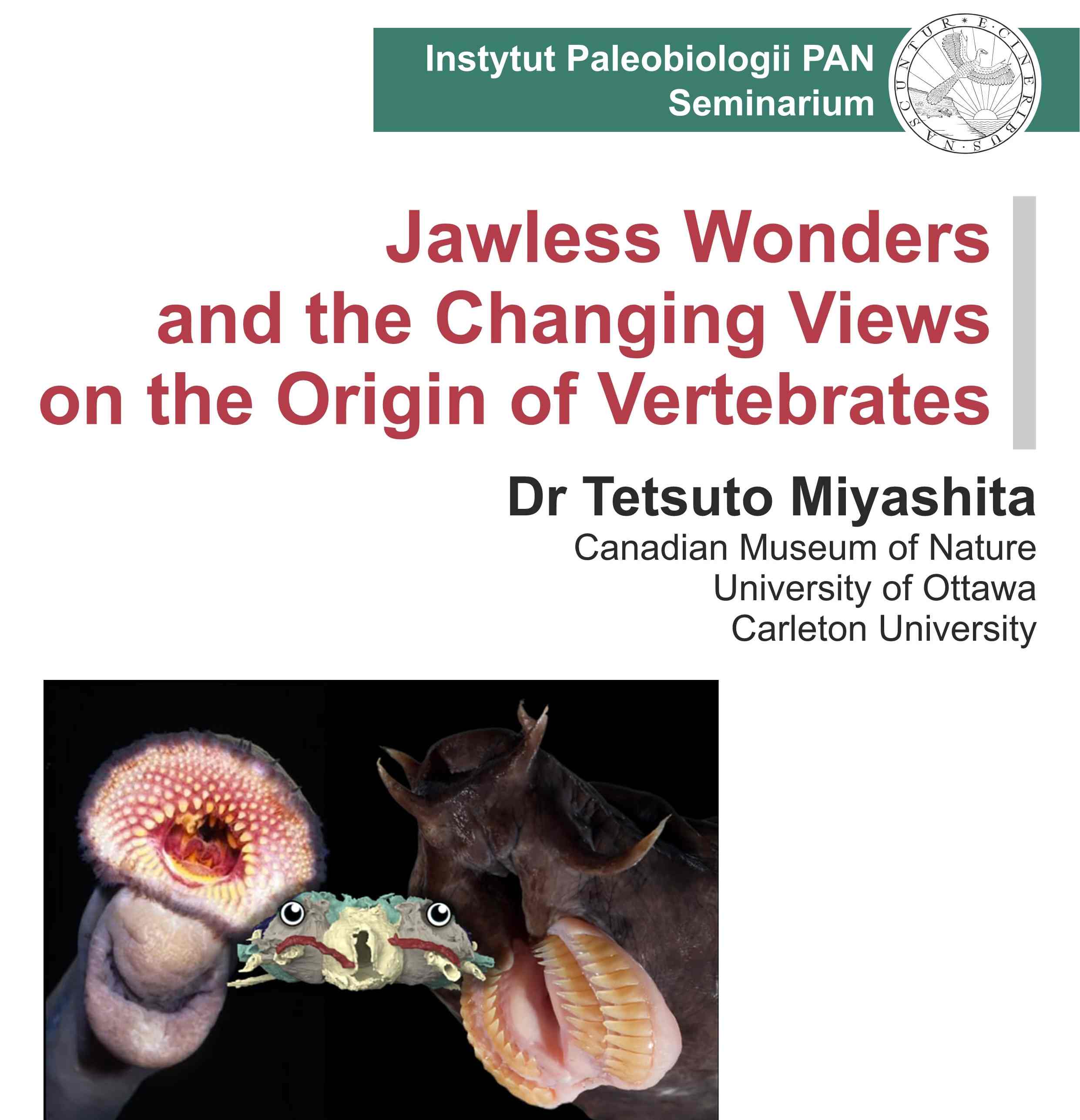 2024.04.18.
Seminar 2024.04.18.
Seminar
24th
April 2024 r (Wednesday), 11:00 a.m., Dr
Tetsuto Miyashita will give a seminar:
"Jawless Wonders and the Changing Views on the
Origin of Vertebrates".
|
2024.04.18.
PUBLICATION — Błażejowski B., Weryński Ł.,
Wierzbowski A., Michalska M., Hryniewicz K., Uchman A.,
Kugler S., Bącal P., Hołda-Michalska A. 2023b.
Summary of a decade of research at the
Owadów–Brzezinki Lagerstätte (Tithonian, central
Poland): A review and perspectives for the future. Volumina
Jurassica, 21, 83–98. DOI:
10.7306/VJ.21.5.
Excavation work underway in the
Owadów–Brzezinki quarry, Student Exploration
Camps. Photo B. Błażejowski 2019.
|
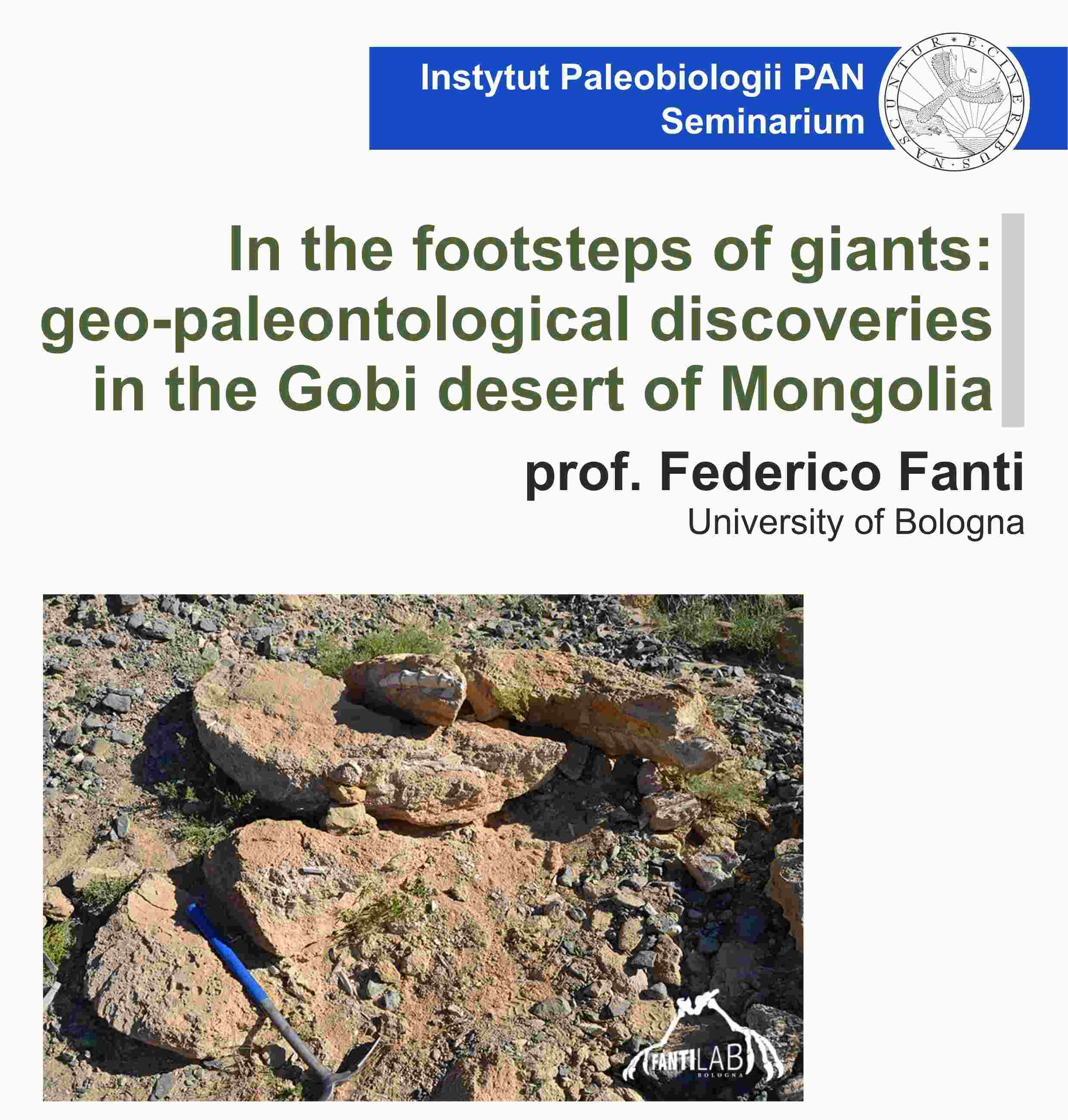 2024.04.16.
Seminar 2024.04.16.
Seminar
22nd
April 2024 r (Monday), 11:00 a.m., prof.
Federico Fanti will give a seminar: "In
the footsteps of giants: geo-paleontological
discoveries in the Gobi desert of Mongolia".
|
2024.04.11.
PUBLICATION — Machalski, M. and Bitner. M. A. 2024. The
brachiopod assemblage from the Maastrichtian white
chalk at Chełm, eastern Poland: stratigraphical and
palaeoecological implications. Netherlands Journal of
Geosciences, Volume 103, e3. doi:
10.1017/njg.2023.15.
 Figure: location of the Chełm site, an
example of a micromorphic brachiopod shell (Terebratulina
longicollis), and the chalk succession
with ranges of identified taxa.
Figure: location of the Chełm site, an
example of a micromorphic brachiopod shell (Terebratulina
longicollis), and the chalk succession
with ranges of identified taxa.
Shells
of small (micromorphic) brachiopods are not so
attractive as other fossils preserved in the white
chalk
facies, for instance the belemnite rostra or echinoid tests. Despite
this, they are important for the Late Cretaceous stratigraphy and
palaeoecology. We describe brachiopods from the
Maastrichtian chalk at Chełm, eastern Poland. The
studied assemblage is dominated by small forms and
allows for precise dating of the succession and
determination of its depositional environment.
|
2024.04.09.
PUBLICATION — Weryński Ł., Błażejowski B., Szczygielski T., Young M.T.
2024. The first occurrence of machimosaurid
crocodylomorphs from the Oxfordian of south-central
Poland provides new insights into the distribution
of macrophagous teleosauroids. PeerJ 12:e17153,
doi:10.7717/peerj.17153.
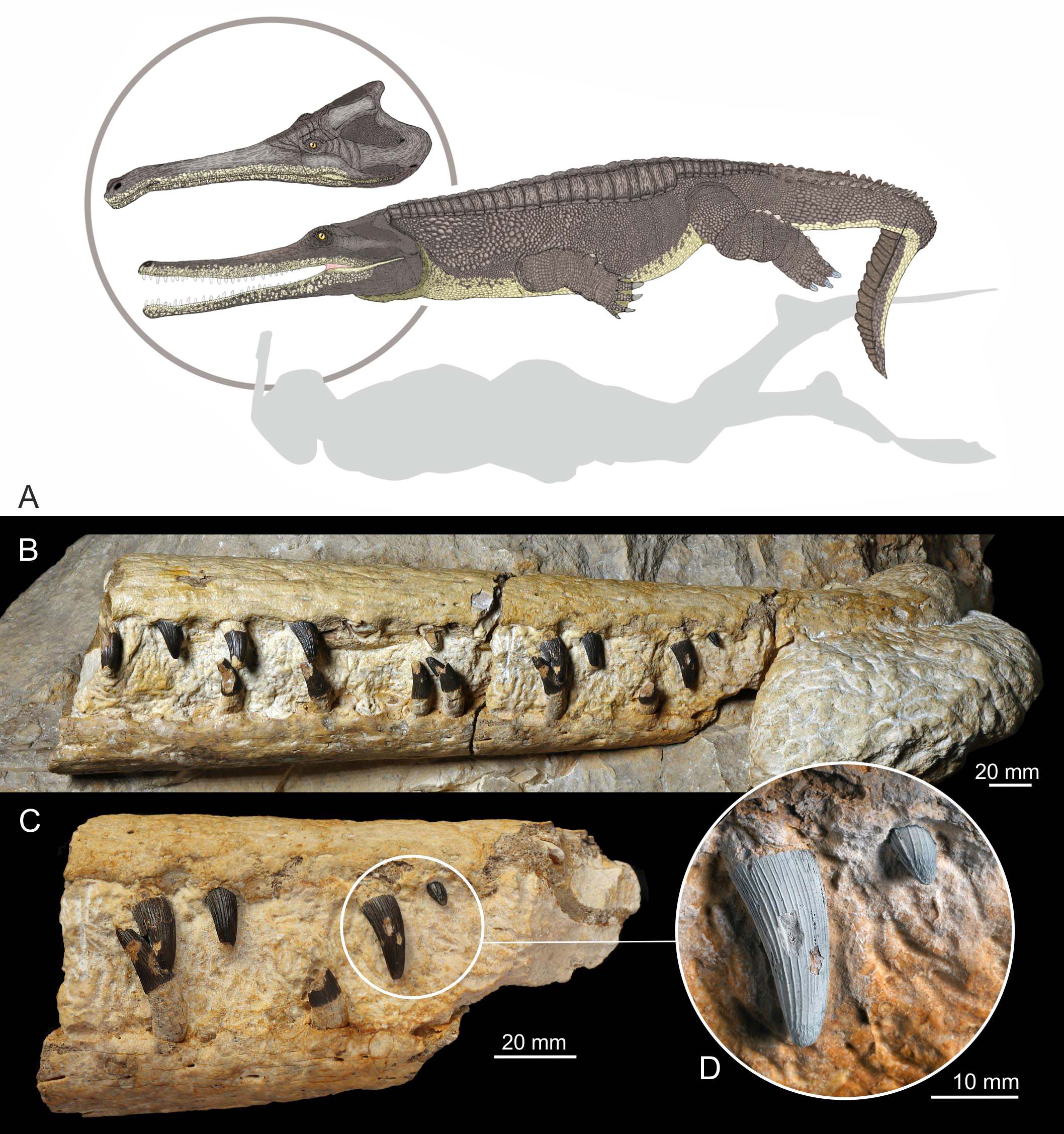 Figure: A. Life reconstruction of the
machimosaurid from south-central Poland by
Stanisław Kugler. Typical specimen (whole body)
and MZ VIII Vr-72 (head reconstruction). B.
Overview of MZ VIII Vr-72 fossil specimen. C. A
photograph of F2 (central part of preserved
rostrum fragment). D. Close up of the teeth
structure, with prominent enamel ornamentation.
Figure: A. Life reconstruction of the
machimosaurid from south-central Poland by
Stanisław Kugler. Typical specimen (whole body)
and MZ VIII Vr-72 (head reconstruction). B.
Overview of MZ VIII Vr-72 fossil specimen. C. A
photograph of F2 (central part of preserved
rostrum fragment). D. Close up of the teeth
structure, with prominent enamel ornamentation.
In the
Jurassic
period, besides the well-known plesiosaurs and
ichthyosaurs, there existed a third group of
widely distributed large predatory marine reptiles
– the Thalattosuchia, popularly
known as "sea crocodiles". A rostrum of a large teleosauroid from the Oxfordian of Załęcze Wielkie was studied.
Mechanical preparation and application of computer
microtomography allowed to interpret this fossil
as a machimosaurid similar to
genera Neosteneosaurus and Proexochokefalos. A pathological
bending of the upper jaw of this individual
occurred most likely during its lifetime.
|
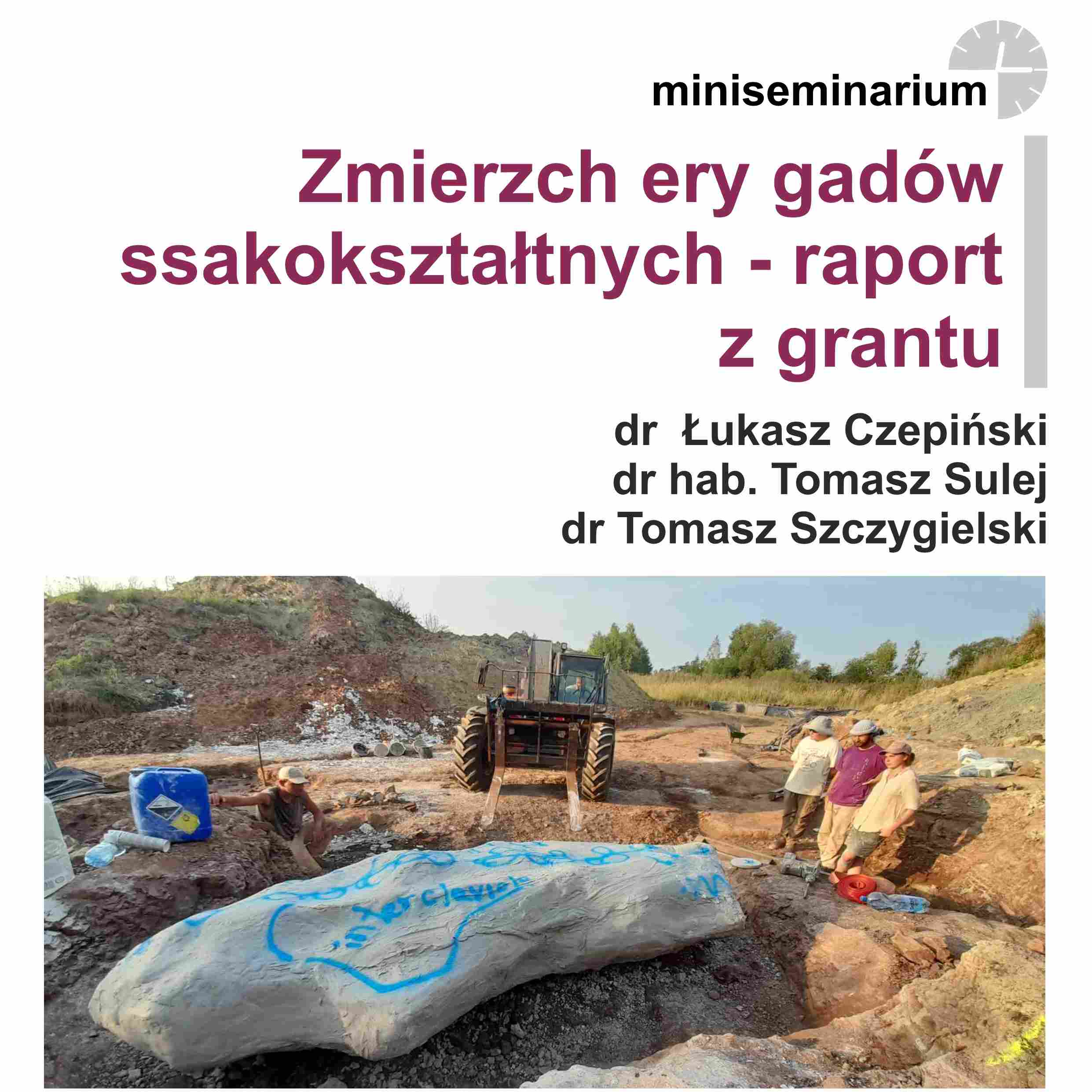 2024.04.08.
Miniseminar 2024.04.08.
Miniseminar
15th
April 2024 r (Monday), 11:00 a.m., dr Łukasz
Czepiński, dr hab. Tomasz Sulej i dr Tomasz
Szczygielski will give a seminar:"Zmierzch
ery gadów ssakokształtnych - raport z grantu".
|
2024.04.05.
PUBLICATION — Canesi, M., Douville, E.,
Montagna, P., Bordier, L., Caquineau, S.,
Pons-Branchu, E., Iwankow, G., Stolarski, J., Allemand, D.,
Planes, S., Moulin, C., Lombard, F., Bourdin, G.,
Troublé, R., Agostini, S., Banaigs, B., Boissin, E.,
Boss, E., Bowler, C., Vargas, C., Flores, M.,
Forcioli, D., Furla, P., Gilson, E., Galand, P.E.,
Pesant, S., Sunagawa, S., Thomas, O., Thurber, R.V.,
Voolstra, C.R., Wincker, P., Zoccola, D., Reynaud,
S. 2024. Sea surface temperature reconstruction in
the Pacific Ocean using multi-elemental proxy in Porites
and Diploastrea corals: Application to Palau
Archipelago. Chemical Geology 645:
121884, doi:10.1016/j.chemgeo.2023.121884.
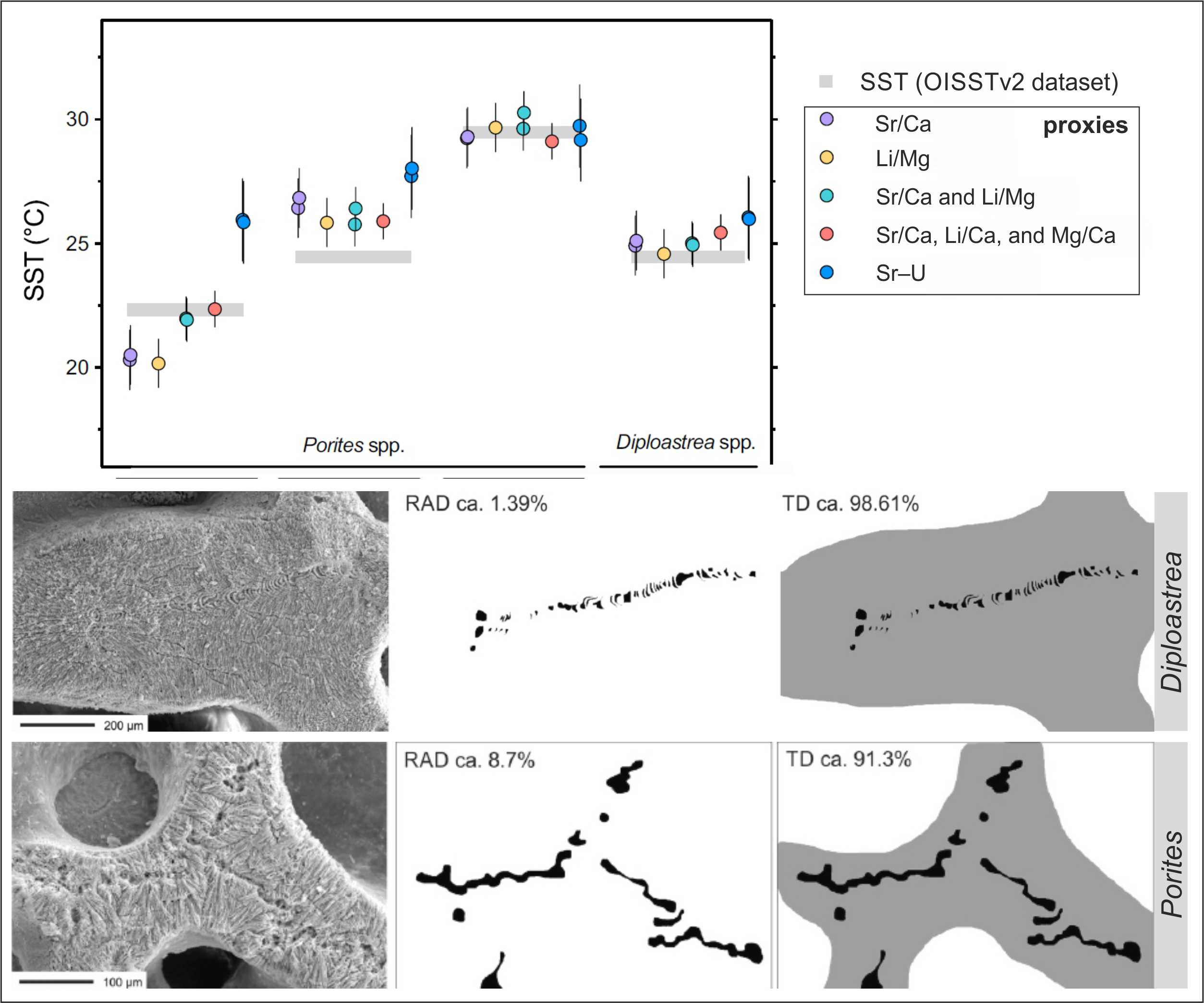 Figure: Reconstruction of sea surface
temperature (SST) based on multi-proxy analysis
of elements in the skeletons of reef corals Porites
and Diploastrea (upper panel), and
differences in ratios between major
microstructural skeletal components (Rapid
Accretion Deposits vs. Thickening Deposits) in Porites
and Diploastrea (lower panel).
Figure: Reconstruction of sea surface
temperature (SST) based on multi-proxy analysis
of elements in the skeletons of reef corals Porites
and Diploastrea (upper panel), and
differences in ratios between major
microstructural skeletal components (Rapid
Accretion Deposits vs. Thickening Deposits) in Porites
and Diploastrea (lower panel).
The
published study offers a comprehensive analysis of
geochemical proxies extracted from reef
coral skeletons ( Porites and Diploastrea)
aimed to reconstruct sea surface temperature
(SST). Employing a multi- element approach (e.g.,
Sr/Ca and Li/Mg) notably reduced uncertainties in
temperature calibration. Discrepancies in SST
reconstructions were more pronounced in Porites
compared to Diploastrea colonies,
attributed to variations in ratios between major
microstructural skeletal components. These ratios
influence the integration of trace elements and reflect
physiological differences between taxa.
|
2024.04.04.
PUBLICATION — Sulej, T., Machalski, M., and Tałanda, M.
2024. New finds of Olenekian, Early Triassic,
trematosaurid amphibians and prolocophonid reptiles
from Poland. Acta Palaeontologica Polonica
69 (1): 49–56. doi:10.4202/app.01109.2023.
 Figure: Vertebrate remains from the Triassic
of Stryczowice: A, Maxilla of a procolophon; B,
Reconstruction of trematosaur parasphenoid; C.
Trematosaur parasphenoid in the sediment.
Figure: Vertebrate remains from the Triassic
of Stryczowice: A, Maxilla of a procolophon; B,
Reconstruction of trematosaur parasphenoid; C.
Trematosaur parasphenoid in the sediment.
Vertebrate
bones are rare in the Lower Triassic deposits of the Holy Cross Mountains. We
describe remains of Early Triassic amphibians ( trematosaurs) and reptiles
(a procolophon, a herbivorous
reptile similar to lizards) from Stryczowice near Ostrowiec
Świętokrzyski. Similar animals are known from the
Triassic of Germany and Russia. Only fragmentary
finds of trematosaurs are known from Poland, but
there is a rich procolophon assemblage from
Czatkowice (a suburb of Krzeszowice near Cracow).
None of the Czatkowice procolophons matches that
from Stryczowice, and there are no trematosaurs at
Czatkowice. This may result from environmental
differences between these sites.
|
2024.04.03.
PUBLICATION — Szczygielski, T., Marchetti,
L., Dróżdż, D. 2024. Natural
external plastron mold of the Triassic turtle Proterochersis:
an unusual mode of preservation. PLoS One 19 (3): e0299314.
doi: 10.1371/journal.pone.0299314.
Natural molds and impressions of invertebrate shells,
devoid of remains of skeletal tissues, are
common fossils. In the case of
large vertebrate bones, such a mode of
preservation is, however, rare. The paper
presents a natural external mold of a turtle plastron from the Triassic Löwenstein
Formation of Germany. The specimen represents an
exceptionally large individual, larger than the
known representatives of Proterochersis robusta
from the same formation and close in size to P.
porebensis from the Grabowa Formation of
Poland. On its surface, impressions of lesions
are present which likely represent traces left
by ectoparasites. Figure:
Plastron
of a middle-sized individual of Proterochersis
robusta (middle) and the described
specimen: natural mold of the external surface
of plastron (right) and virtual positive
(left).
|
2024.03.19.
PUBLICATION — Spiekman, S.N.F., Ezcurra, M.D.,
Rytel, A., Wang W., Mujal, E.,
Buchwitz, M. & Schoch, R.S. 2024. A
redescription of Trachelosaurus fischeri
from the Buntsandstein (Middle Triassic) of
Bernburg, Germany: the first European Dinocephalosaurus-like
marine reptile and its systematic implications for
long-necked early archosauromorphs. Swiss Journal of Palaeontology
143, 10. doi: 10.1186/s13358-024-00309-6.
The Bernburg quarry ( Saxony-Anhalt, Germany)
is known from amphibian skulls found there. A
single reptile skeleton excavated there was
named Trachelosaurus fischeri over 100
years ago. For many years the specimen was
regarded as intermixed remains of
several different animals. New research
shows that all of these bones come from a
single individual – Trachelosaurus was
simply an animal with a very long backbone, including at
least 48 presacral vertebrae (twice more than
in a human!). Trachelosaurus is the
oldest and the only European member of the
Trachelosauridae – Middle Triassic aquatic
reptiles.
Photo:
Liliana Reinöhl
|
2024.03.05.
PUBLICATION — Sachs, S., Eggmaier, S., Madzia, D. 2024. Exquisite
skeletons of a new transitional plesiosaur fill gap
in the evolutionary history of plesiosauroids. Frontiers in Earth Science
12: 1341470, doi: 10.3389/feart.2024.1341470.
Franconiasaurus
brevispinus is a new early plesiosaur established
based on two three-dimensionally preserved
skeletons from the Lower Jurassic of Germany. It
lived during the late Toarcian (∼175 Mya),
near the onset of an Early–Middle Jurassic
turnover of marine reptiles. Franconiasaurus
displays an intriguing combination of
characters of early and later-diverging
plesiosaurs. Phylogenetic analyses place it as
the sister taxon to Cryptoclidia, bridging
an evolutionary gap between Plesiosaurus-like
forms and microcleidids on the one
hand, and cryptoclidids, leptocleidians, and elasmosaurids on the
other hand.
Reconstruction: Joschua Knüppe
|
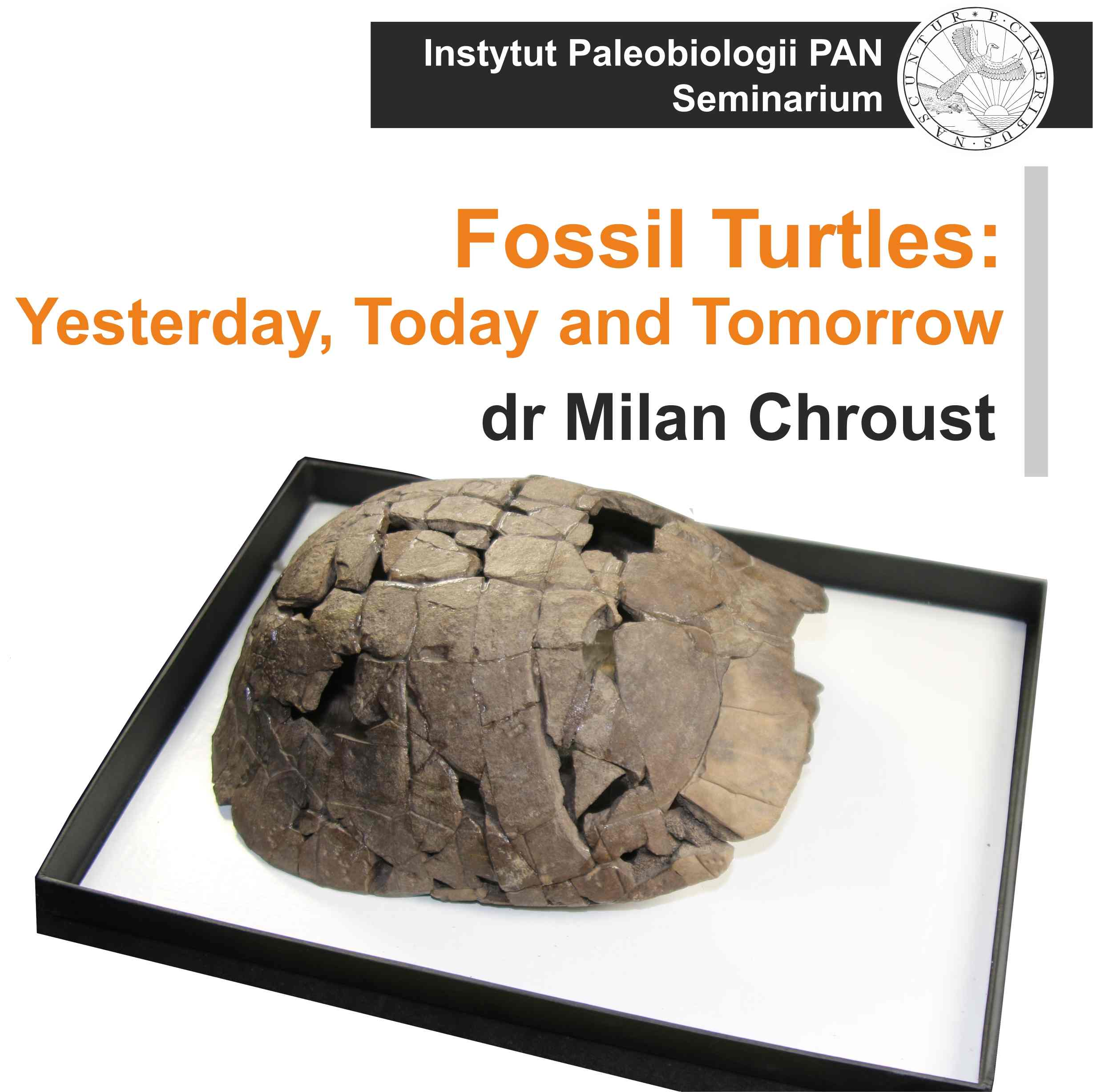 2024.03.04.
Seminar 2024.03.04.
Seminar
11th
March 2024 (Monday), 11:00 a.m., dr Milan
Chroust will give a seminar: "Fossil
Turtles: Yesterday, Today and Tomorrow".
|
2024.02.26.
Selected highlights of 2023
|
2024.02.22.
PUBLICATION — Słowiak J, Brusatte S.L., Szczygielski T. (2024)
Reassessment of the enigmatic Late Cretaceous
theropod dinosaur, Bagaraatan ostromi, Zoological Journal of the
Linnean Society: zlad169, doi:
10.1093/zoolinnean/zlad169.
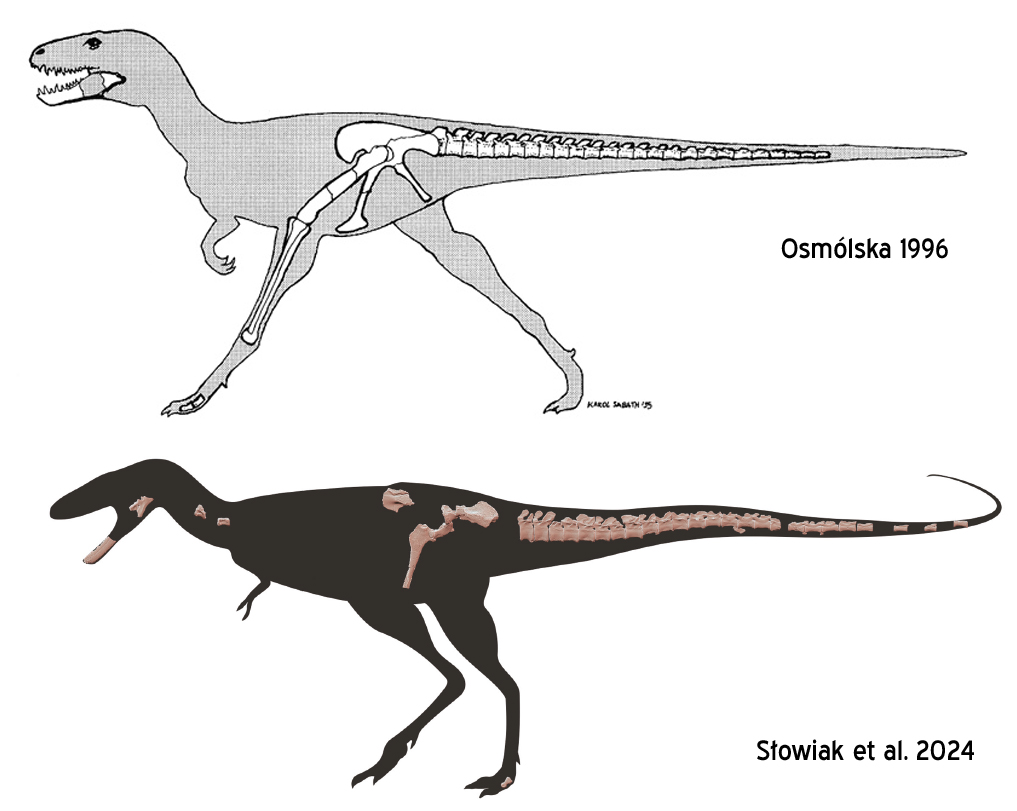 Figure: Above the originally described
skeleton of Bagaraatan, below the recent
reconstruction.
Figure: Above the originally described
skeleton of Bagaraatan, below the recent
reconstruction.
Bagaraatan
ostromi is an enigmatic carnivorous dinosaur
described from the Upper Cretaceous Nemegt Formation in
Mongolia. For more than 30 years its systematic
position remained unresolved. The revision of Bagaraatan
revealed that this genus is a chimaera – its skeleton was initially
reconstructed based on mixed bones of two
different dinosaurs: an oviraptorosaur (cf. Elmisaurus)
and a very young tyrannosaurid. It is still
an open question whether Bagaraatan is in
fact a separate representative of tyrannosaurids
or a juvenile Tarbosaurus or Alioramus.
Bagaraatan is among the smallest juvenile
tyrannosaurids.
|
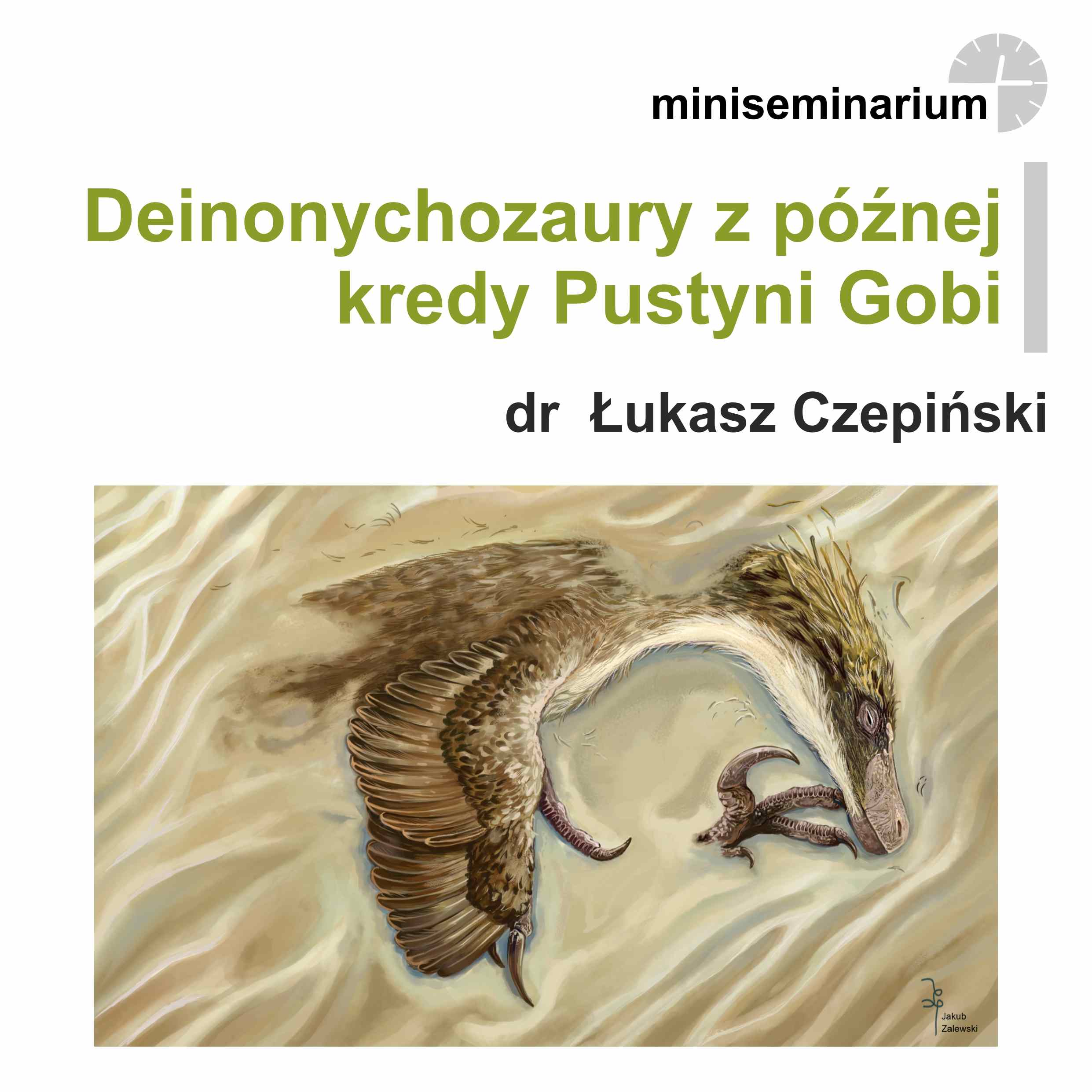 2024.02.20.
Miniseminar 2024.02.20.
Miniseminar
26th
February 2024 (Monday), 11:00 a.m., dr Łukasz
Czepiński will give a seminar: "Deinonychozaury
z późnej kredy Pustyni Gobi".
|
2024.02.14.
PUBLICATION — Kalka, M., Bielak, K., Ptak, M.,
Stolarski, J., Dobryszycki,
P., Wojtas, M. 2024. Calcium carbonate polymorph
selection in fish otoliths: a key role of
phosphorylation of Starmaker-like protein. Acta Biomaterialia 174:
437-446, doi: 10.1016/j.actbio.2023.11.039
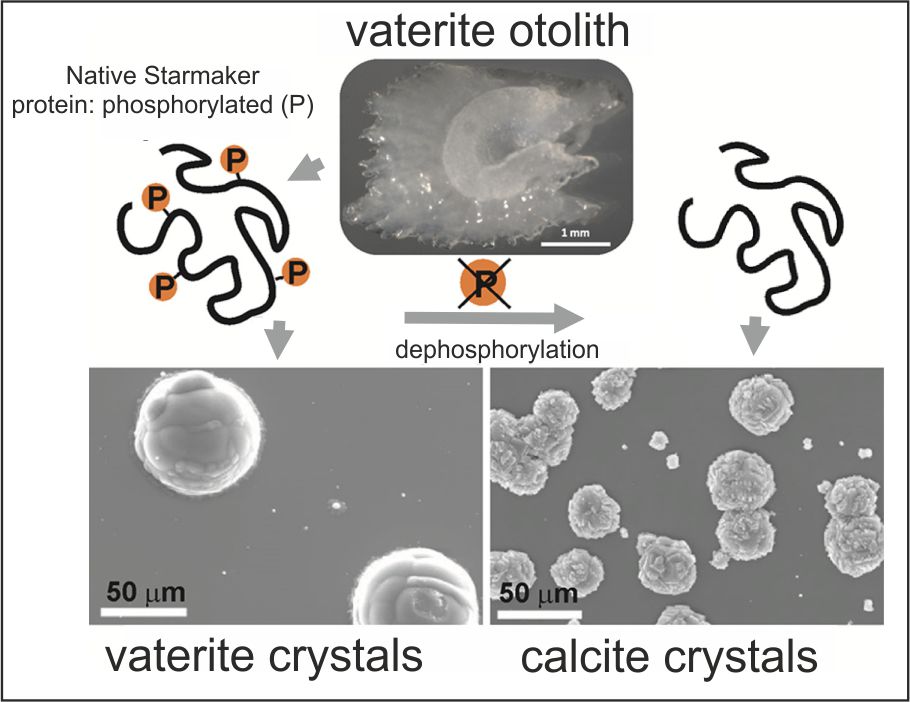
Figure:
An experiment suggesting different
biomineralization activity of a Starmaker-like
protein (from fish otoliths), which
in
its phosphorylated form influences the formation
of vaterite, whereas it promotes the formation
of calcitic calcium carbonate crystals if it is
in a dephosphorylated form.
Many
organisms exhibit astonishing biomineralization
abilities, forming polymorphic minerals from
the same chemical substance. Fish inner ear otoliths consist of calcium
carbonate (CaCO 3) in various
polymorphic forms (e.g., vaterite, aragonite). Proteins are known to be
involved in controlling polymorphic forms, with a
new study suggesting a mechanism involving phosphorylation of a protein
responsible of biomineralisation. Phosphorylation
corresponds to calcium carbonate crystallizing as
vaterite, whereas its absence leads to calcite
precipitation.
|
2024.01.24.
PUBLICATION — Gaaloul, N., Uchman, A., Riahi,
S., Janiszewska, K., Stolarski, J., Kołodziej, B.,
Ben Ali, S. 2023. In vivo and post-mortem bioerosion
traces in solitary corals from the Pliocene of
Tunisia. Acta Palaeontologica Polonica
68:659-681, doi: 10.4202/app.01095.2023.
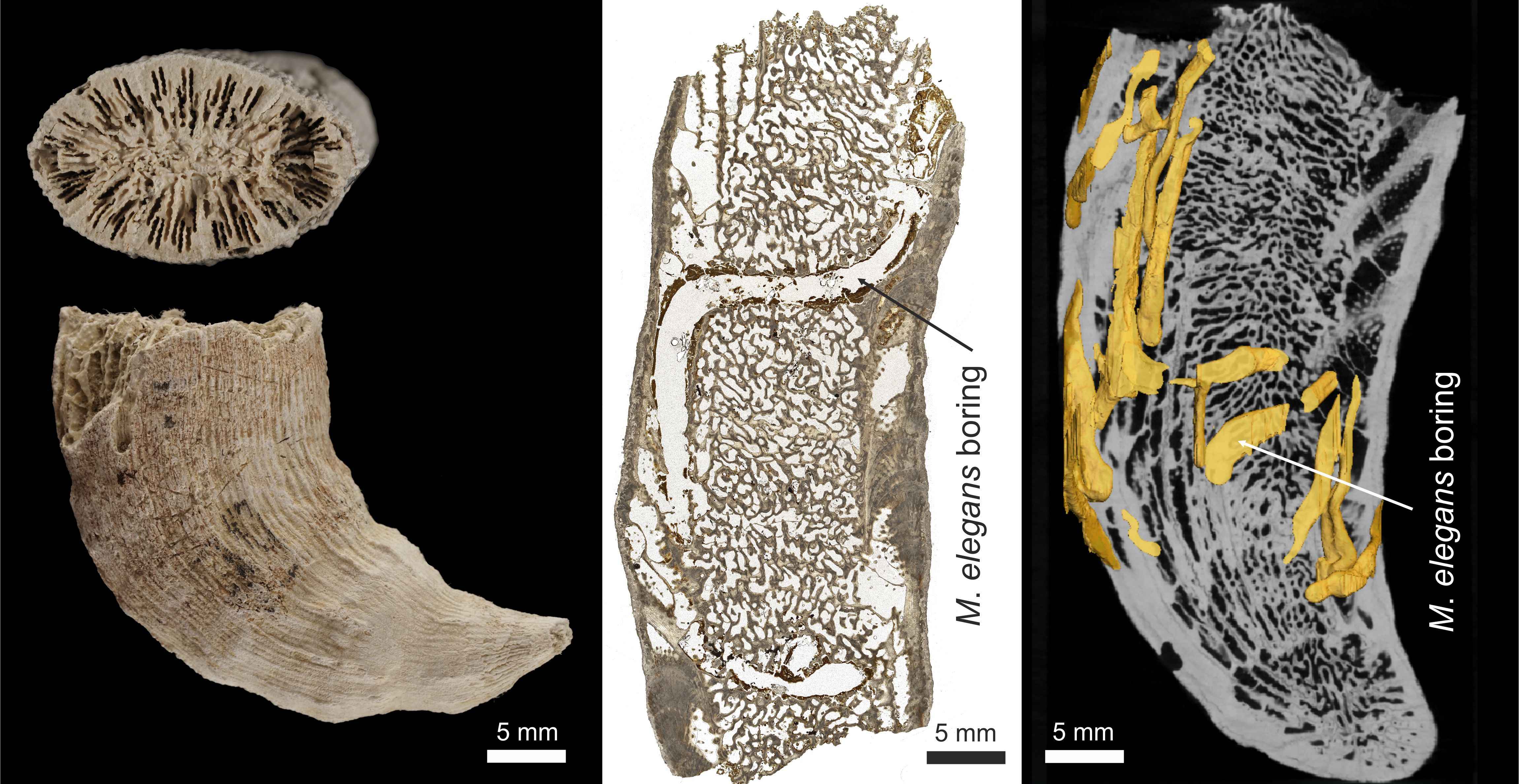 Figure: Corallum of solitary Ceratotrochus
(Edwardsotrochus) duodecimcostatus from
the upper Pliocene of Tunisia (distal and
lateral views); longitudinal thin-section and
virtual (mCT) longitudinal section of the coral
skeleton with probably in-vivo polycha ete
borings (ichnogenus Maeandropolydora).
Figure: Corallum of solitary Ceratotrochus
(Edwardsotrochus) duodecimcostatus from
the upper Pliocene of Tunisia (distal and
lateral views); longitudinal thin-section and
virtual (mCT) longitudinal section of the coral
skeleton with probably in-vivo polycha ete
borings (ichnogenus Maeandropolydora).
One of
the basic taphonomic questions is
whether the borings in skeletal structures were
produced in vivo or post mortem.
Borings influencing the growth of the skeleton
were produced during the life of the animal; the
same for borings that are distributed very close
to the surface of the skeletal structure and are
elsewhere known from deep penetration into the
substrate. Conversely, borings that penetrate
deeply into the skeletal structure and those that
are always close to the surface, irrespective of
the substrate, can be regarded as produced post
mortem. These criteria are used to
distinguish the two categories of polychaete, bryozoan, and phoronid borings made in
coralla of fossil ( Pliocene of Tunisia)
solitary scleractinian coral Ceratotrochus.
|
2023
|
|
|
2023.12.15.
PUBLICATION — Calábková, G., Madzia, D., Nosek, V., and
Ivanov, M. 2023. Tracking ‘transitional’
diadectomorphs in the earliest Permian of equatorial
Pangea. PeerJ 11: e16603.
doi:10.7717/peerj.16603.
Diadectomorpha was a
group of large-bodied herbivorous tetrapods that existed
from the late Carboniferous to the
late Permian. A new trackway
from the Asselian (lowermost Permian) of the Boskovice Basin in the
Czech Republic illustrates a ‘transitional’
stage in the posture evolution of
diadectomorphs, showing track morphologies
possibly attributable to a Diadectes-like
taxon combined with distances between the
successive manus and pes imprints similar to
those observable in earlier-diverging
diadectomorphs, such as Orobates.
Rekonstrukcja:
Petr Modlitba
The
new study adds to the diversity of the ichnological record of
Permian tetrapods in the Boskovice Basin which
had been poorly explored until very recently.
|
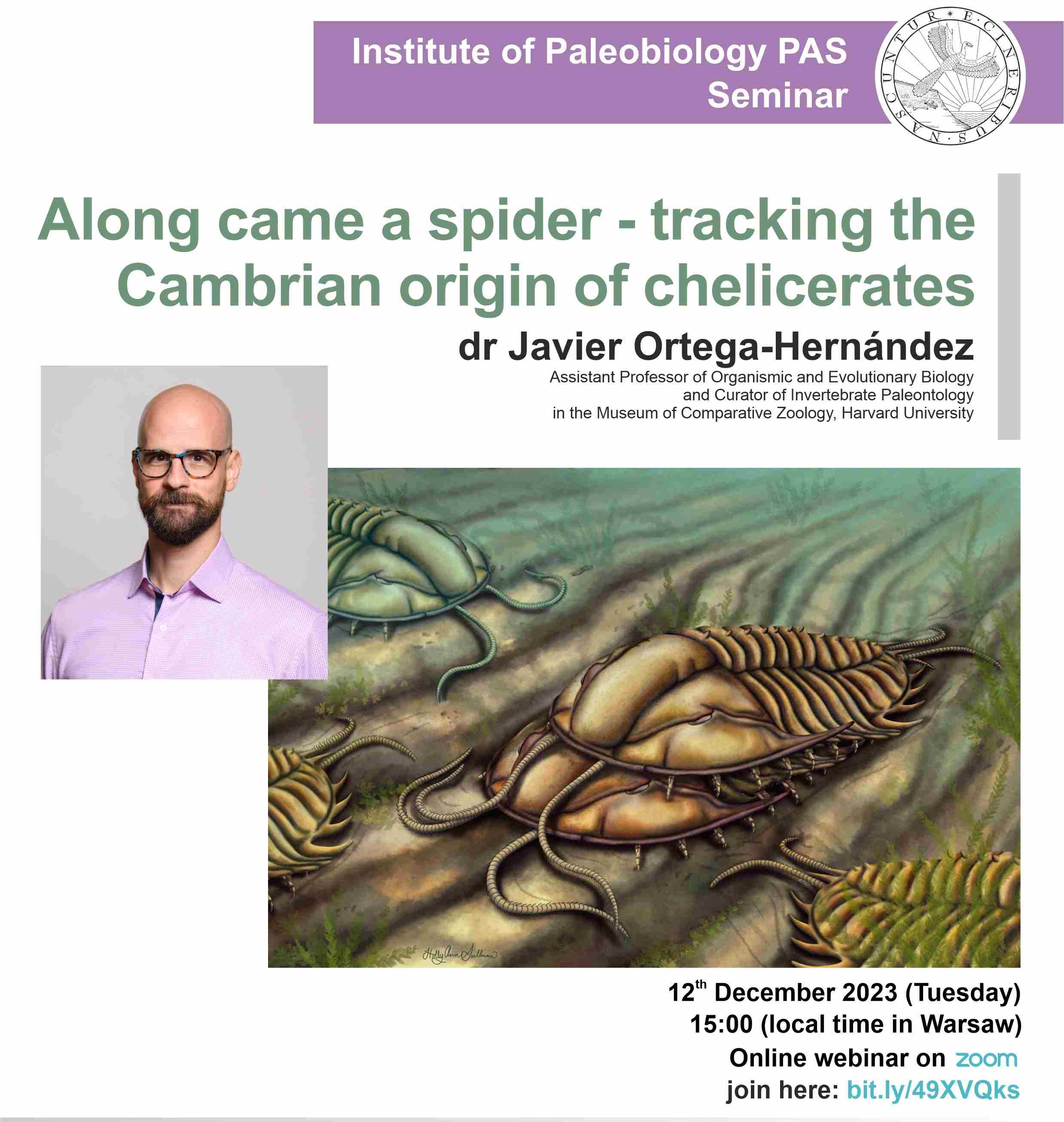 2023.12.06.
Seminar 2023.12.06.
Seminar
12th
December 2023 (Tuesday), 15:00 (local time in
Warsaw),
dr Javier Ortega-Hernández will give a
seminar: "Along came a spider -
tracking the Cambrian origin of chelicerates".
|
2023.12.05.
PUBLICATION — Czepiński, Ł., Pawlak, W., Rytel, A., Tałanda, M., Szczygielski, T., & Sulej, T. (2023) A new Middle
Triassic vertebrate assemblage from Miedary
(southern Poland). Journal of Vertebrate
Paleontology. doi:
10.1080/02724634.2023.2265445.
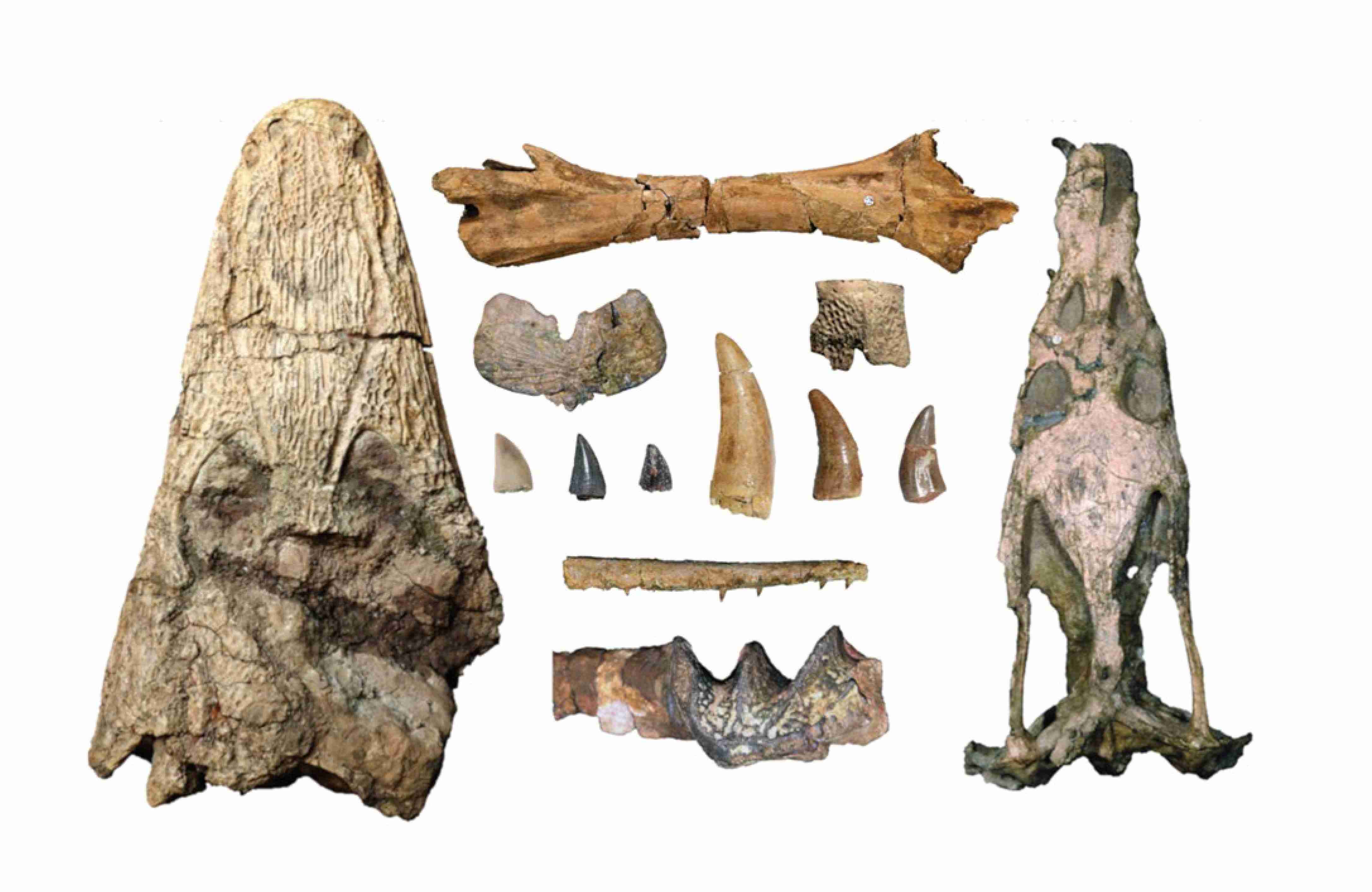 Figure: Vertebrate remains from the Middle
Triassic of Miedary, Poland.
Figure: Vertebrate remains from the Middle
Triassic of Miedary, Poland.
A new,
rich vertebrate assemblage was discovered in the
Middle Triassic strata of Miedary in southern Poland.
More than 20 vertebrate taxa have been identified
here, including a dozen fishes, several amphibians
and reptiles (e.g., Nothosaurus and a
hitherto unknown taxon of armoured archosauromorph). The most
surprising is the overabundance of Tanystropheus, the
mysterious long-necked reptile – over half a
thousand bones of this animal account for more
than a half of all the macrofossils identified so
far at the site. This makes the Miedary assemblage
the richest source of three-dimensionally
preserved Tanystropheus material in the
world.
|
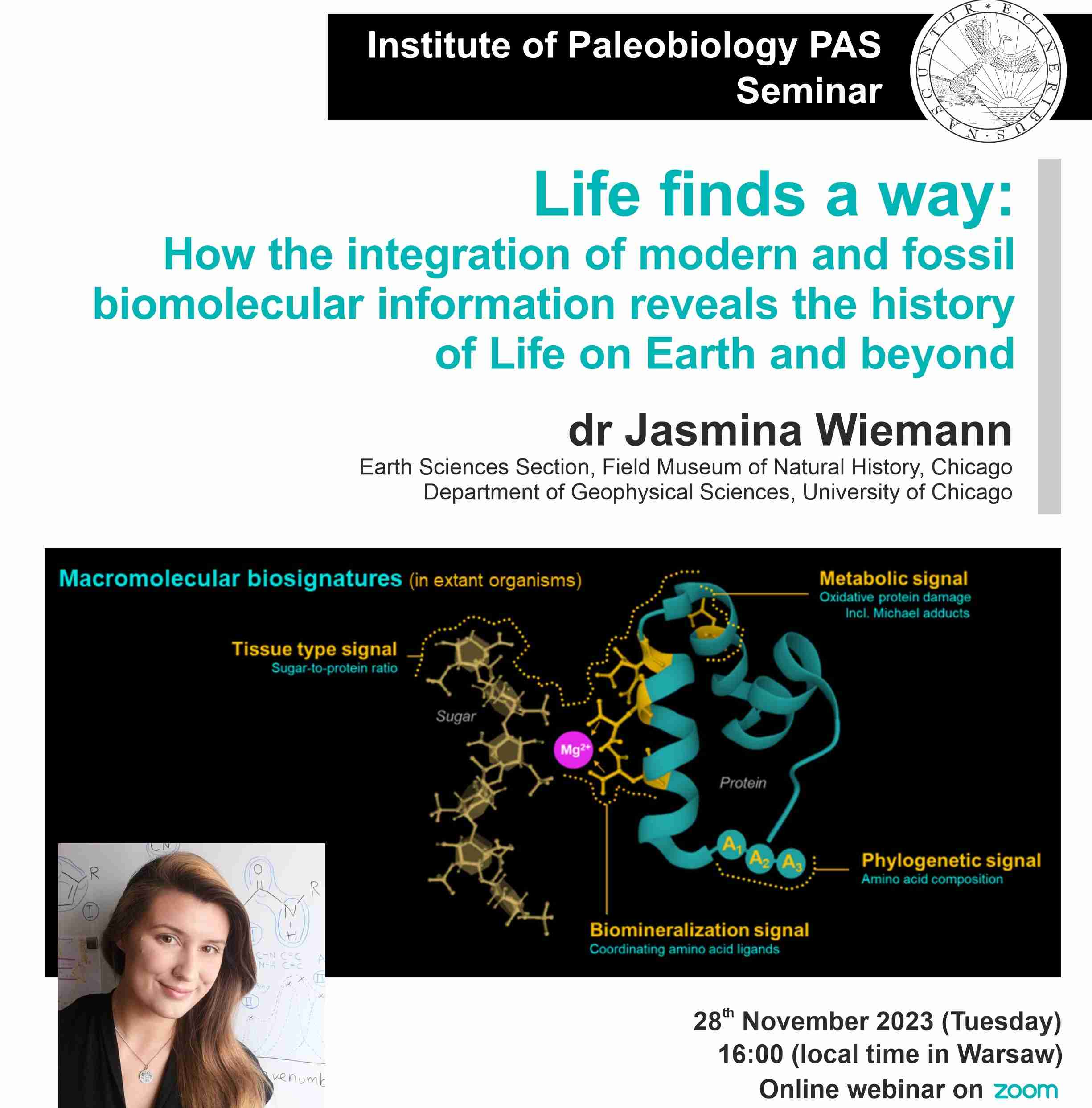 2023.11.29.
Seminar 2023.11.29.
Seminar
28th
November 2023 r. (Tuesday), 16:00 p.m. (local time
in Warsaw) dr Jasmina Wiemann gave a
seminar: "Life finds a way: How the
integration of modern and fossil biomolecular
information reveals the history of Life on
Earth and beyond".
|
2023.11.21. PUBLICATION —
Desatnik R., Patterson Z.J., Gorzelak P., Zamora S., LeDuc
P., and Majidi C., 2023. Soft robotics informs how
an early echinoderm moved. PNAS 2023, Vol. 120, No.
46, e2306580120. doi:10.1073/pnas.2306580120.
The mode of locomotion of one of the earliest
free-living stalked echinoderms – Ordovician Pleurocystites
belonging to the subphylum Blastozoa – was
reconstructed. This was done by constructing a soft robot. For its
construction, a 3D printed replica of these
fossils was used, in which flexible artificial
contractile fibers, resembling the muscles of
living organisms, were embedded. The results of
this research, published and highlighted by
the editors of PNAS, show that similar
robots inspired by organisms extinct millions of
years ago can provide unique insights into their
evolution and way of life, as well as find
engineering applications, contributing to the
development of a new research sub-discipline –
palaeobionics.
|
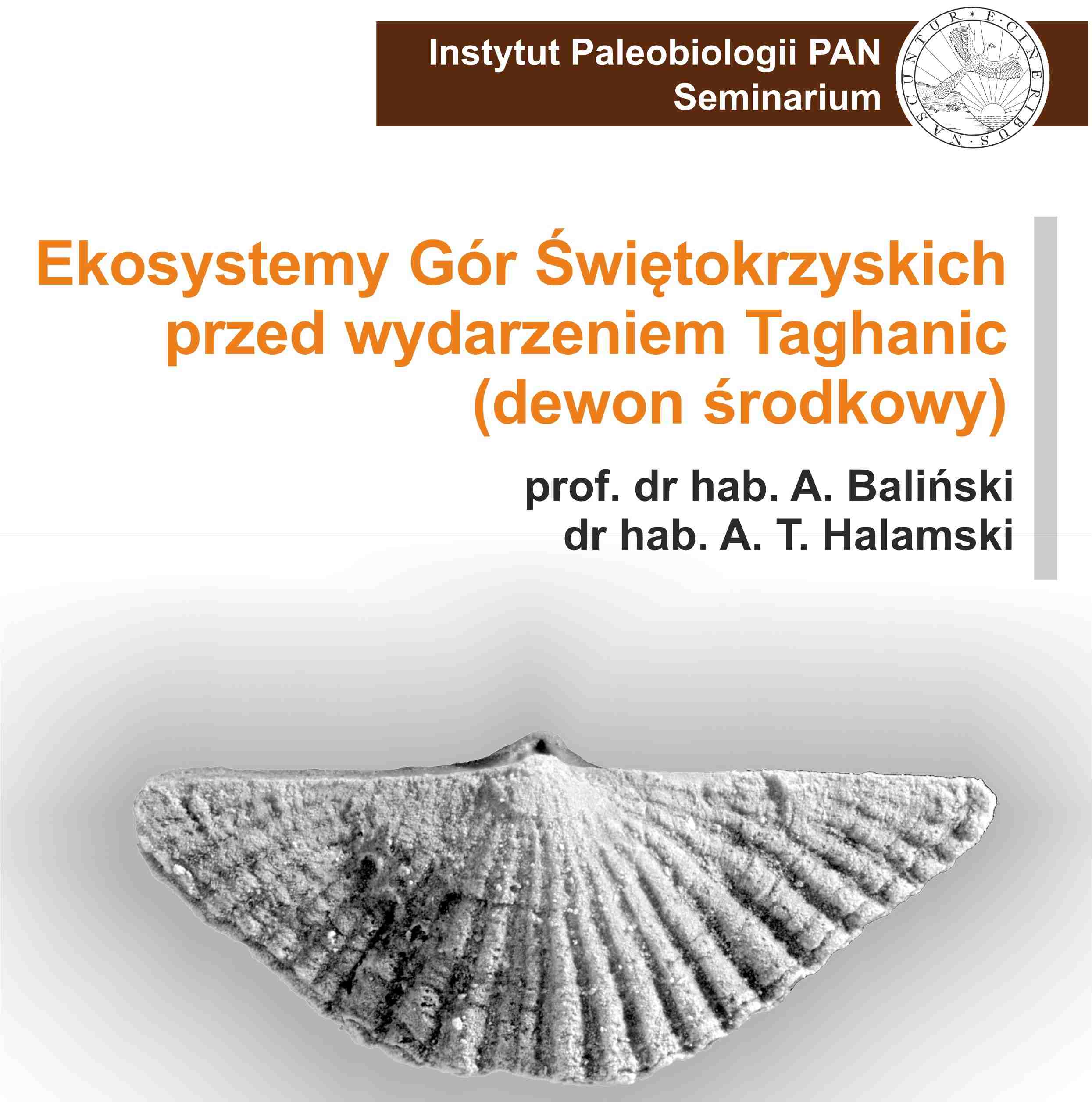 2023.11.21.
Seminar 2023.11.21.
Seminar
24th
November 2023 r. (Friday), 11:00 a.m. (local time
in Warsaw), Prof. dr hab. Andrzej Baliński i
dr hab. Adam T. Halamski will give a
seminar: "Ekosystemy Gór
Świętokrzyskich przed wydarzeniem Taghanic
(dewon środkowy)".
|
|
2023.11.20. PUBLICATION
— Łukowiak M, Meiro G, Peña B,
Villanueva Guimerans P, Corbí H. 2023. Miocene
sponge assemblages in the face of the Messinian
Salinity Crisis—new data from the
Atlanto-Mediterranean seaway. PeerJ 11:e16277.
doi:10.7717/peerj.16277.
During the Miocene salinity crisis,
changing environmental conditions, including a
sharp reduction in water exchange between the
Mediterranean and the Atlantic Ocean, changed
the geographic ranges of many organisms. We
investigated loose Miocene sponge spicules from a
population then inhabiting the strait between
the Mediterranean and the Atlantic Ocean. From
the 18 recognized species, at least 8 still
inhabit the area and others are recorded from
closely located areas. Some have their closest
relatives in Indo-Pacific waters and Japan
today, the range of some populations may have
shrunk after the closure of the Mediterranean
Sea, with some sponge species surviving only
in refugia.
|
2023.11.17.
PUBLICATION — Szczygielski T., Klein N., Słowiak-Morkovina J., Scheyer
T. M. 2023. Limb histology of the Triassic stem
turtles Proterochersis porebensis
Szczygielski & Sulej, 2016 and Proganochelys
quenstedtii Baur, 1887 with insights into
growth patterns of early turtles. Comptes Rendus Palevol 22
(32): 635–665.
doi:10.5852/cr-palevol2023v22a32
Turtles have a
characteristic limb bone microstructure:
the poorly vascularized tissue grows slowly
throughout most of their life; in addition, there
is no medullary cavity. This
structural pattern is well documented in extant
species but fossil turtles are poorly studied in
that context. The authors present the bone
microstructure of two of the oldest ( Triassic, ca. 215-210 Myr)
turtles. The typical features of the bone tissue
appeared very early in the evolution of these
animals. Moreover, divergent growth strategies
were already present at the time – the growth
tempo differed particularly at a young age, so
various species attained comparable body sizes at
different stages of life.
|
2023.11.17. PUBLICATION
— Szczygielski T., Piechowski R.
2023. Limb anatomy of the Triassic turtles:
appendicular osteology of Proterochersis
(Testudinata, Proterochersidae). Zoological Journal of the
Linnean Society 199: 771-831.
doi:10.1093/zoolinnean/zlad057
The paper deals with the anatomy of limbs and associated skeletal structures in
the Triassic (c.a. 215 Myr)
turtles belonging to the
genus Proterochersis
known from the territory of modern-day Germany
and Poland. The material includes specimens
coming from individuals of varied age. The
observed changes occurring during growth
suggest that adult individuals may have had a
more terrestrial mode of life than juveniles.
This is the first study of the limb anatomy in Proterochersis,
which represents the most ancestral group of
turtles.
|
2023.11.08. PUBLICATION
— Binczewska A., Majewski W., Wachnicka A.,
Frankovich T., Borówka R.K., Sławińska J., Bąk M.,
Witkowski A. 2023. Reconstruction of climate-induced
environmental changes in
the eastern Gulf of Mexico based on foraminifera
sediment assemblages. Journal of Sea Research
196: 102451.
Foraminifera
(unicellular protists) from the
Marquesas Keys, located 30 km west of Key West (Florida)
allowed to reconstruct climatic conditions in
this shallow-water carbonate platform for the
last 150 years. Climatic changes were related
with variation in precipitation patterns in
the Gulf of Mexico region
linked with shifts in the major modes of
natural climate variability (like for example
El Niño), along with
tropical storms and hurricanes. Despite a
generally negative impact of the
ocean-atmosphere teleconnections on the South
Florida region, a well-developed assemblage
associated with sea-grass was recorded
in the uppermost part of the record dated to
the period between 1990 and 2010.
Figure: Foraminifera from the Marquesas
Keys, Florida (Foto: Anna Binczewska) .
|
2023.10.31.
PUBLICATION — Sachs, S., Madzia, D., Thuy, B., and
Kear, B.P. 2023. The rise of macropredatory
pliosaurids near the Early-Middle Jurassic
transition. Scientific Reports 13:
17558. doi:10.1038/s41598-023-43015-y
 Reconstruction: Juschua Knüppe
Reconstruction: Juschua Knüppe
Lorrainosaurus
from the Bajocian ( Middle Jurassic) of
France is the earliest large-bodied pliosaurid and the
oldest known representative of a dynasty of
marine reptile mega-predators that ruled the
Mesozoic oceans for around 80 million years.
Its identification demonstrates that these
creatures emerged shortly after a landmark
restructuring of marine ecosystems close to the
Early-to-Middle Jurassic boundary, some 175 to
171 million years ago. This event profoundly
affected many vertebrate groups and brought
pliosaurids to dominance over ‘fish-like’ ichthyosaurs, ancient
marine crocodile relatives, and other
large-bodied predatory plesiosaurs.
|
2023.10.20. PUBLICATION
— Weryński Ł., Błażejowski B., Kędzierski M.
2023. A comparison of teeth in Tithonian, Late
Jurassic, predatory actinopterygian fishes from
Owadów-Brzezinki Lägerstatte and its
palaeoecological implications. Acta Palaeontologica Polonica
68 (3), 493–512, doi:10.4202/app.01058.2023
The paper presents the results of histological
studies of teeth of Late Jurassic fish from Owadów-Brzezinki.
Through observation using optical and electron
microscopy, it was shown that the examined
tooth samples of holosteans ( Strobilodus
sp. belonging to the Amiiformes) and teleost-like fish ( Orthocormus
teyleri belonging to the Pachycormiformes, an
extinct order) possess different internal
structures. The observed microstructural and
morphological features indicate that these
similar-sized fish inhabited different ecological niches.
Figure: Dentary bone of actinopterygian
fish Strobilodus sp. from Owadów-Brzezinki;
reconstruction: Ola Hołda-Michalska &
Marta Szubert.
|
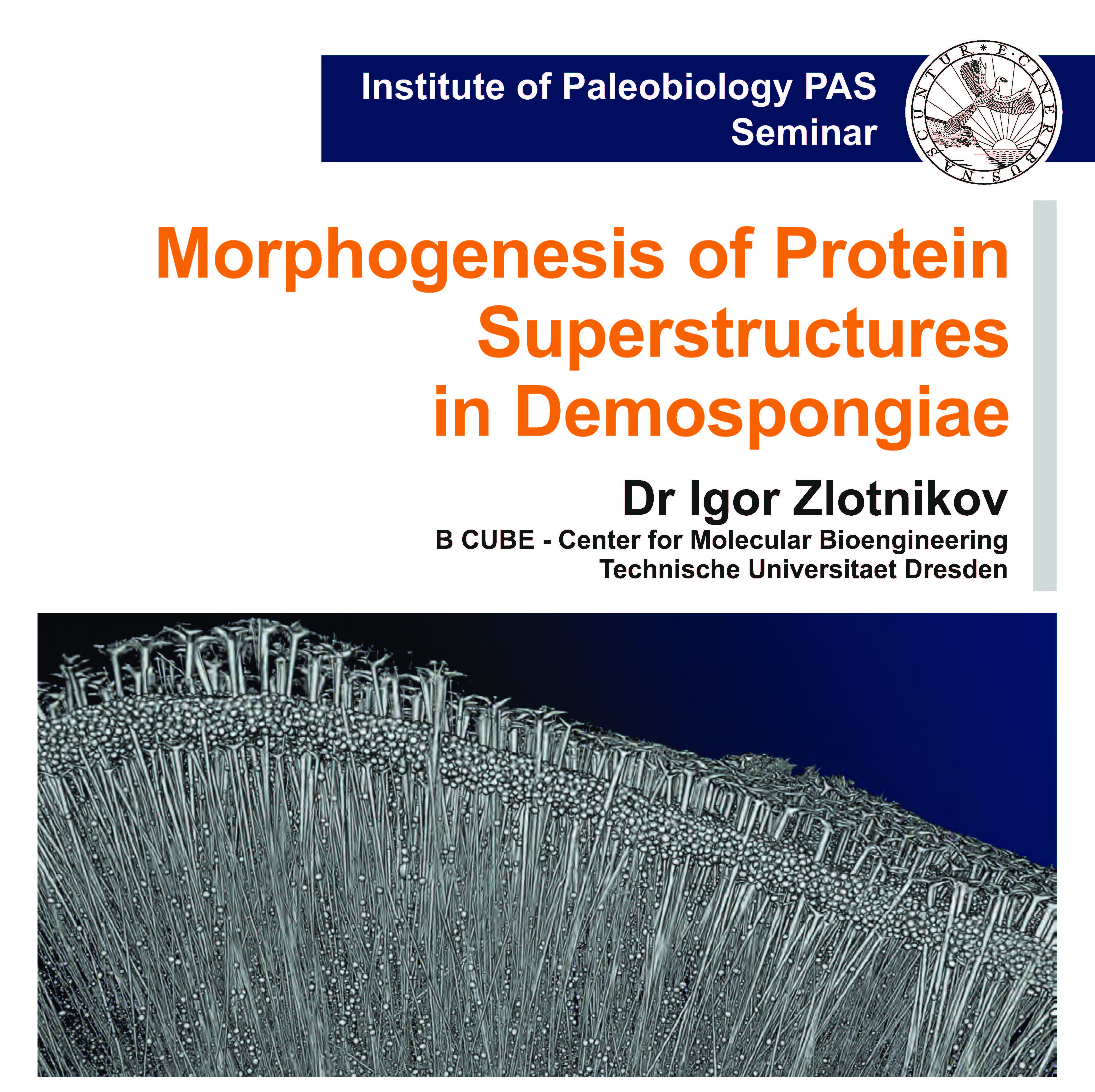 2023.10.16.
Seminar 2023.10.16.
Seminar
23rd
October 2023 (Monday), 11:00 a.m. (local time in
Warsaw),
Dr Igor Zlotnikov will give a seminar:
"Morphogenesis of Protein
Superstructures in Demospongiae".
|
2023.10.13.
HR Excellence in Research
12 October 2023 the Institute of Paleobiology of the
Polish Academy of Sciences was awarded the HR
Excellence in Research logo. This is a prestigious
award aimed at enhancing the attractiveness of
working conditions and career development of
researchers in the European Union. It is awarded to
institutions that provide the best working
conditions for researchers and conduct their
recruitment processes transparently and in
accordance with the guidelines of the European
Charter for Researchers and the Code of Conduct for
the Recruitment of Researchers.
|
2023.10.12.
PUBLICATION — Maletz, J. (Coordinating
author). 2023. Treatise on Invertebrate
Paleontology, Part V, Hemichordata, Second Revision,
Including Enteropneusta, Pterobranchia
(Graptolithina). (authors: D. E. B. Bates, E. Beli,
E. D. Brussa, C. B. Cameron, R. A. Cooper, P.
Gonzalez, A. Kozłowska, A. C. Lenz, D.
K. Loydell, J. Maletz, S. Rigby, J. F. Riva, M.
Steiner, B. A. Toro, A. H. M. VandenBerg, J. A.
Zalasiewicz, Y. D. Zhang). The University of Kansas,
Paleontological Institute, Lawrence, Kansas, U.S.A.
xxx + 548 pp., 310 figs.
|
|
|
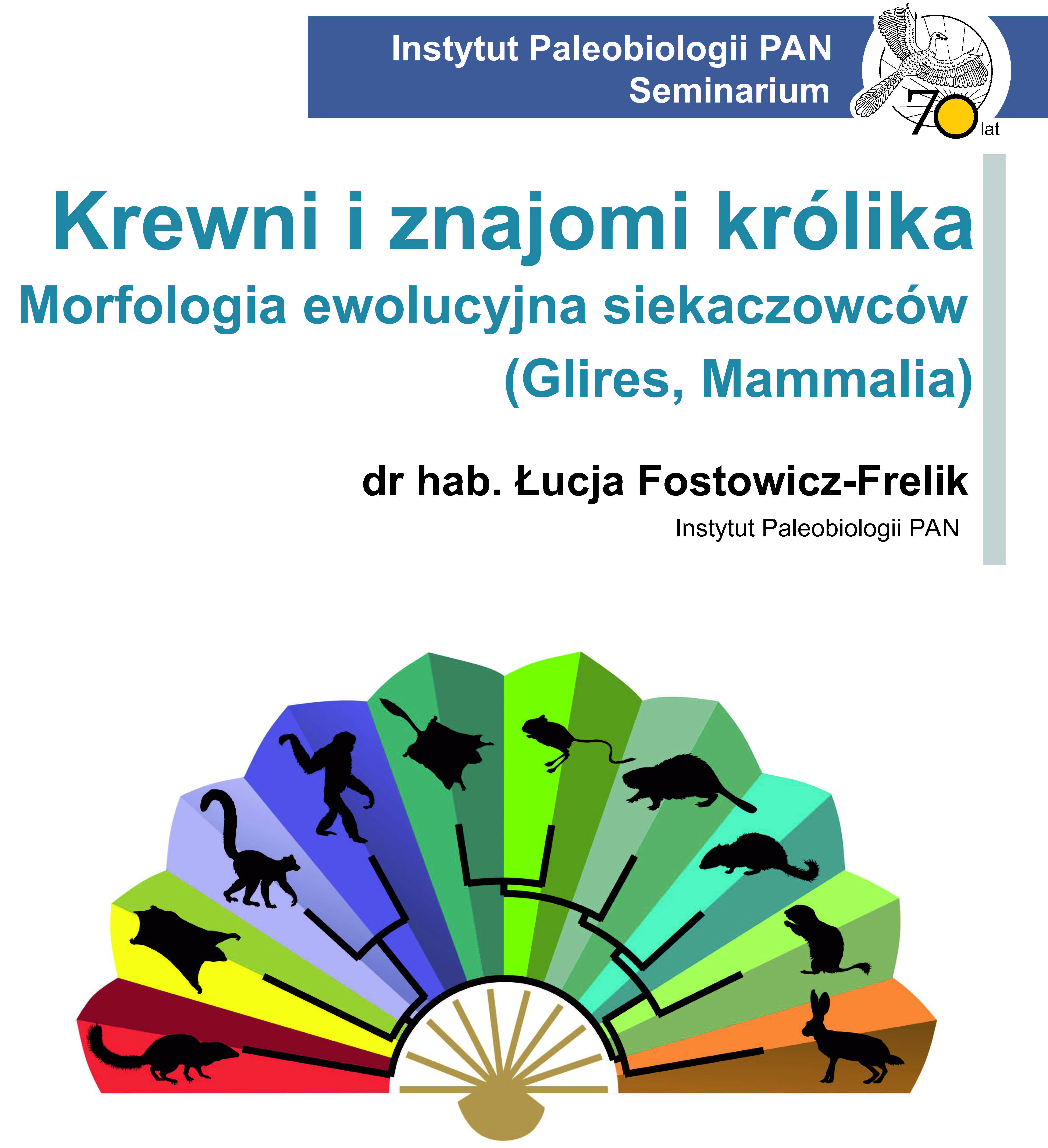 2023.10.09.
Seminar 2023.10.09.
Seminar
9th
October 2023 (Monday), 11:00 a.m., dr hab.
Łucja Fostowicz-Frelik will give a seminar:
"Krewni i znajomi królika Morfologia
ewolucyjna siekaczowców (Glires, Mammalia)".
|
2023.10.04.
PUBLICATION — Różycka, M., Bielak, K., Ptak,
K., Jost, B., MeloRodriguez, G., Schoelkopf, J., Stolarski, J., Dobroszycki,
P., Ożyhar, A. 2023. The effect of gel exposition on
calcium and carbonate ions determines the Stm-l
effect on calcium carbonate crystals morphology. Biomacromolecules 24:
4042−4050, doi: 10.1021/acs.biomac.3c00395
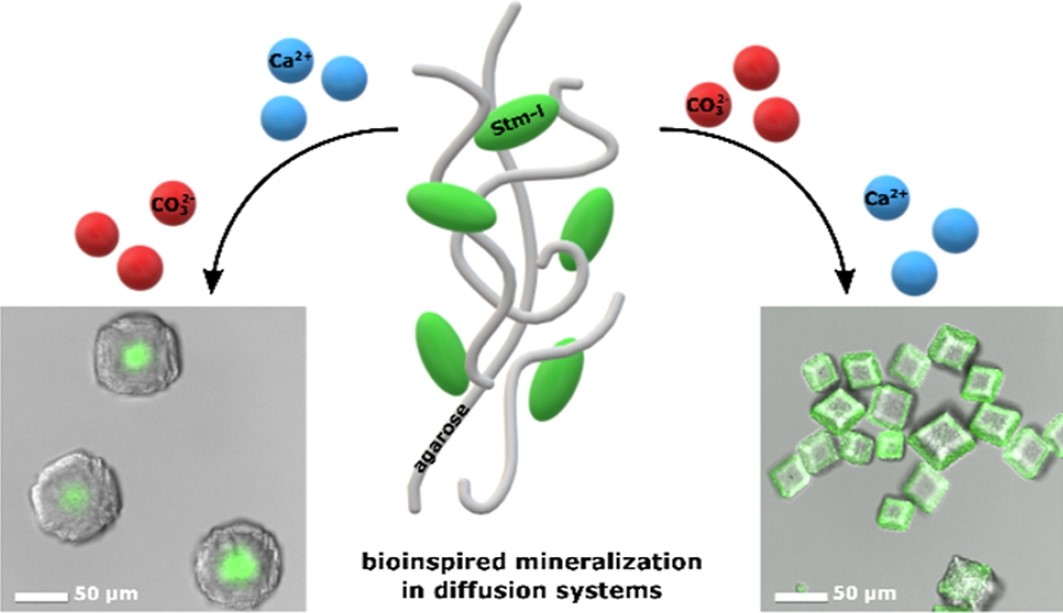 Figure: The CaCO3 crystals grown
in the presence of the Starmaker-like protein
show radically different morphology and
intra-crystalline protein distribution depending
on the prior exposition of the protein to
calcium or carbonate ions.
Figure: The CaCO3 crystals grown
in the presence of the Starmaker-like protein
show radically different morphology and
intra-crystalline protein distribution depending
on the prior exposition of the protein to
calcium or carbonate ions.
Biomineralization of
fish otoliths is regulated by
macromolecules, such as proteins, whose presence
is crucial for the functionality and
properties of these mineralized structures. In
this study, we investigated the effect of a
protein on calcium carbonate biominerals. The
bioinspired minerals grown in the presence of
the protein show radically different
morphology and protein distribution within the
crystals depending on the prior exposition of
the protein to calcium or carbonate ions. The
finding suggests the pathway in which the
environmental factors may influence the macromolecular
functionality of biomineralization.
|
2023.10.04.
PUBLICATION — Canesi, M., Douville, E.,
Montagna, P., Stolarski, J., Bordier, L.,
Dapoigny, A., Coulibaly, G.E.H., Simon, A-C.,
Agelou, M., Iwankow, G., Allemand, D., Planes, S.,
Moulin, C. Tara Pacific Consortium Coordinators,
Reynaud, S. 2023. Differences in carbonate chemistry
up-regulation of long-lived reef-building corals. Scientific Reports 13:11589,
doi:10.1038/s41598-023-37598-9
 Figure: Biological mediation of the carbonate
chemistry of the coral calcifying fluid in two
reef-building scleractinian coral genera Porites
and Diploastrea.
Figure: Biological mediation of the carbonate
chemistry of the coral calcifying fluid in two
reef-building scleractinian coral genera Porites
and Diploastrea.
Capacity
of physiological modifications of the
chemistry of the coral calcifying fluid that
contains the molecules necessary for the
formation of the skeleton is an adaptation of
hexacorals to life in acidified seawater. In
the published paper, the calcification
patterns of Porites and Diploastrea,
two reef-building scleractinian coral
genera common in the Pacific Ocean, are shown
to differ: Porites corals increase the
aragonite saturation
state of the calcifying fluid at higher
temperatures, whereas Diploastrea
shows a steady saturation state across the
temperature gradient. This physiological
difference will likely influence future
survival of these corals under ongoing climate change.
|
2023.10.03.
PUBLICATION — Gałązka, D., Boerner, A., Rytel, A., Szczygielski, T., Borecka, A.,
Danel,
W., & Chruściel, M. (2023). Reinterpretacja
fragmentu szkieletu gada z wczesnego triasu Pomorza.
Przegląd Geologiczny,
71(7), 386–391, doi: 10.7306/2023.34
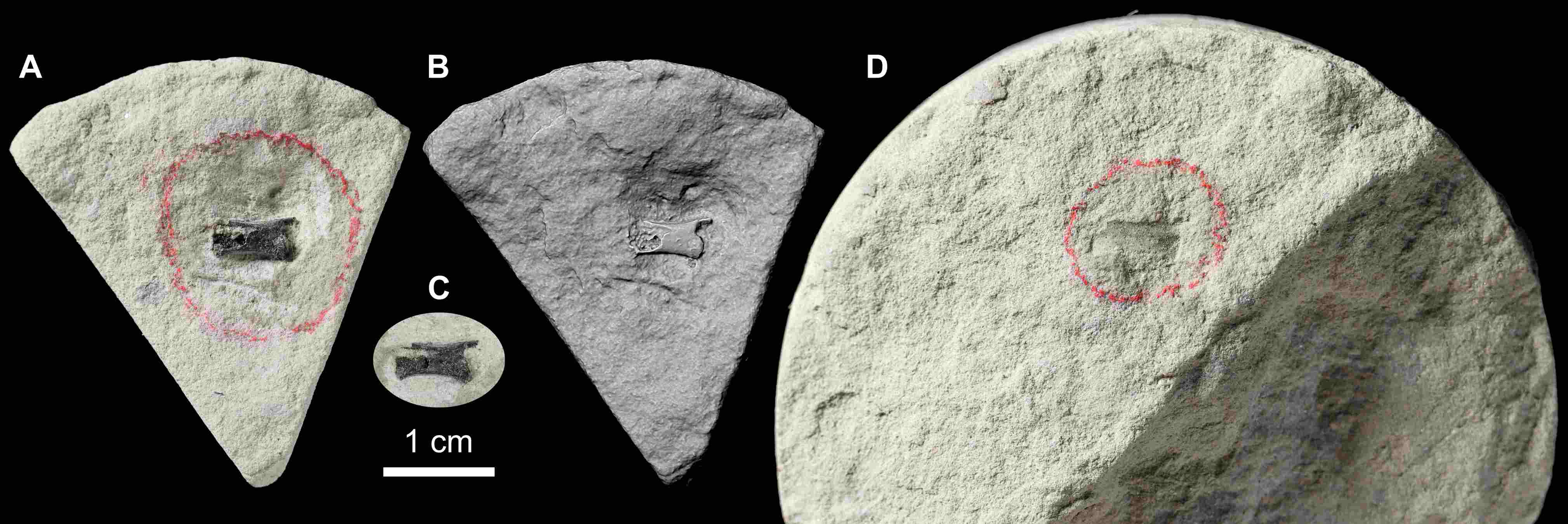 Figure: Drill core fragments (BGR collection) with the
reptile vertebra described as "Microcnemus
sp.". A-C, fossil of the damaged vertebra:
normal light (A), 3D model (B), perpendicular
light (C). D, counterpart with the imprint of
the vertebra before it has been damaged.
Figure: Drill core fragments (BGR collection) with the
reptile vertebra described as "Microcnemus
sp.". A-C, fossil of the damaged vertebra:
normal light (A), 3D model (B), perpendicular
light (C). D, counterpart with the imprint of
the vertebra before it has been damaged.
The territory of
Poland is mostly covered by sediments of glacial origin,
which cover the Mesozoic rocks. That is
why most of the fossil vertebrate remains,
older than just a few millions of years,
originate from southern Poland, where
appropriate outcrops are available. In Pomerania the whole Triassic tetrapod fossil record
is limited to a single vertebra, which was
collected from a drilling core from Darłowo, and is
reinterpreted in this publication. The
scientific value of the specimen is great
despite its small size, as it provides
evidence for the presence of reptiles in the
extremely dry and hot equatorial regions of
the Pangaea supercontinent.
|
|
2023.10.02. PUBLICATION
— Skompski S., Kozłowska A., Kozłowski W.
& Łuczyński P. 2023. Coexistence of algae and a
graptolite-like problematicum: a case study from the
late Silurian of Podolia (Ukraine). Acta Geologica Polonica,
73, pp. 115–133, doi: 0.24425/agp.2022.143599
For the first time, the unusual phenomenon of
graptolites growing on algae
is observed. Sessile green algae belonging to the Dasycladales were found
in the Silurian (about 427
million years ago) sediments of a shallow shelf sea, in Podolia, western
Ukraine. Graptolites belonging to the
Dendroidea were epiphytes growing on the
alga. Both forms, Voronocladus dryganti (alga)
and Podoliagraptus algaeoides (graptolite),
were unknown until now. The exceptional state
of preservation of both forms allows treating
the outcrop as a ‘ Konservat Lagerstätte’.
Figure: Reconstruction of the
dasycladalean green alga Voronocladus
dryganti gen. et sp. nov. (drawing by
Bogusław Waksmundzki)
|
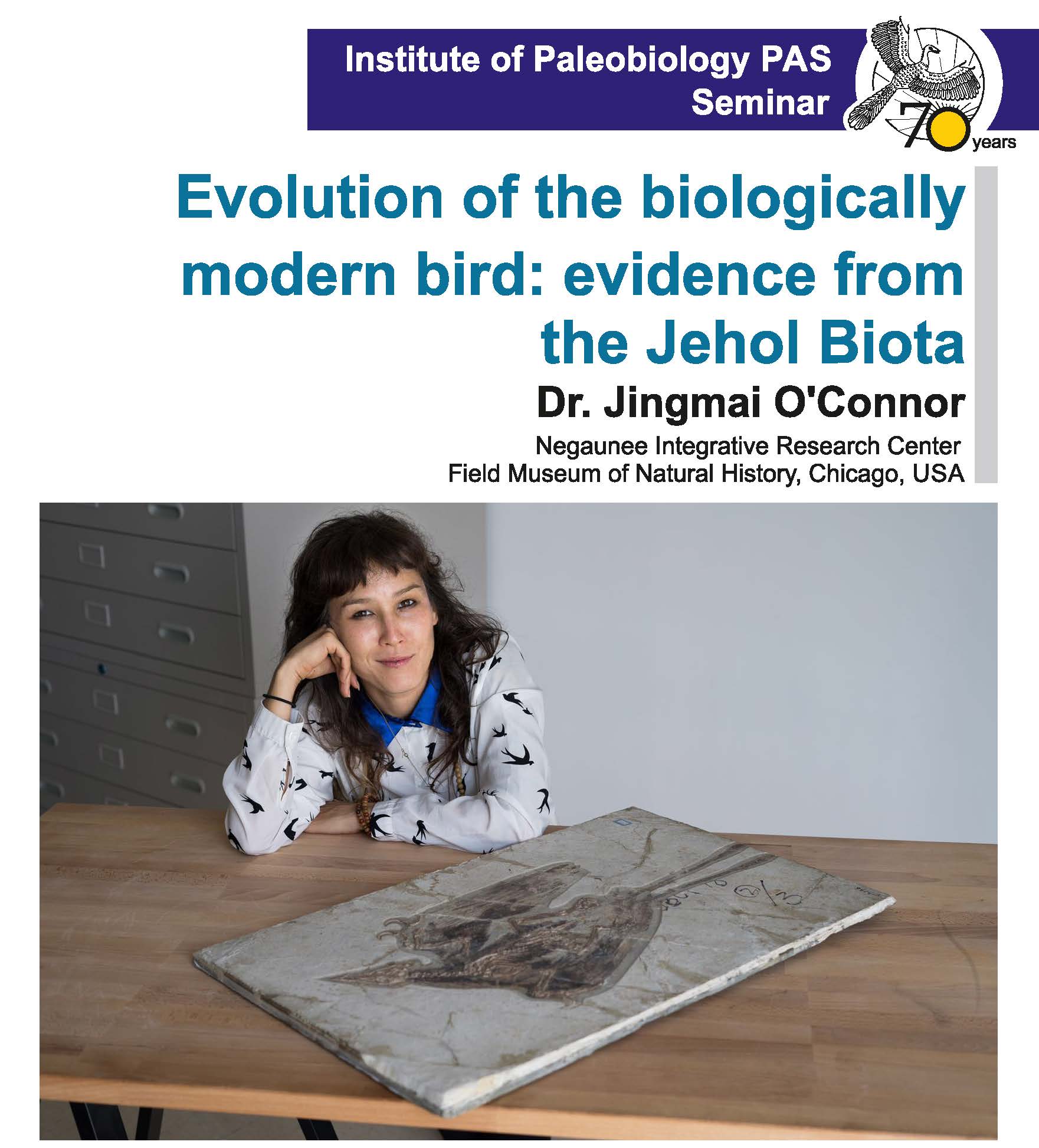 2023.09.29.
Seminar 2023.09.29.
Seminar
3rd
October 2023 (Tuesday), 4.00 p.m., dr Jingmai
O'Connor will give a seminar:
"Evolution of the biologically modern bird:
evidence from the Jehol Biota".
|
2023.09.08.
On 10 September in Warsaw starts: 14th
Symposium of the International Fossil Coral and
Reef Society (IFCRS)
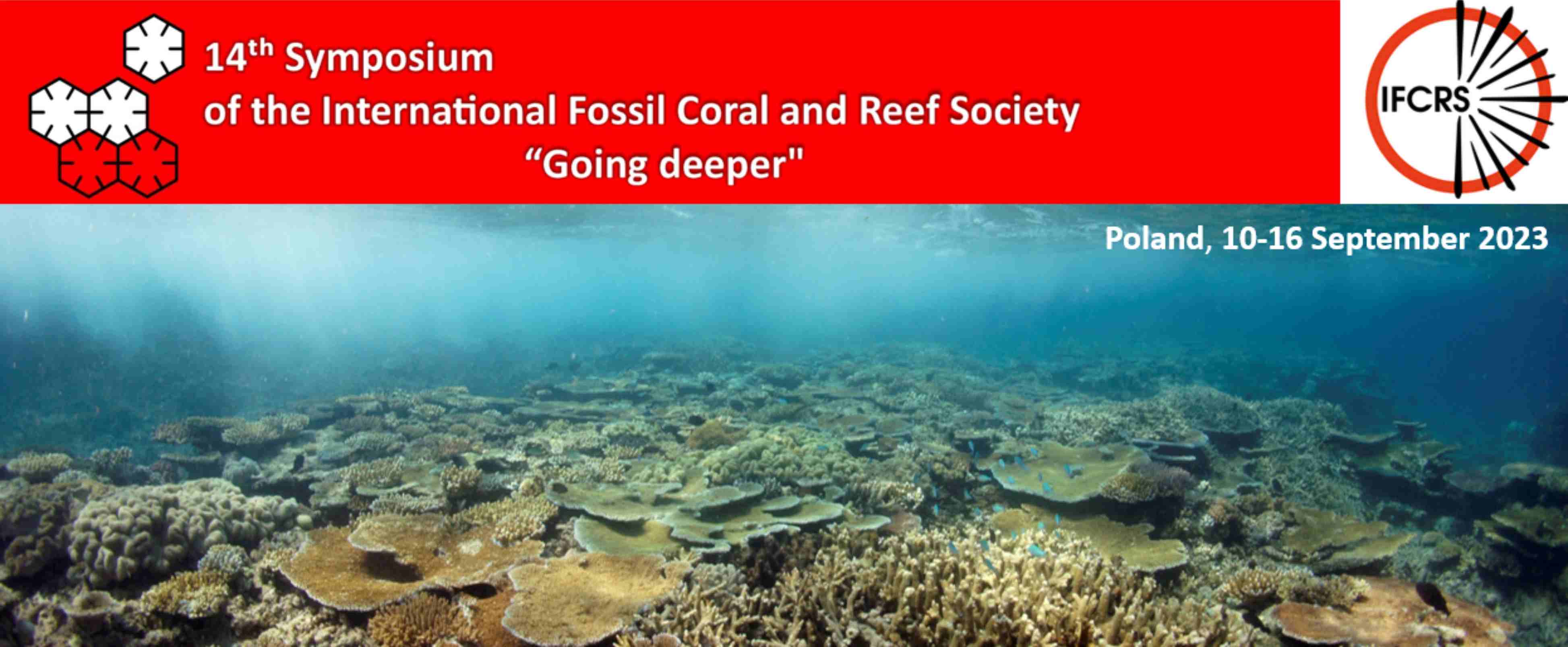
IFCRS symposia
are important avenues for researchers studying
fossil corals and reefs. Today’s reef
environments are some of the most vulnerable
marine ecosystems to changing climatic
conditions. Climate change models predict the
extinction of most of today’s known
shallow-water reef environments by the end of
21st century. However, recent research
suggests that not all corals have the same
potential to survive change, and the key to
understanding these differences lies in their
geological and evolutionary past. The leading
theme of the conference will be the study of
corals from mesophotic and deep-water
environments (motto: “Going deeper“), as these
environments are now potential coral refugia
in the event of extinction of shallow-water
reefs. The fossil mesophotic reef environments
in Poland are well understood and represent
the first preserved reefs of modern type in
the world.
All details are available on the conference
website: https://fossilcoralreefs.com/
|
2023.09.04. PUBLICATION
— Olempska, E., Mundy, David,
J.C & Zatoń, M. 2023. Cryptic moulting behaviour
of some Carboniferous Ostracoda. Papers in Paleontology,
e1519, doi: 10.1002/spp2.1519
Monospecific ostracod accumulations
mainly within cephalopod (a nautiloid and two goniatites) phragmocones (siphuncle
and camerae), are described from the Carboniferous of England. Exclusive
occurrence of disarticulated carapaces and
preservation of delicate morphological
structures indicate that these accumulations
did not result from sedimentological
processes, but rather reflect the ostracod behaviour, namely
seeking a sheltered place for moulting, as
well as for egg laying, the latter supported
by the presence of spherical structures
preserved within one of the accumulations.
|
 2023.08.29.
Seminar 2023.08.29.
Seminar
5th
September 2023 (Tuesday), 10:00 a.m. (local time
in Warsaw), prof. Stephen Brusatte
will give a seminar: "The Rise of Placental
Mammals: Dissecting our Evolutionary Radiation
after the End-Cretaceous Mass Extinction".
|
2023.08.18.
PUBLICATION — Parent, H., Kaim, A., Alberto C. Garrido,
A.,C. 2023. Ammonite assemblage and age of the
hydrocarbon seep La Elina, Neuquén Basin, Argentina.
Annales Societatis Geologorum
Poloniae, 93: in press, doi:
10.14241/asgp.2023.14
Jurassic sediments of hydrocarbon seeps from
La Elina Ranch (northern Patagonia) are the only
source of information on this kind of
environment in South America. Apart from
gastropods and bivalves typical of hydrocarbon
seeps and usually deep-water, this site
provided also numerous ammonoids, which suggest
rather shallow water character of this seep.
The absence of shallow water gastropods and
bivalves might be related to unusual
environmental conditions in the basin, most
likely oxygen depletion of
surrounding bottom waters.
|
2023.08.16.
PUBLICATION — Wolniewicz, A. S., Shen, Y.,
Li, Q., Sun, Y., Qiao, Y., Chen, Y., Hu, Y., and
Liu, J. (2023). An armoured marine reptile from the
Early Triassic of South China and its phylogenetic
and evolutionary implications. eLife, 83163, doi:
10.7554/eLife.83163
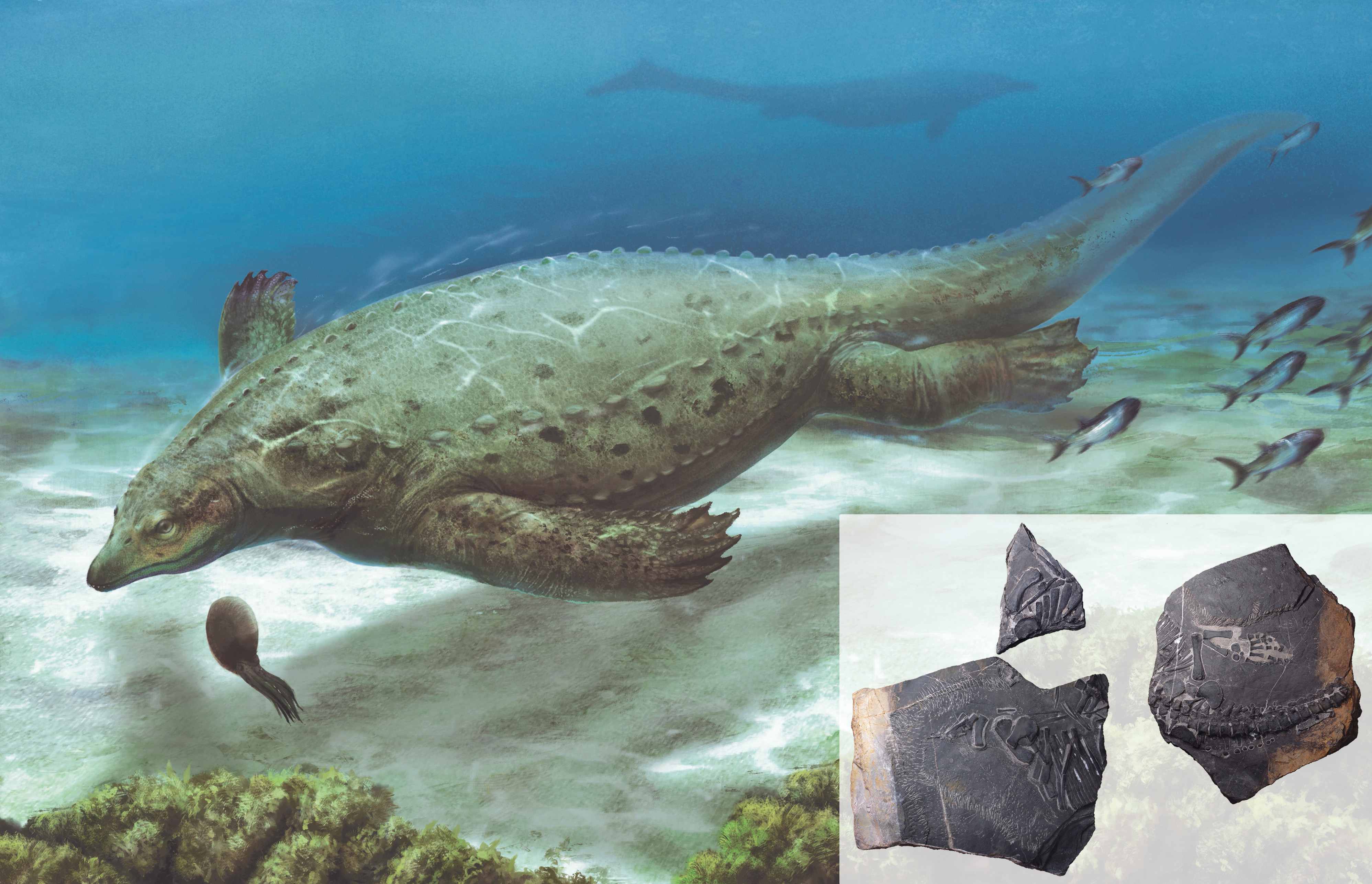 Reconstruction
by Zhixin Han. Reconstruction
by Zhixin Han.
A Polish-Chinese
research team described a new saurosphargid marine reptile from the Early Triassic of China ( Hubei Province) – Prosaurosphargis
yingzishanensis. A phylogenetic
hypothesis on relationships between the major
groups of reptiles presented in the article
proposes that saurosphargids are nested within
Sauropterygia, a group
of Mesozoic marine reptiles, which also
includes the famous plesiosaurs.
Sauropterygians themselves were recovered as
members of Archelosauria, a large
group of reptiles that also includes turtles
and archosauromorphs
(crocodiles, dinosaurs, birds, and their
relatives).
|
2023.08.08.
PUBLICATION — Pindakiewicz, M.,K., Hryniewicz, K., Kaim, A. 2023. Early
Cretaceous radiation of teleosts recorded by the
otolith-based ichthyofauna from the Valanginian of
Wąwał, central Poland. Journal of Vertebrate
Palaeontology e2232008,
doi:10.1080/02724634.2023.2232008
About 140 million
years ago, Poland was a sea connecting the Tethys Ocean with the Boreal Sea. The fish
that inhabited this sea left no skeletal
remains, but have been identified based on otoliths, found in Wąwał, central Poland.
Those “earstones” are responsible (among
others) for sense of balance. This study shows
that Early Cretaceous seas covering Poland
were populated by the ancestors of silverfish, Japanese
gisu fish, and cousins of slanderers, albulas and marine
relatives of arapaima. Interestingly,
some otolith species were previously known
from younger marine sediments.
|
2023.07.24.
PUBLICATION — Weryński Ł, Błażejowski B. 2023. Late
Jurassic teeth of plesiosauroid origin from the
Owadów-Brzezinki Lägerstatte, Central Poland. PeerJ 11:e15628,
doi:10.7717/peerj.15628
Figure: Lithological succession of the
Owadów-Brzezinki Quarry; plesiosaur tooth ZPAL
R.11/OB/T4; reconstruction: Stanisław Kugler.
|
2023.07.18. PUBLICATION
— Sachs, S., Abel, P. & Madzia, D. 2022. A
‘long-forgotten’ plesiosaur provides evidence of
large-bodied rhomaleosaurids in the Middle Jurassic
of Germany. Journal of Vertebrate
Paleontology 42 (5): e2205456,
doi:10.1080/02724634.2023.2205456
Described in 1858, Trematospondylus
macrocephalus from the Bathonian ( Middle Jurassic) of
Germany is one of the earliest established plesiosaur taxa. However, despite
being historically significant, the taxon
disappeared from the literature shortly after
its initial description and has not been
mentioned for over a century. The new study
shows that Trematospondylus most
likely belongs to the Rhomaleosauridae and
represents a large-bodied member of this
archaic clade. The material adds to the rare
Middle Jurassic record of rhomaleosaurids and
enhances our knowledge of the plesiosaur
diversity during the pre- Callovian Middle
Jurassic, which has been very limited.
Reconstruction:
Dmitry Bogdanov
|
2023.07.17. PUBLICATION
— Pisera, A., Bitner, M.A., & Fromont,
J. 2023. Eocene phymaraphiniid demosponges from
South Western Australia: filling the gap. Acta Palaeontologica Polonica
68 (2): 261-272, doi: 10.4202/app.01052.2023
The newly collected, very rich and well
preserved material showed that previously
wrongly attributed Eocene sponges from SW
Australia belong to the demosponge family
Phymaraphiniidae. Two new genera, Twertupia
and Pickettispongia are proposed for
them. This is the first record of bodily
preserved phymaraphiniid sponges from Eocene rocks, as well as
from the southern hemisphere. The reported
occurrence is filling the stratigraphical gap
between well-known Cretaceous
phymaraphiniids from Europe and extant
phymaraphiniids.
|
2023.06.22.
PUBLICATION — Czepiński, Ł. 2023. Skull of a
dromaeosaurid dinosaur Shri devi from the
Upper Cretaceous of the Gobi Desert suggests
convergence to the North American forms. Acta Palaeontologica Polonica
68 (2), 227-243. doi:10.4202/app.01065.2023
Figure: skull and left foot of a dromaeosaurid
from Khulsan, Baruungoyot strata, Mongolia
(drawing: Jakub Zalewski).
The material of
a carnivorous dinosaur found in the 1970s by a
Polish-Mongolian
paleontological expedition in the Gobi Desert is newly
interpreted as belonging to the Shri devi
species, closely related to the famous Velociraptor. The
specimen includes a skull that was previously
unknown in this species. Unlike other velociraptorines from
Mongolia, Shri devi had a relatively
short snout, with the proportions resembling
the dromaeosaurids from
North America. It is possible that the convergence in the skull
anatomy of these animals may be due to
adaptation to the desert-like environmental
conditions.
|
2023.06.20.
PUBLICATION — Ye, F., Shi, G.R. & Bitner, M.A. 2023.
Interhemispheric biodiversity peaks of living
brachiopods coinciding with warm-temperate zones and
correlated to a multitude of biotic, abiotic and
evolutionary factors. Global and Planetary Change,
227, 104163.
doi:10.1016/j.gloplacha.2023.104163
Figure: (a) Latitudinal diversity gradient of
living brachiopods vs. mean latitudinal range of
brachiopods in 20° latitudinal bins.
(b) Latitudinal diversity gradient of living
brachiopods vs. mean sea surface temperature.
The latitudinal diversity
gradient is one of the most extensive
and important biodiversity patterns on the
Earth. The analysis of the global latitudinal
diversity patterns of living brachiopods showed a
consistent bimodal pattern
dominated by two mid-latitude peaks at
warm-temperate zones what is in contradiction
to the classical unimodal latitudinal
diversity gradient. This bimodal pattern of
living brachiopods is not affected by
taxonomic, bathymetric and spatial scales. We
tested several ecological hypotheses to
explain such pattern and the Rapoport's rule was
found to be the best fitting the bimodal
pattern.
|
2023.06.15.
PUBLICATION — Korsun, S., Kniazeva, O., Majewski, W., Godoi, M. A.,
Hromic, T., Varfolomeeva, M., Pawlowski, J. 2023.
Foraminifera in temperate fjords strongly affected
by glacial meltwater, Tierra del Fuego, South
America. Marine Micropaleontology
181, 102248.
doi:10.1016/j.marmicro.2023.102248
Figure: Ready-to-go Van Veen grab, which we
used to collect seafloor sediments in the fjords
of Patagonia. Foraminiferal images not to scale.
Foraminifera, a group of
unicellular organisms, are commonly used as bioindicators in
paleoenvironmental studies. Unfortunately,
their distribution in many key areas is poorly
understood. One such region is southern Patagonia, which is a
subject to unstable conditions due to the
migration of the southern westerly wind belt
and the Antarctic Circumpolar
Current. The work based on the material
collected in 2013 describes the distribution
of foraminifera in the sediments of the Beagle Channel and its
tributary fjords. Unusually for
similar areas, there are no assemblages
typical of habitats proximal to glacier fronts
that are under strong environmental pressure.
|
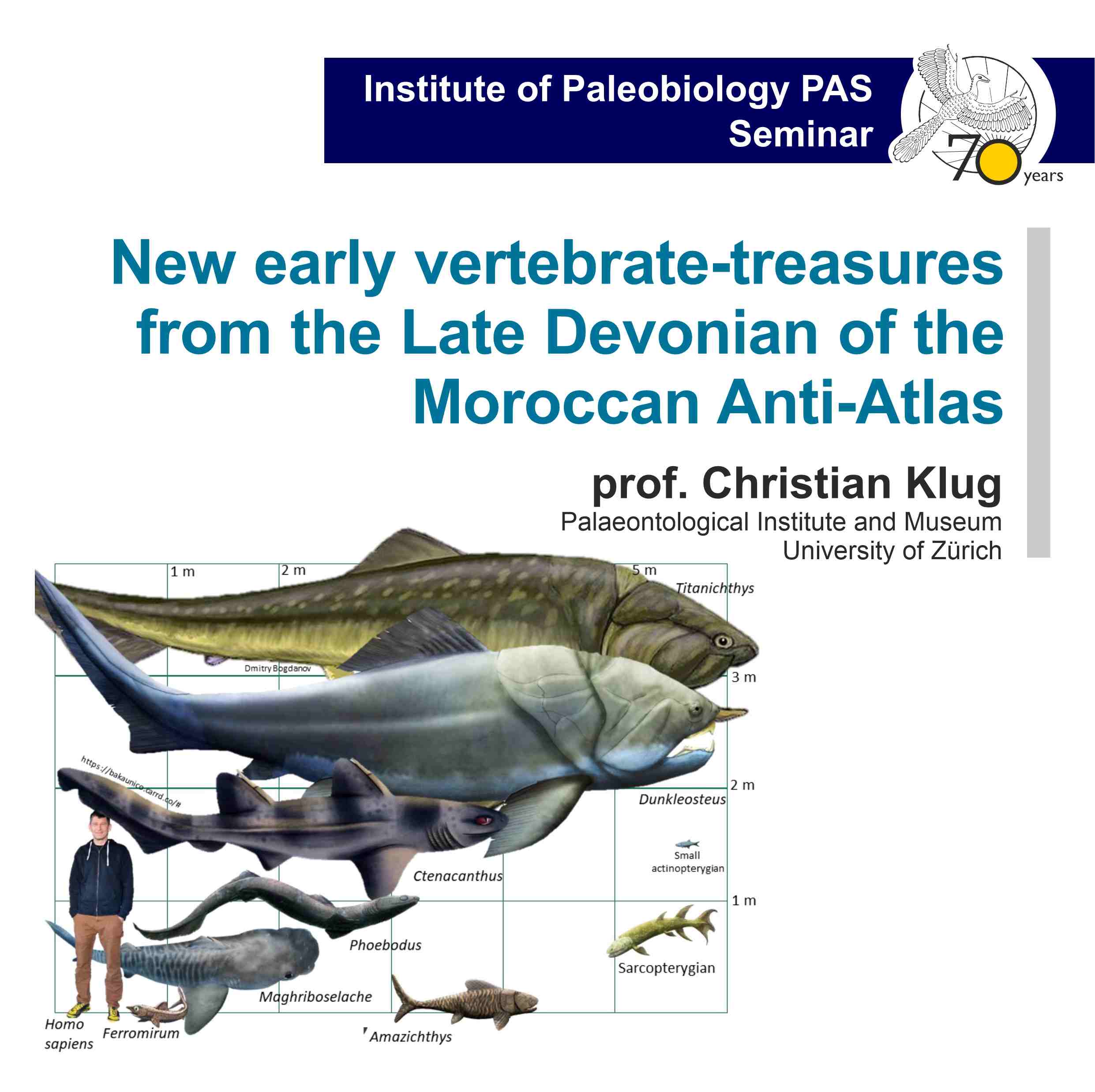 2023.06.14.
Seminar 2023.06.14.
Seminar
19th
June 2023 (Monday), 2.00 p.m., prof.
Christian Klug will give a seminar:
"New early vertebrate-treasures from the Late
Devonian of the Moroccan Anti-Atlas".
|
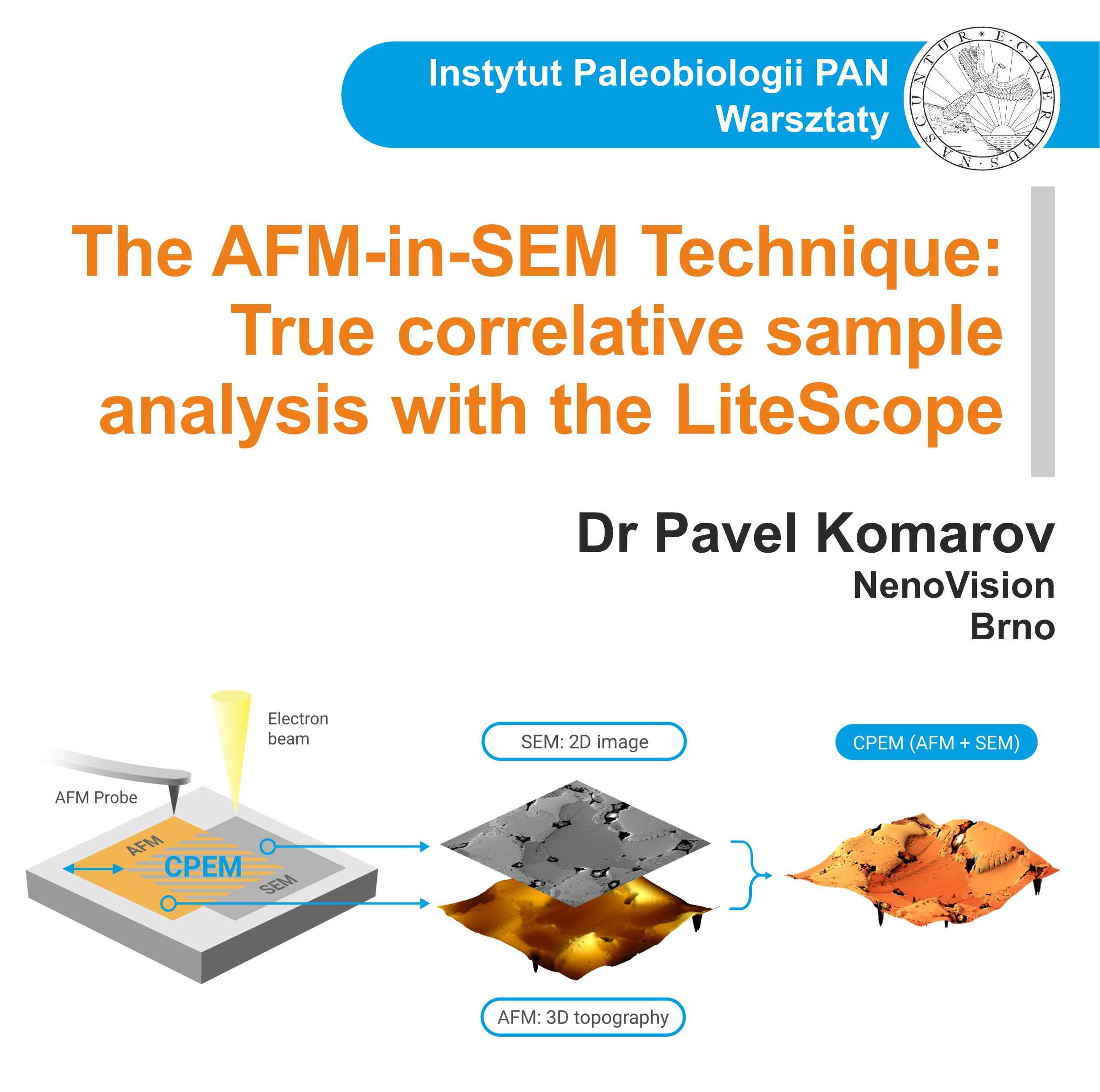 2023.06.06.
Science workshops 2023.06.06.
Science workshops
12th
June 2023 (Monday), 11:30 a.m., Dr Pavel
Komarov will give a workshops: "The
AFM-in-SEM Technique: True correlative sample
analysis with the LiteScope".
|
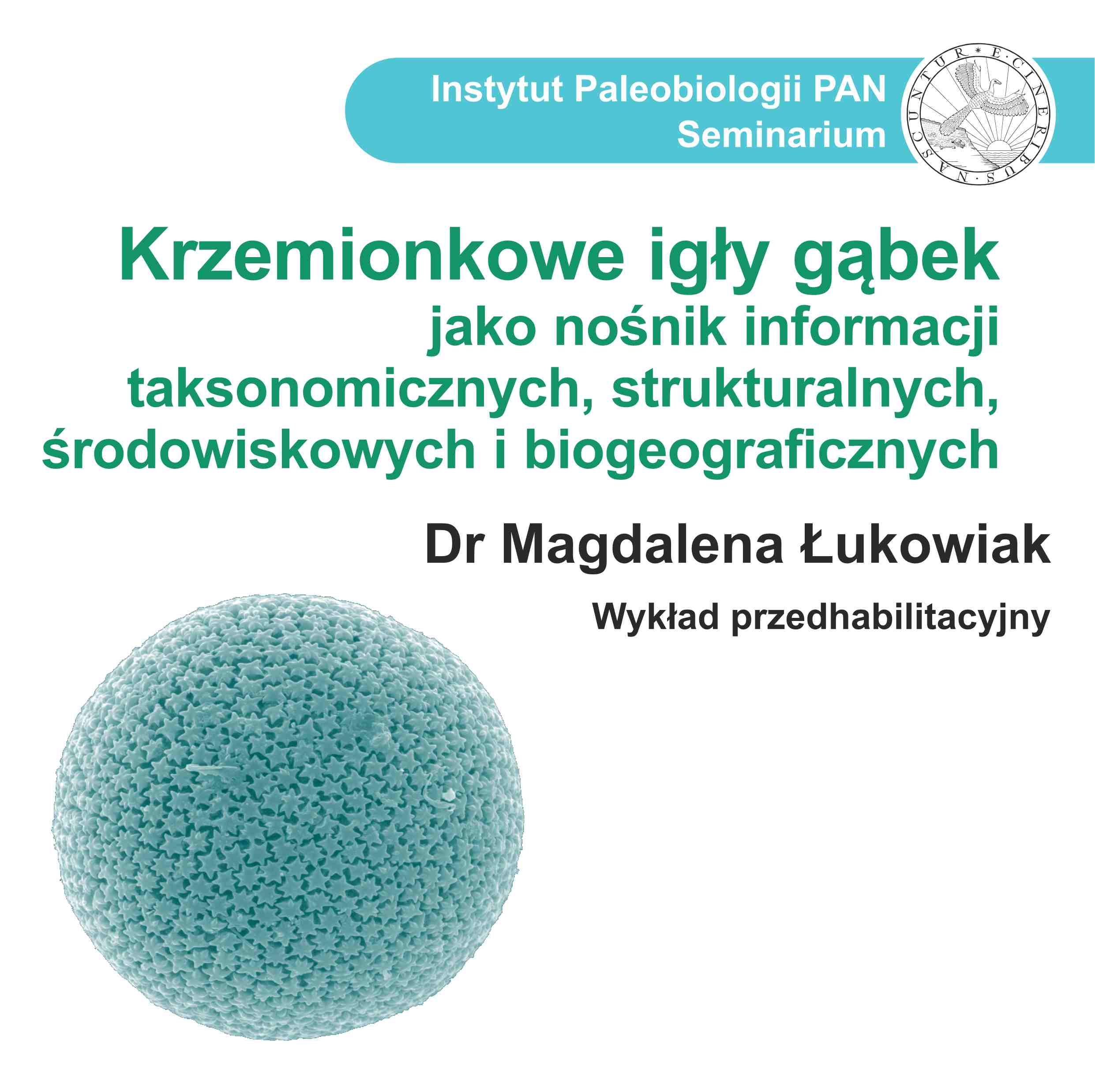 2023.05.30.
Seminar 2023.05.30.
Seminar
5th
June 2023 (Monday), 11:00 a.m., Dr Magdalena
Łukowiak will give a seminar:
"Krzemionkowe igły gąbek jako nośnik informacji
taksonomicznych, strukturalnych, środowiskowych
i biogeograficznych".
|
2023.05.29.
PUBLICATION — Ye, F., Bitner, M.A. & Shi, G.R.
2023. Variation of shell ornamentation with latitude
and water depth – A case study using living
brachiopods. Ecology and Evolution, 13:
e10006.
doi: 10.1002/ece3.10006
Figure:
The changes of the radial ornamentation index
along different latitudinal zones. The data from
ventral valve: blue colour, the data from dorsal
valve: red colour.
Shell
ornamentation of marine calcifiers is considered
as a potential anti-predatory defensive
structure. We tested the hypothesis that the
strength of brachiopod shell
ornament treated as anti- predatory defence
mechanism decreases with latitude and water
depth. We found no statistically significant
associations between ornamentation of living
brachiopods and latitude or their
ornamentation and water depth, a pattern
sharply contrasting with that of most fossil
brachiopods. Nearly 60% of living brachiopods
are characterised by smooth shells. High
proportion of smooth shells can be explained,
among others, by their preference for cryptic
and deep water habitats where the predation pressure is low.
|
2023.05.22. PUBLICATION
Fostowicz-Frelik Ł. and Tseng
J. 2023. Introduction: The mammalian skull:
development, structure and function. Philosophical Transactions of
the Royal Society B 378, 20220077,
doi:10.1098/rstb.2022.0077
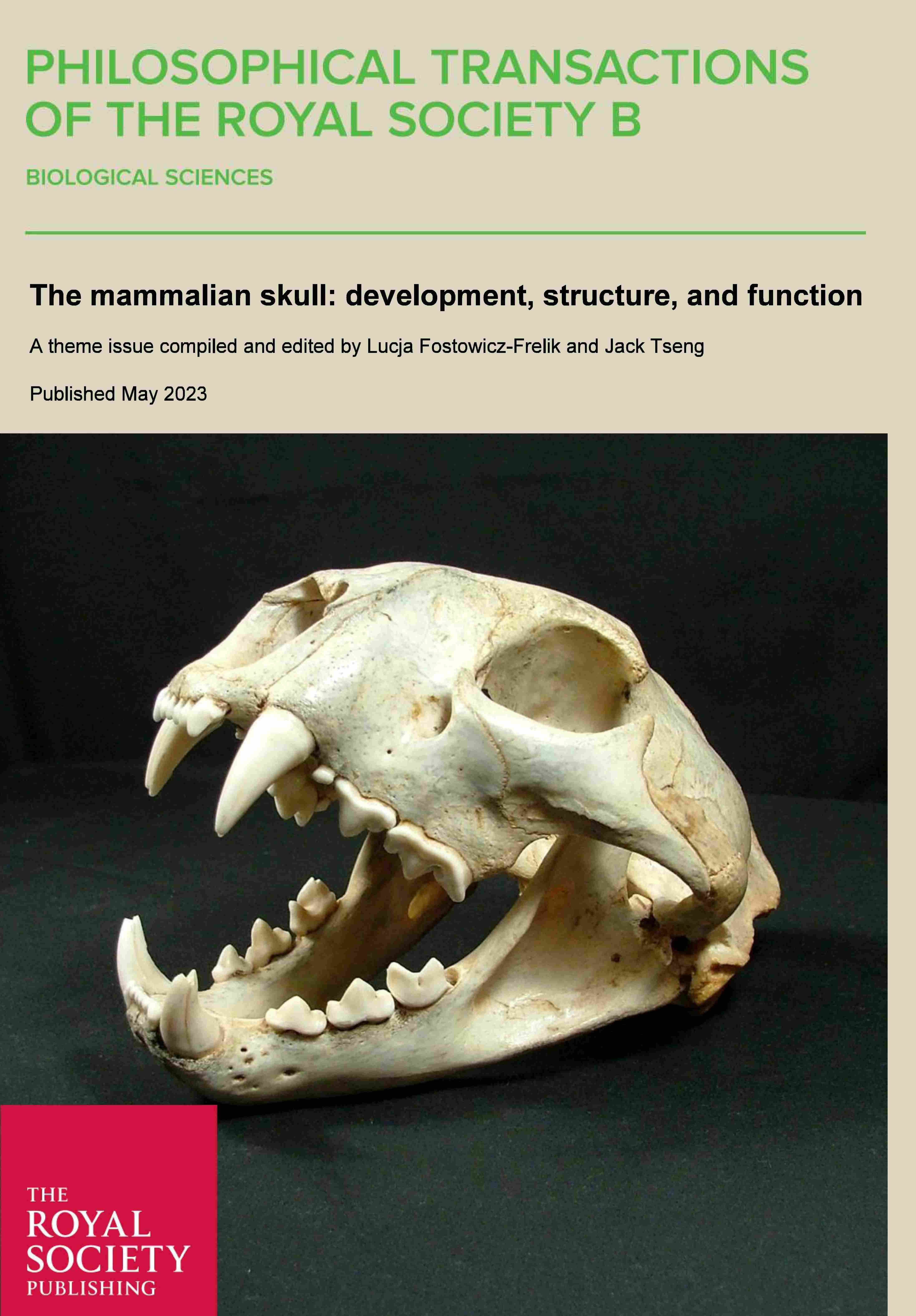
Beginning from 1665, Philosophical Transactions
published by the Royal Society of London
is the oldest continuously running scientific
journal in the world. The theme issue "The
mammalian skull: development,
structure, and function", assembled by Guest
Editors Łucja Fostowicz-Frelik (Institute of
Paleobiology, Polish Academy of Sciences) and
Jack Tseng (University of California,
Berkeley, USA), brings together multiple
perspectives on this fast evolving topic.
Overall, 12 original contributions divided
evenly between research papers and reviews
written by scientists from five continents
offer a series of snapshots of the mammalian skull.
Glires
(rodents, lagomorphs and their fossil kin) is
the most speciose and arguably most diversified
clade
of living placentals. Within the
Glires, two basically opposite chewing movements
evolved: a mostly transversal power stroke in lagomorphs, and a mostly
proal power stroke in rodents, but the ancestral
condition for Glires is still unclear. We
studied mandibles of Chinese Paleocene Glires
representing the lagomorph-like (duplicidentate)
and rodent-like (simplicidentate) lineages. The
results of biomechanical analysis demonstrate a
mixture of duplicidentate and simplicidentate
characters among the basal Glires and suggest an
early occurrence of a lagomorph-like morphotype.
Ruf I., Meng J., Fostowicz-Frelik Ł 2023.
Auditory region circulation in Lagomorpha: the
internal carotid artery pattern revisited. Philosophical Transactions of
the Royal Society B 378, 20220088,
doi:10.1098/rstb.2022.0088
The internal carotid artery (ICA)
is one of the main vessels in the cranial
circulation. Because the ICA openings, canals, and
groves can be studied also in fossils, these
characters have been used often in comprehensive
phylogenetic analyses. We studied the ICA-related
features in 11 genera of living lagomorphs and key extinct
taxa using μCT data. Our results show
that the proposed ancestral state of the ICA
course for Lagomorpha is similar to that of the
earliest rodents, plesiadapids, and scandentians, and support
lagomorphs as as a morphologically conservative
clade in contrast to its counterpart, rodents.
|
|
2023.05.19. PUBLICATION
— Szczygielski T., Sulej T. 2023. Woznikella
triradiata n. gen., n. sp. – a new
kannemeyeriiform dicynodont from the Late Triassic
of northern Pangea and the global distribution of
Triassic dicynodonts. Comptes Rendus Palevol 22
(16): 279–406,
doi:10.5852/cr-palevol2023v22a16
Dicynodonts were
herbivorous synapsids –
representatives of the tetrapod group
encompassing mammals, their ancestors and
relatives, but not reptiles. The dicynodonts
achieved an evolutionary success in the Permian and although the
extinction at the
Permian–Triassic transition severely
impoverished their diversity, they recovered
during the Triassic. The paper
presents a new genus and species of a Late
Triassic dicynodont from Poland and Germany, Woznikella
triradiata, and discusses the geographic
and temporal distribution of dicynodonts in
the Triassic. The results highlight the key
role of the southeastern part of Africa as a
source of numerous westward and northward
expansions of various dicynodont groups.
Figure:
Woznikella triradiata, skull
reconstruction in lateral view.
|
2023.05.18.
PUBLICATION — M. A. Salamon, T. Brachaniec, K.
Paszcza, D. Kołbuk, P. Gorzelak 2023. The role of
mass extinction events in shaping the body-size
dynamics of fossil crinoids.
Palaeogeography,
Palaeoclimatology, Palaeoecology. Volume
622, 15 July 2023, 111593,
doi:10.1016/j.palaeo.2023.111593
The analysis of
calyx sizes of fossil crinoids has shown that
the mean calyx size significantly decreased
during the periods of mass extinction (during
the late Ordovician, the middle-late Devonian,
the Permian–Triassic
boundary, the Cretaceous anoxic events). These
declines were mostly governed by extinction of
larger taxa, except during the Cretaceous
anoxic events, when the mean size decrease was
driven by origination of
small-sized taxa. The analysis is based on a
newly created database with measurements of
1263 Palaeozoic and Mesozoic crinoid
calyces.
|
2023.05.17. PUBLICATION
— Wierzbowski, H. and Błażejowski, B. 2023.
Chaetognath grasping spines from the Devonian of
Poland: their structure and geochemistry. Acta Palaeontologica Polonica
68 (1): 103–116, doi:10.4202/app.01012.2022
Previously unidentified small phosphatic
spines from the Devonian of the Holy Cross Mountains
have been included into arrow worms (phylum
Chaetognatha), which is a widespread group of
marine invertebrates. The phosphatised
grasping spines of chaetognaths are mostly
known form the lowermost Paleozoic, therefore,
the described fossils are unique remnants of
such organic materials. Due to remarkable
differences in the construction of the studied
spines, compared to Lower Paleozoic forms,
they have been included into a new genus and species,
Phakeloides polonicus gen. et sp. nov.
Figure:
Recent chaetognath of the genus Sagitta
(a) and a head with grasping apparatus (b,
c), after H. Szaniawski; Devonian
chaetognath grasping spines Phakeloides
polonicus gen. et sp. nov. (d-g);
Ostrówka Quarry (h).
|
2023.05.10.
PUBLICATION — Adams, A., Daval, D.,
Baumgartner, L.P., Bernard, S., Vennemann,
T., Cisneros-Lazaro, D., Stolarski, J., Baronnet, A.,
Grauby, O., Guo, J., Meibom, A. 2023. Rapid grain
boundary diffusion in foraminifera tests biases
paleotemperature records. Communications Earth &
Environment 4:144,
doi:10.1038/s43247-023-00798-2
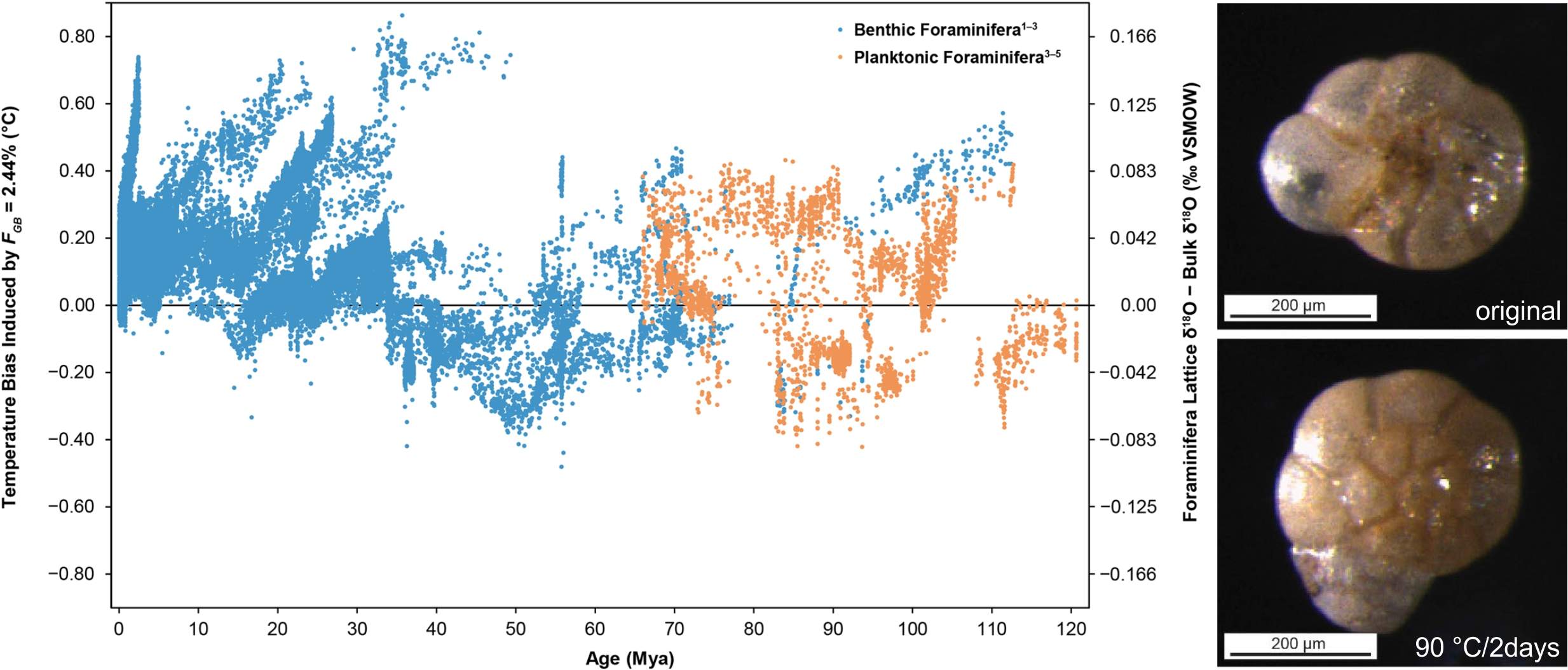
Figure:
Temperature biases due to grain boundary
diffusion in fossil benthic and planktonic
foraminifera tests (the left y-axis shows the
temperature bias induced by grain boundary
diffusion on existing seawater
paleotemperature reconstructions; foraminifera
δ18OLattice−δ18OBulk,
shown on the right y-axis). On the right:
ventral sides of pristine and hydrothermally
incubated Ammonia sp. tests (no
difference can be seen).
The oxygen isotopic compositions of
fossil foraminifera tests
constitute a continuous proxy record of deep-ocean
and sea-surface temperatures spanning
the last 120 million years. Here, by
incubating foraminifera tests in 18O-enriched
artificial seawater analogues, we demonstrate
that the oxygen isotopic composition of
optically translucent, i.e., glassy
(apparently unaltered), fossil foraminifera
calcite tests can be measurably altered at low
temperatures through rapid oxygen
grain-boundary diffusion without any visible ultrastructural changes.
Grain boundary diffusion can be shown to bias
prior paleotemperature estimates by as much as
plus or minus half a degree or nearly one
degree centigrade.
|
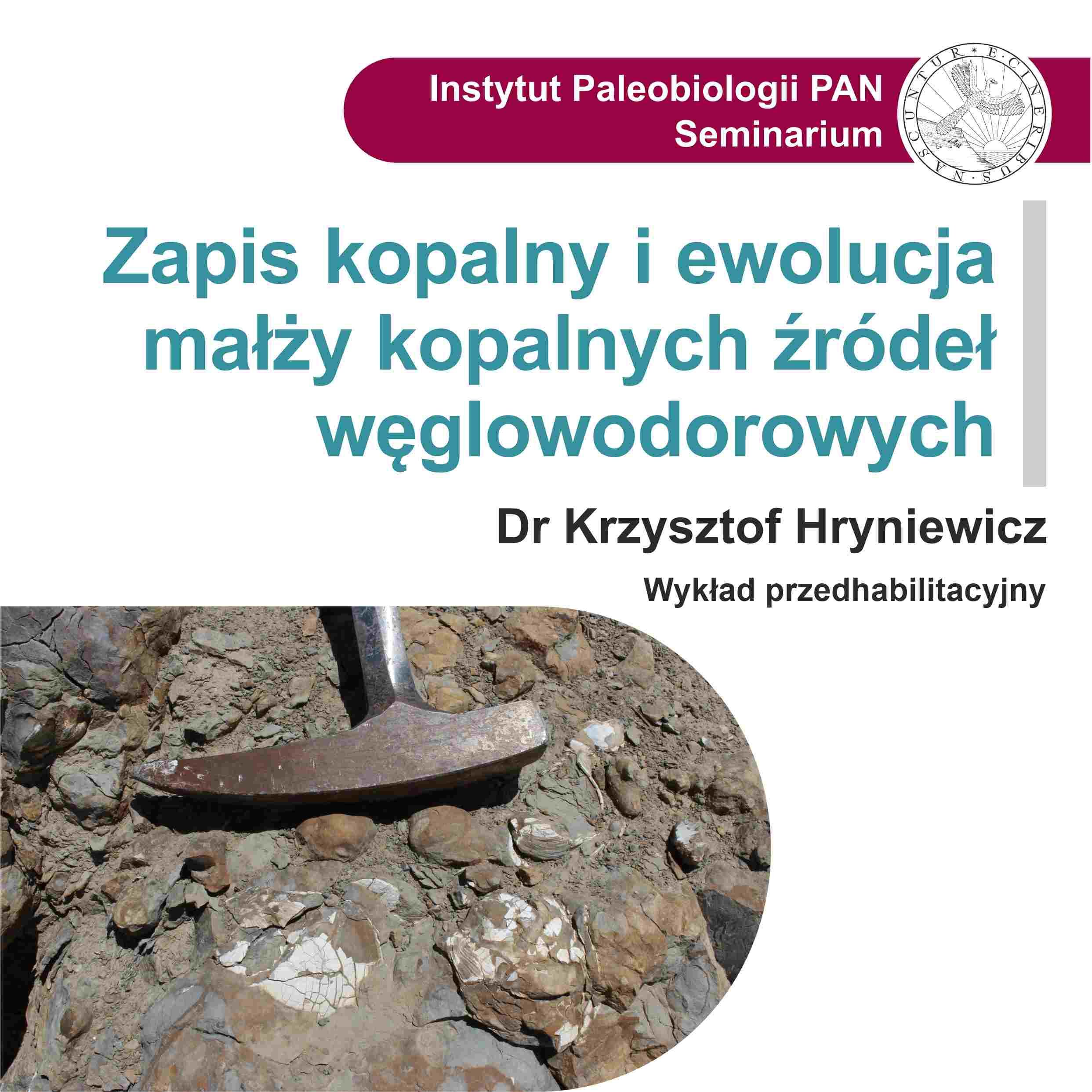 2023.05.09.
Seminar 2023.05.09.
Seminar
15th
May 2023 r. (Monday), 11:00 a.m., Dr
Krzysztof Hryniewicz will give a seminar:
"Zapis kopalny i ewolucja małży kopalnych źródeł
węglowodorowych".
|
2023.04.24. PUBLICATION
— Baliński, A. & Halamski, A.T. 2023.
Pre-Taghanic (Lower to lower Middle Givetian)
brachiopods from Miłoszów in the Holy Cross
Mountains (Poland). Annales Societetis Geologorum
Poloniae, 93 (1): 3–102, doi:
10.14241/asgp.2023.01
Figure:
Atrypide
brachiopod Davidsonia septata cemented
onto a rugosan coral (Baliński & Halamski
2023, fig. 32H).
|
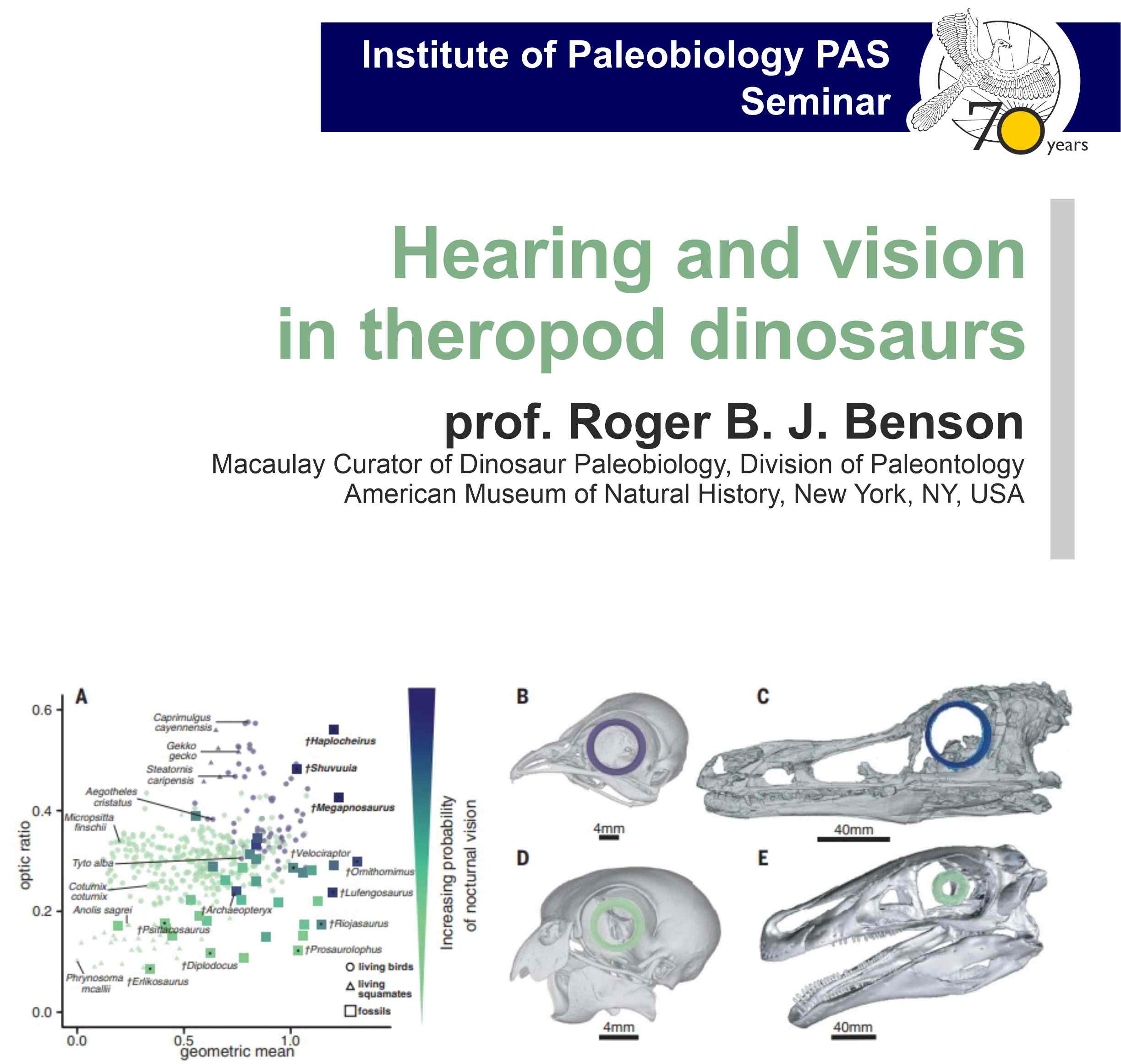 2023.04.19.
Seminar 2023.04.19.
Seminar
24th
April 2023 r. (Monday), 3:00 p.m., prof.
Roger B. J. Benson will give a seminar:
"Hearing and vision in theropod dinosaurs".
|
2023.04.17.
PUBLICATION — Mandera, S., Coronado, I.,
Fernandez-Diaz, L., Mazur, M., Cruz, J.A.,
Januszewicz, B., Fernandez-Martinez, E., Cozar, P.,
Stolarski, J. 2023. Earthworm
granules: a model of non-classical biogenic calcium
carbonate phase transformations. Acta Biomaterialia,
doi: 10.1016/j.actbio.2023.03.034
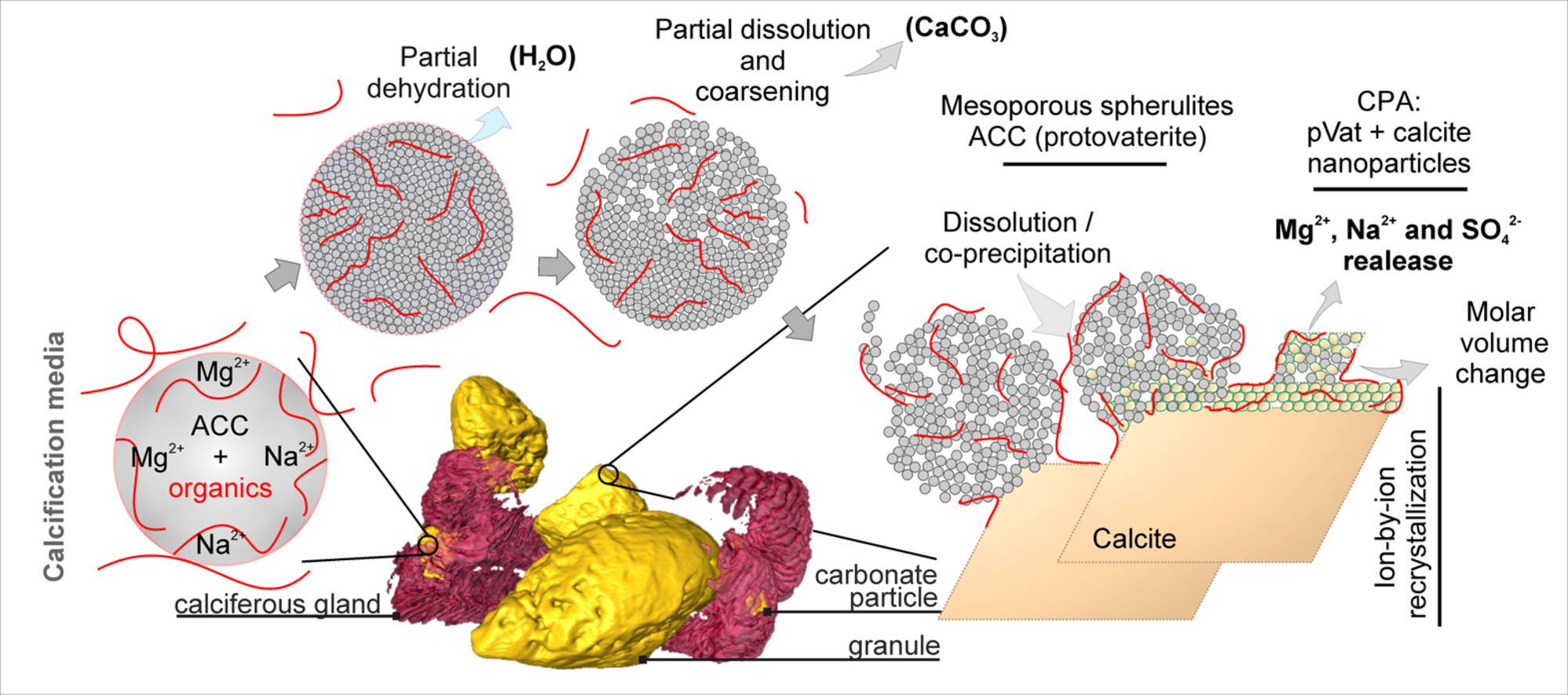
Figure: A new
model for the formation of earthworms
calcareous granules. Primarily amorphous
granules crystallize into calcite through the
amorphous particle attachment and the
ion-by-ion classical growth mechanism; see
from left to right. In the lower center, a
tomographic image of the glands forming the
granules (red) and the granules themselves
(yellow) in the body of an earthworm.
Understanding
the mechanisms of nucleation,
stabilization and aggregation of amorphous calcium carbonate
(ACC) and factors controlling its
further transformation into crystalline phases
is fundamental for elucidation of biogenic mineralization.
Some species of earthworms create
millimeter-sized calcareous granules from
amorphous calcium carbonate, which crystallize to a more
stable mineral phase (mostly
calcite). This study investigates the
mechanisms of ACC stabilization by the
incorporation of trace elements, like
manganese, and the ulterior precipitation of
calcareous granules by a coupled process of
amorphous particle attachment and ion-by-ion
growth. The study highlights also potential
threat that chemical pollution of soil poses
to the normal development of earthworm
granules.
|
2023.04.03.
PUBLICATION — Machalski, M.,
Olszewska-Nejbert, D. and Wilmsen, M. 2023.
Stratigraphy of the Albian–Cenomanian (Cretaceous)
phosphorite interval in central Poland: a
reappraisal. Acta Geologica Polonica, 73
(1), 1–31. Warszawa, doi:
10.24425/agp.2022.142650
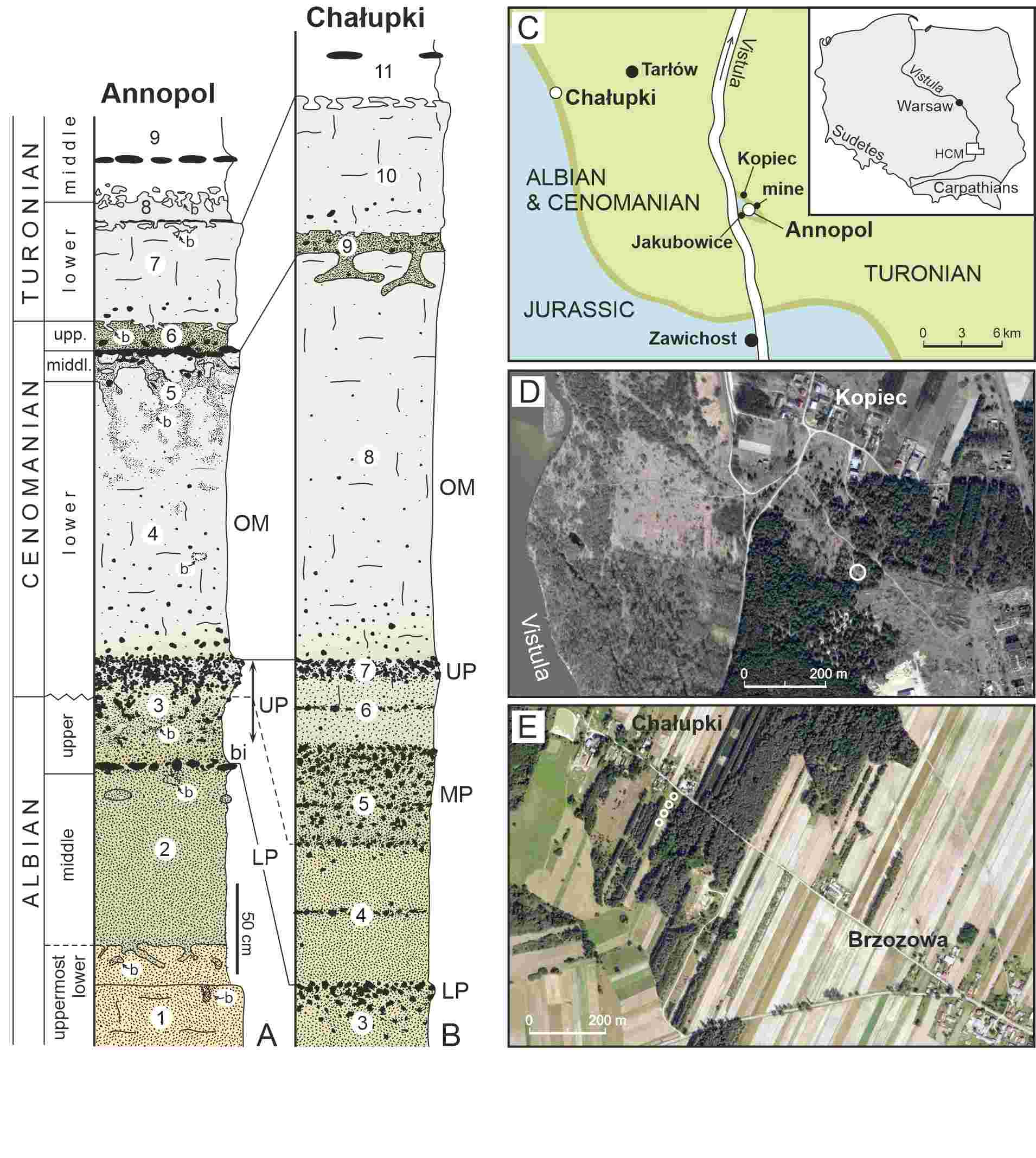
Illustration:
Sections, stratigraphy and location of key
sites of Cretaceous phosphorites at Annopol
and Chałupki (Machalski et al. 2023).
The Albian and Cenomanian ( Cretaceous) deposits at
Annopol in Central
Poland have been famous for their wealth of phosphates and fossils.
By 1970, over a million tons of phosphate rock
had been mined here for production of
fertilizers, and recently the phosphorites
have been investigated as a potential source
of rare earth elements
(REE). In the years 2008–2016, thousands of
remains of marine animals were excavated at
Annopol, including bones and teeth of giant
marine reptiles. The paper presents a new stratigraphical
interpretation of the phosphorite interval and
its implications for our understanding of this
type of fossil accumulations.
|
2023.03.31. PUBLICATION
— Gorzelak P., Kołbuk D., Stolarski J., Bącal P.,
Januszewicz B., Duda P., Środek D., Brachaniec T.,
Salamon M.A., 2023. A Devonian crinoid with a
diamond microlattice. Proceedings of The Royal
Society B 290: 20230092, doi:
10.1098/rspb.2023.0092
It
has been recently discovered that some species
of modern starfish form a calcite skeleton with a
triply periodic trabecular microstructure
resembling the atomic structure of diamond,
composed of a network of hexagonally ordered
four-armed tetrapods, which gives
them extraordinary mechanical strength,
optimum packing in space, and minimum material
expenditure. We described a similar
microstructure in a Devonian crinoid from the Holy Cross Mountains.
Such a highly ordered microstructure,
additionally enriched in magnesium, might have
developed in these echinoderms in response
to increased predation pressure.
Figure:
The atomic structure of a diamond composed
of interconnected tetrahedrons and a
breakwater made of wave-dissipating
tetrapods juxtaposed with the
microstructure of Recent starfish and
Devonian crinoids.
|
2023.03.24. PUBLICATION — Arrigoni, R, Stolarski, J., Terraneo, T.I.,
Huang, D, Hoeksema, B.W., Berumen, M.L., Payri, C.,
Montano, S., Benzoni, F. 2023. Phylogenetics and
taxonomy of the
scleractinian coral family Euphylliidae. Contributions to Zoology
1–42, doi: 10.1163/18759866-bja10041
The family Euphylliidae consists of
reef-building scleractinian corals
distributed across the Indo-Pacific. The
published comprehensive study on phylogeny and
taxonomy of Euphylliidae combines molecular
and morphological data (skeleton and polyp
morphology). All analysed genera, i.e., Ctenella,
Euphyllia, Fimbriaphyllia, Galaxea, and
Gyrosmilia, were reciprocally monophyletic based on
molecular results. Coeloseris was
nested within the family and, therefore, is formally moved into
Euphylliidae. This study further demonstrated
that a phylogenetic classification of
scleractinian corals can be achieved by
applying a combined morpho- molecular approach. Figure:
Many euphylliids (like Galaxea, see
photograph) have a squamate texture of the
surface of skeletal elements, but such
texture is present among agariciids and
acroporids as well.
|
2023.03.22.
PUBLICATION — López-Torres S., Bhagat R.,
Bertrand O. C., Silcox M. T., and Fostowicz-Frelik Ł. 2023.
Locomotor behavior and hearing sensitivity in an
early lagomorph reconstructed from the bony
labyrinth. Ecology and Evolution 13
(3), 9890. doi: 10.1002/ece3.9890
The structure of
the inner ear in mammals is
highly informative with respect to locomotor agility and
hearing sensitivity. In our paper for the
first time we studied the early evolutionary
stage of the lagomorph hearing and
balance organs. Based on the digital endocast
of the bony labyrinth (housing the inner ear
structures) of the North American lagomorph Megalagus
turgidus, early Oligocene in age, we
suggest that its hearing sensitivity and
agility were within the range of modern rabbits. Megalagus was
probably a woodland dweller and thus, less
agile than hares ( Lepus).
|
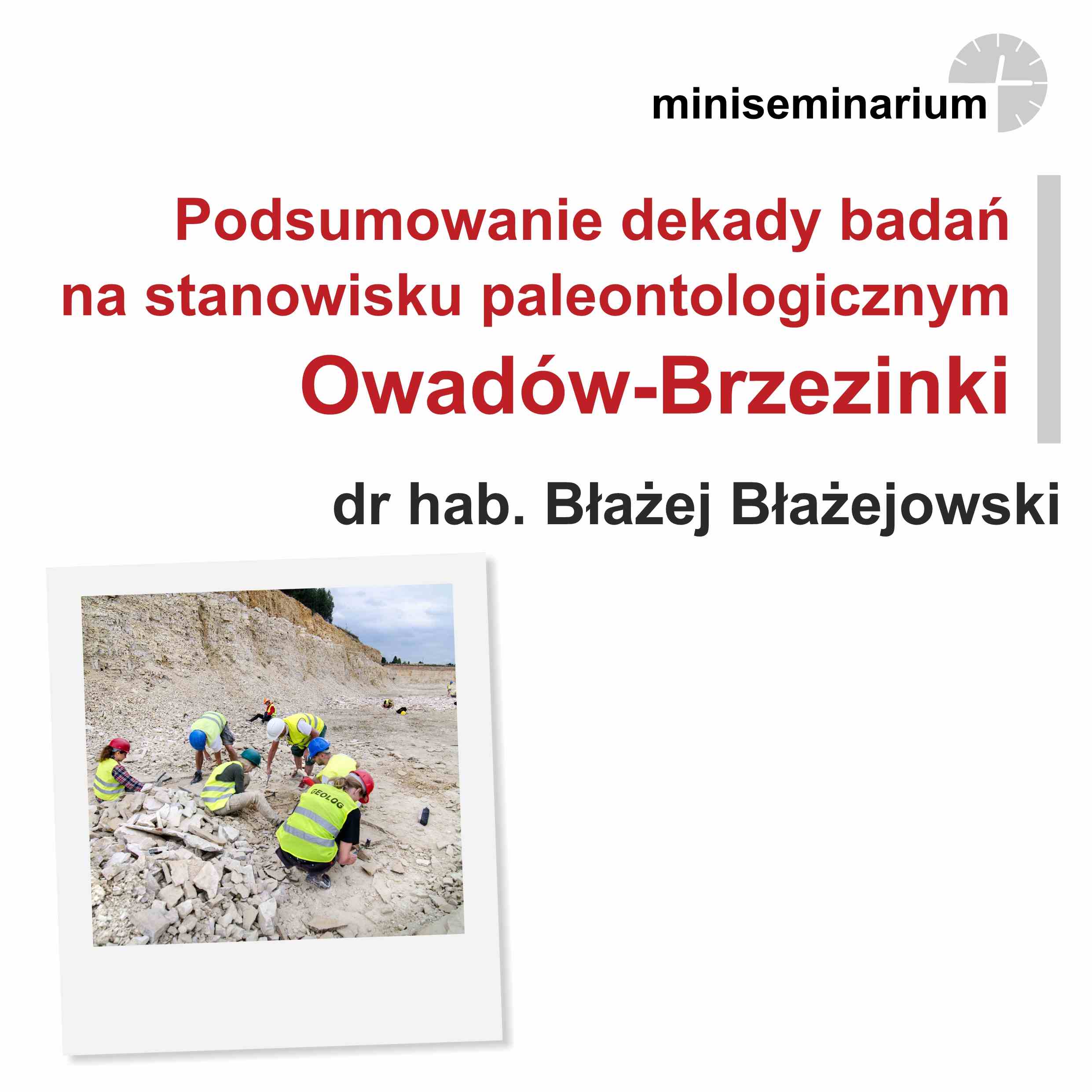 2023.03.21.
Miniseminar 2023.03.21.
Miniseminar
27 th
March 2023 r. (Monday), 11:00 a.m., dr hab.
Błażej Błażejowski will give a miniseminar:
"Podsumowanie dekady badań na stanowisku
paleontologicznym Owadów-Brzezinki".
|
2023.03.21.
PUBLICATION — Surmik D., Słowiak-Morkovina J., Szczygielski T., Wojtyniak M.,
Środek D., Dulski M., Balin K., Krzykawski T.,
Pawlicki R. (2023) The first record of fossilized
soft parts in ossified tendons and implications for
the understanding of tendon mineralization, Zoological Journal
of the Linnean Society: zlad001, doi:
10.1093/zoolinnean/zlad001
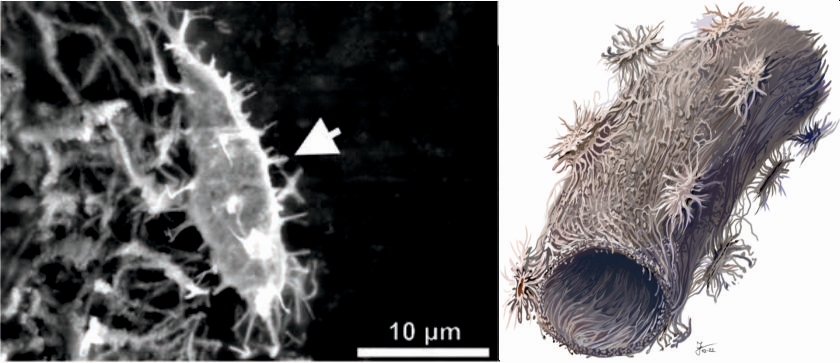
Illustration:
On the left SEM image showing an
osteocyte-like cell. On the right restoration
of a blood vessel of an
remontowanie with cells on its surface based
on the scanning microscopy imaging.
Illustration: Jakub Zalewski.
Tendons are elements
connecting muscles and bones. In most
vertebrates, they are flexible and elastic but
in dinosaurs (including birds) some of them ossify. The excellent
state of preservation of ossified tendons of
three dinosaurs allowed discovery of
fossilized soft tissues. Structures resembling
fibril bundles, blood
vessels, and bone cells were identified,
resembling those present in ossified turkey
tendons. The research indicates that dinosaur
tendons ossified through metaplasia, i.e.,
mineralization of already differentiated soft
tissues.
|
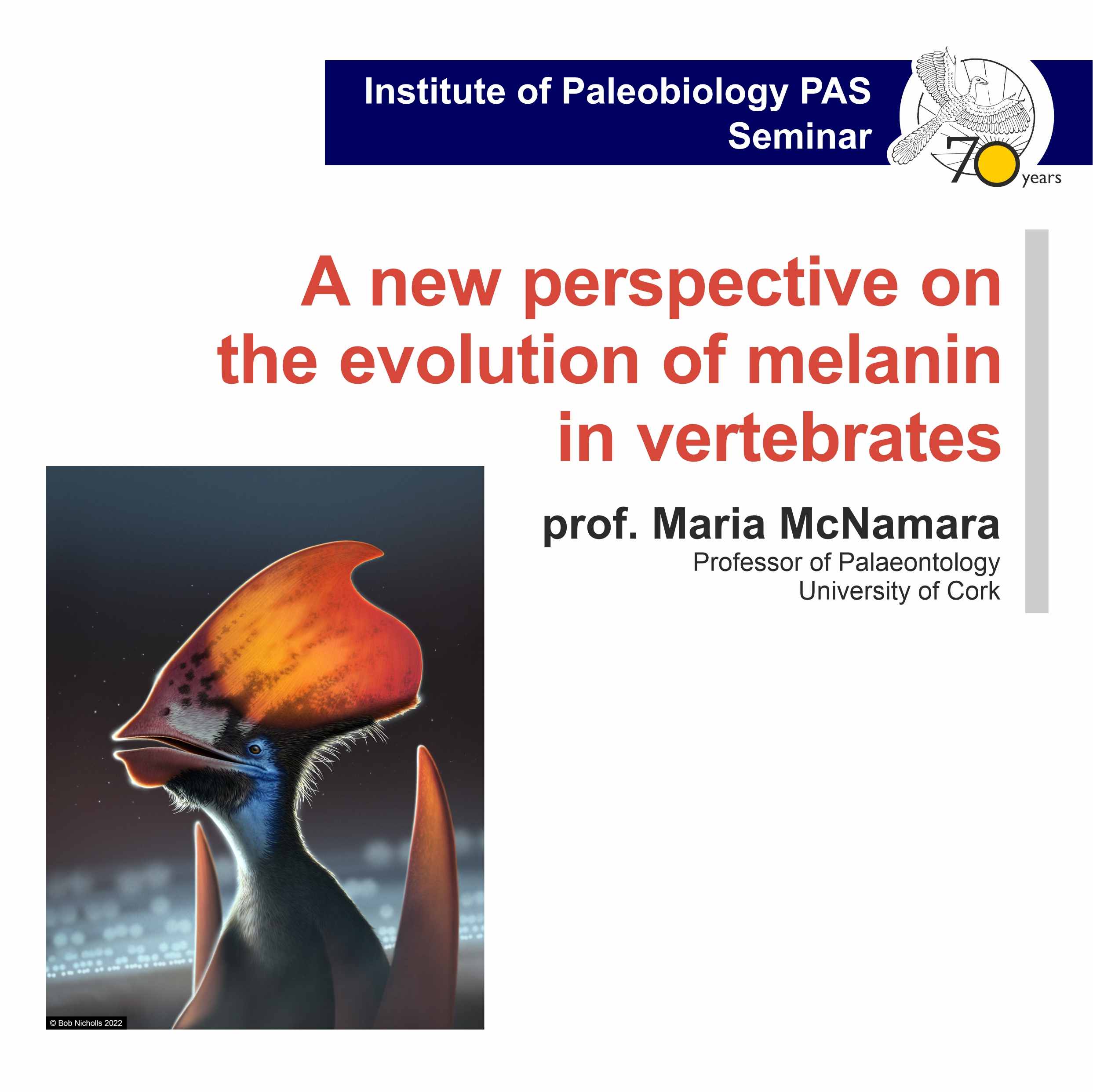 2023.03.17.
New date of the Seminar 2023.03.17.
New date of the Seminar
23rd
March 2023 (Thursday), 11:00 a.m. (local
time in Warsaw), prof. Maria McNamara will
give a seminar: "A new perspective on the
evolution of melanin in vertebrates".
|
2023.03.15. PUBLICATION
— Bates D. E. B., Kirk† N. H. & Kozłowska A. 2023. —
Morphology and reconstruction of the retiolitines:
Silurian graptolites of the Paraplectograptus
lineage (Graptolithina). Comptes Rendus Palevol 22
(4): 45-57, doi: 10.5852/cr-palevol2023v22a4
Retiolitids
are one of the group of graptolites with collagenous skeleton
(rhabdosome) formed mostly by a network of
lists. In the paper the morphology of the
skeleton of the Paraplectograptus was
recognised thanks to 3D-preserved specimens
(430 million years old) from the Arctic Canada
and Poland and their detailed study under SEM. 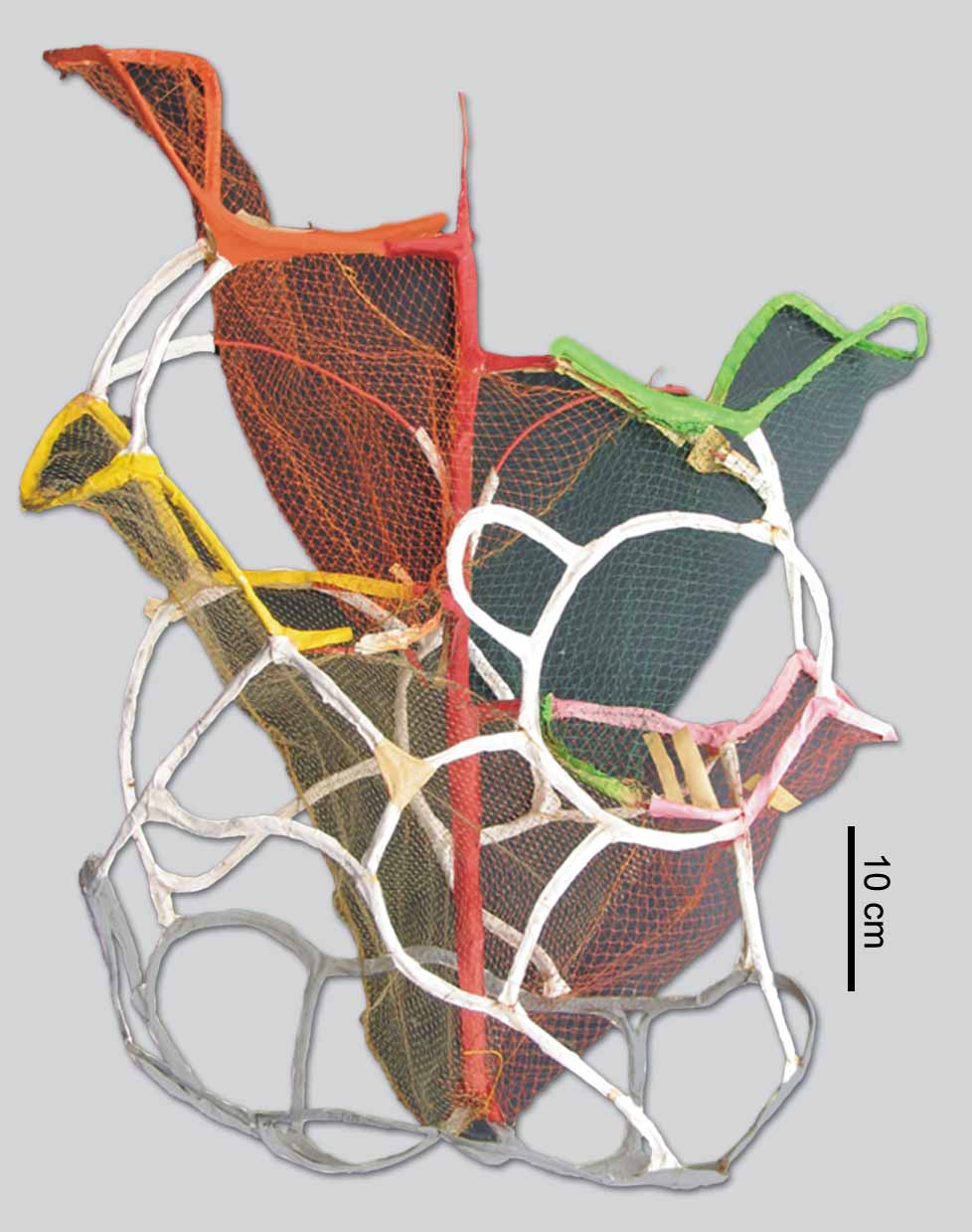 The thecal
fusellar wall was reconstructed despite its
fragmentary preservation. Paraplectograptus
is among the first retiolites showing some
morphological features that afterwards were
characteristic for all members of the group
after the lundgreni Event.
The presented models are by Nancy Kirk.
|
2023.03.13. PUBLICATION
— Stolarski, J., Drake, J.,
Coronado, I., Vieira, A.R., Radwańska, U.,
Heath-Heckman, E.A.C., Mazur, M., Guo, J., Meibom,
A. 2023. First paleoproteome study of fossil fish
otoliths and the pristine preservation of the
biomineral crystal host. Scientific Reports 13:3822,
doi: 10.1038/s41598-023-30537-8
Otoliths are calcium
carbonate components of the inner ear in teleost fish. Otolith
morphology and carbonate mineralogy is
influenced by proteins present in the
environment where biomineralization took
place. However, in the fossil record proteins
incorporated into biomineral structure are
mostly lost through diagenesis. The
published paper reports the presence of 11
fish-specific proteins in Miocene (over 14 Ma) phycid hake otoliths.
These fossil otoliths exhibit microscopic and
crystallographic features indistinguishable
from those of modern representatives.
Identification of identical proteins in modern
and fossil phycid hake otoliths implies a
highly conserved inner ear biomineralization
process through time.
|
2023.03.10. PUBLICATION — Błażejowski, B.,
Pszczółkowski, A., Grabowski, J., Wierzbowski, H.,
Deconinck, J. F., Olempska, E., Teodorski, A.,
Nawrocki, J. (2023). Integrated stratigraphy and
clay mineralogy of the Owadów–Brzezinki section
(Lower–Upper Tithonian transition, central Poland):
implications for correlations between the Boreal and
the Tethyan domains and palaeoclimate. Journal of the Geological
Society, Volume 180, Issue 2,.
doi:10.1144/jgs2022-073
The Owadów–Brzezinki
palaeontological site is a new Jurassic taphonomic window. A new
dating is presented. Uppermost Jurassic
shallow marine and lagoonal carbonate
deposits of the NW margin of the Holy Cross Mountains are
investigated. It was here that marine and
terrestrial faunas from various parts of the
present day’s Europe were meeting, namely from
the Boreal (today’s Arctic) and Subboreal
Provinces (today’s European Russia and
England), and periodically also from the
southern areas, including southern Germany and
the Tethys Ocean (through
the existing belt of the Štramberk-type coral reefs). Figure:
Paleogeographical map of Europe at the end
of Jurassic (acc. Błażejowski B.,
Hołda-Michalska A., Matyja B., Wierzbowski
A.).
|
2023.03.09. Professor Maria McNamara's seminar
- cancelled.
Dear Sirs, We would like to inform you that at the
last minute Prof. Maria McNamara has cancelled her
lecture due to health problems. We will inform you
of the new date soon.
|
2023.03.08. PUBLICATION — Lee S., Słowiak-Morkovina J. (2023)
The Resting Breathing Rate of the Dinosaur Plateosaurus
trossingensis via Conservation of Energy. The Physics Teacher 61,
166-169. doi: 10.1119/5.0077948
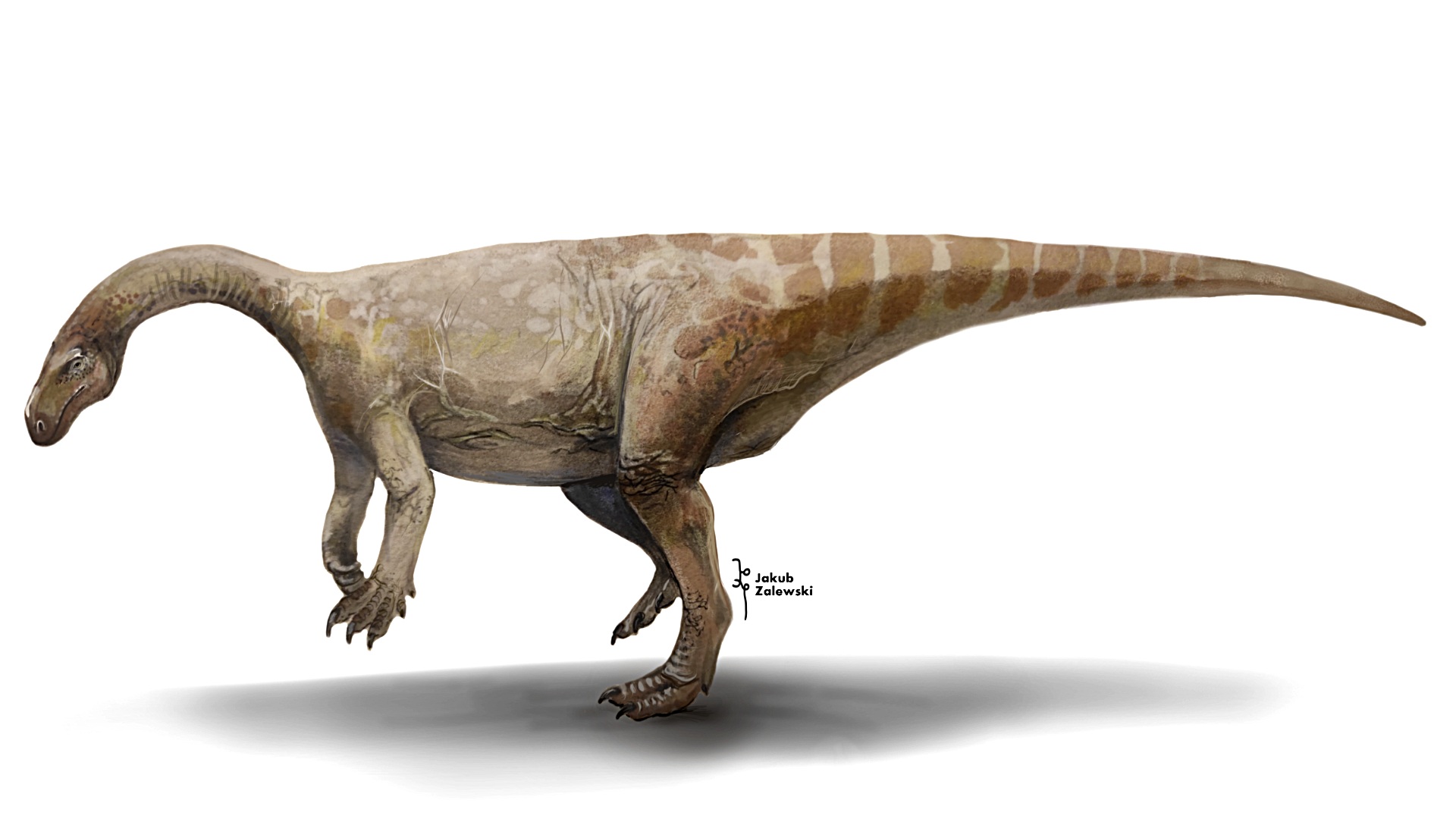
Illustration:
Life reconstruction of Plateosaurus
trossingensis.
Plateosaurus
trossingensis is one of the largest
herbivorous Late Triassic dinosaurs, numerous
fossils of which, including complete
skeletons, are known from Europe. Thanks to
this great fossil record, it is possible to
estimate the growth curve, body mass,
and even the tidal volume of this
dinosaur. Those data were used to calculate
the metabolism and the resting breathing rate. The
results revealed that the resting breathing
rate in P. trossingensis was 7 + 3
breaths per minute, about the same as the
modern rhinoceros.
|
2023.03.07. PUBLICATION — Bielak, K.,
Benkowska-Biernacka, D., Ptak, M., Stolarski, J. Kalka, M.,
Dobryszycki, P. 2023. Otolin-1, an otolith- and
otoconia-related protein, controls calcium carbonate
bioinspired mineralization. Biochimica et Biophysica Acta -
General Subjects 1867(5): 130327,
doi: 10.1016/j.bbagen.2023.130327
Formation of the
biomineral structures in the inner ear ( otoliths and smaller,
but having the same function otoconia) is
tightly linked to the formation of organic
matrix framework, among which the
otolin-1, a short collagen-like protein,
is one of its major components. The published
work examines the activity of recombinant fish
( Danio) and human
otolin-1 on calcium carbonate bioinspired
mineralization. Both proteins are embedded in
the core of CaCO3 crystals formed through
slow-diffusion mineralization process. Both of
them influence the morphology, but do not
cause the polymorphic change of
the mineral phase. The fish otolin-1
is also closely adhering to the crystal
surface. The results suggest that also in
natural biomineralization
environment, the otolin-1 is not a passive
scaffold but is directly involved in the
regulation of morphology of the resulting
calcium carbonate biocrystals.
|
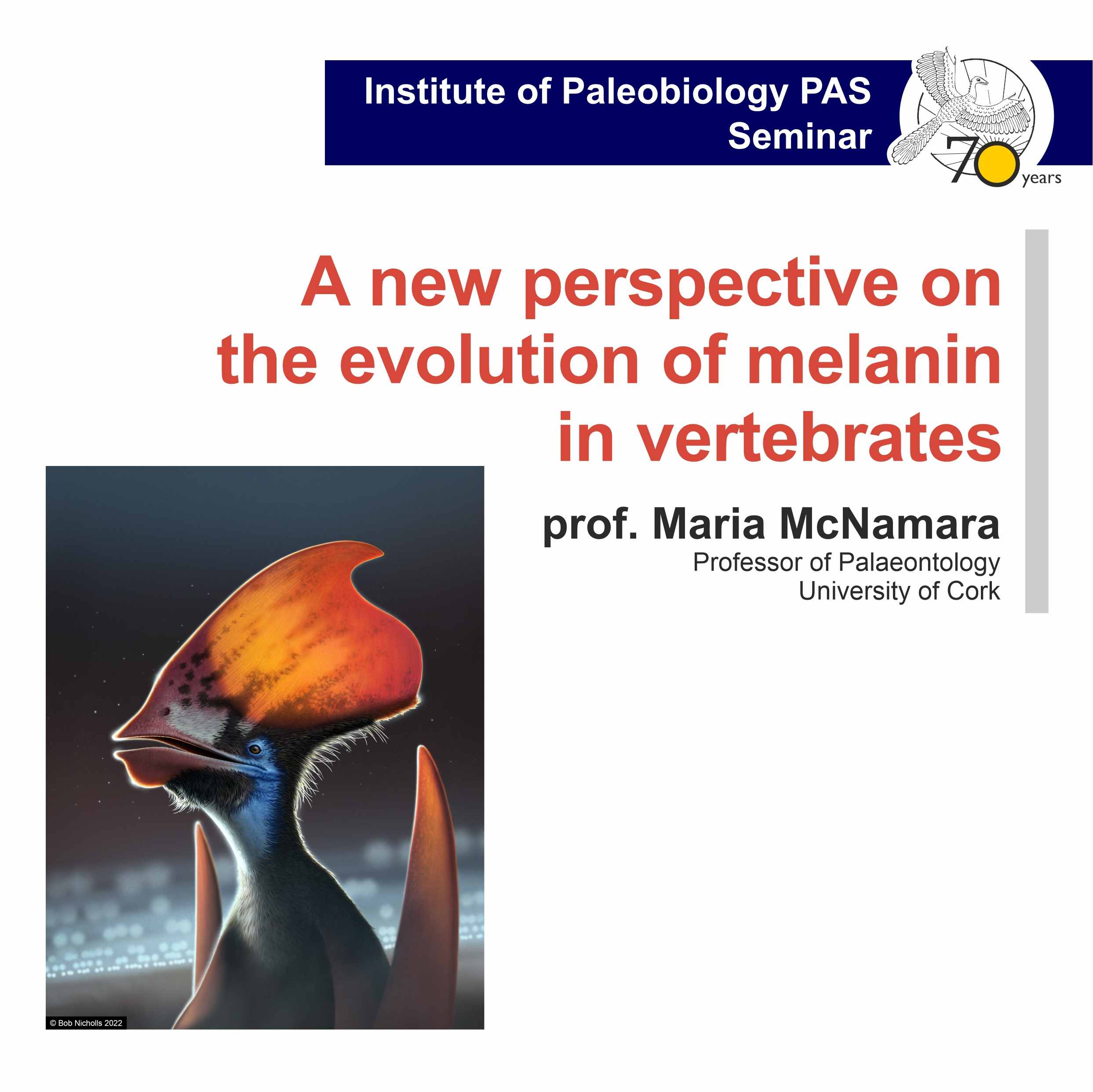 2023.02.24.
Seminar 2023.02.24.
Seminar
9th
March 2023 (Thursday), 11:00 a.m. (local
time in Warsaw), prof. Maria McNamara will
give a seminar: "A new perspective on the
evolution of melanin in vertebrates".
|
2023.02.24. PUBLICATION — Majewski, W., Szczuciński, W.,
and Gooday, A. J. 2023. Unique benthic foraminiferal
communities (stained) in diverse environments of
sub-Antarctic fjords, South Georgia, Biogeosciences, 20, 523–544.
doi:10.5194/bg-20-523-2023

Illustration:
Foraminifera from fjords of South Georgia and
a view towards glaciers in Antarctic Bay.
Foraminifera are
unicellular organism, which commonly inhabit
seafloor. They are often used for
paleoenvironmental studies, especially in
polar regions. We studied foraminifera living
in the fjords of South Georgia, a
sub-Antarctic island sensitive to climate
change. As conditions in water and on the
seafloor vary, different associations of these
microorganisms dominate in different parts of
fjords. Assemblages in inner and middle parts
of fjords seem endemic to South
Georgia, but they may become widespread with
anticipated warming. Our results are important
for interpreting fossil records and
monitoring future change.
|
2023.02.15.
14th Symposium of the International Fossil Coral
and Reef Society (IFCRS)

Institute of
Paleobiology, Polish Academy of Sciences
(organiser) and University of Warsaw, Faculty
of Geology, Adam Mickiewicz University Poznań,
Faculty of Geographical and Geological
Sciences, and Jagiellonian University in
Kraków, Faculty of Geography and Geology
(co-organisers) cordially invite you to
participate in the 14th Symposium of the
International Fossil Coral and Reef Society
(IFCRS). The conference will be held in Poland
(Warsaw, Chęciny (European Centre for
Geological Education), Kraków), September
10-16, 2023. All details are available
on the conference website: https://fossilcoralreefs.com/
which will be regularly updated.
IFCRS symposia are important avenues for
researchers studying fossil corals and reefs.
Today’s reef environments are some of the most
vulnerable marine ecosystems to changing
climatic conditions. Climate change models
predict the extinction of most of today’s
known shallow-water reef environments by the
end of 21st century. However, recent research
suggests that not all corals have the same
potential to survive change, and the key to
understanding these differences lies in their
geological and evolutionary past. The leading
theme of the conference will be the study of
corals from mesophotic and deep-water
environments (motto: “Going deeper“), as these
environments are now potential coral refugia
in the event of extinction of shallow-water
reefs. The fossil mesophotic reef environments
in Poland are well understood and represent
the first preserved reefs of modern type in
the world.
|
2023.02.15.
The 15th International Jurassica Conference
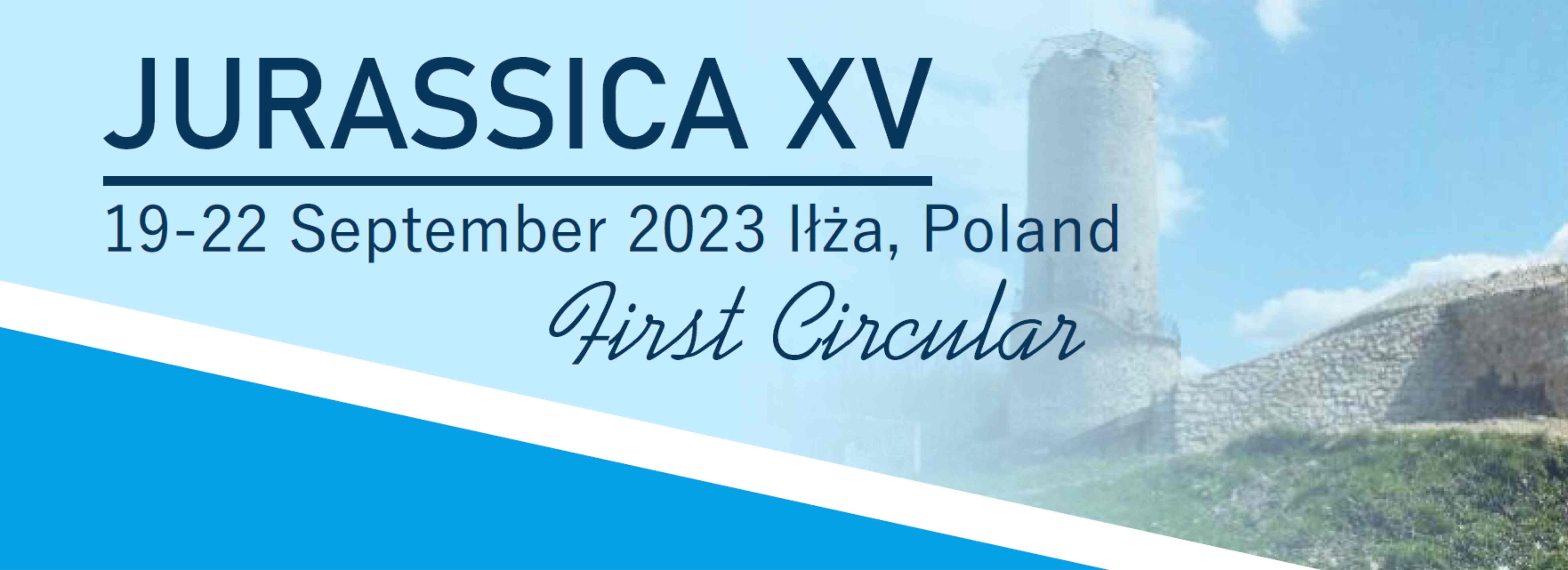
The Polish
Geological Institute ‒ National Research
Institute, the Institute of Paleobiology of
the Polish Academy of Sciences, the State
Geological Institute of Dionýz Štúr in
Bratislava and the Community of Iłża are
pleased to announce the forthcoming 15th
International Jurassica Conference held in the
City of Iłża (Central Poland) on the 19-22
September 2023. For information on the
conference, see Circular.
The Jurassica conference is open to all
geologists who deal with the Jurassic system
as well as Triassic/Jurassic and
Jurassic/Cretaceous boundary deposits. The
conference is designated to exchange novel
ideas and discoveries and to stimulate
discussions on crucial aspects of Jurassic
stratigraphy, GSSPs, sedimentology,
geochemistry, palaeontology, tectonics,
palaeomagnetism and geotourism. The meeting
additionally offers a forum for presentation
of study results of young researchers and PhD
students on specific areas of Jurassic
geology.
Apart from the presentation of scientific
reports, during the "Jurassica XV" conference,
will also be organized field trips. The
excursions and presented issues will be
devoted to the shallow-water Upper Jurassic
deposits of the north-eastern margin of the
Holy Cross Mountains containing diverse faunal
assemblages.
|
|
2023.02.13. PUBLICATION — Halamski, A.T. 2022. Middle
Devonian biota and environments of the Łysogóry
Region (Poland): Introduction. Annales Societatis Geologorum
Poloniae, 92 (4): 317–321.
Halamski, A.T., Baliński, A., Racki, G.,
Amler, M.R.W., Basse, M., Denayer, J., Dubicka,
Z., Filipiak, P., Kondas, M., Krawczyński, W.,
Mieszkowski, R., Narkiewicz, K., Olempska, E., Wrzołek, T.,
Wyse
Jackson, P.N., Zapalski, M.K., Zatoń, M. &
Kozłowski, W., 2022. The pre-Taghanic (Givetian,
Middle Devonian) ecosystems of Miłoszów (Holy
Cross Mts, Poland). Annales Societatis Geologorum
Poloniae, 92 (4): 323–379.
Racki, G., Wójcik, K., Halamski, A.T. &
Narkiewicz, M. 2022. Middle Devonian Skały
Formation in the
Holy Cross Mountains (Poland) – formal description
and subdivision based on new field data. Annales Societatis Geologorum
Poloniae, 92 (4): 425–444.
Woźniak, P., Halamski, A.T. & Racki,
G. 2022. Cyclic ecological replacement of
brachiopod
assemblages in the top-Eifelian Dobruchna
Brachiopod Shale Member (Skały Formation) of the
Holy Cross Mountains (Poland). Annales Societatis Geologorum
Poloniae, 92 (4): 445–463.
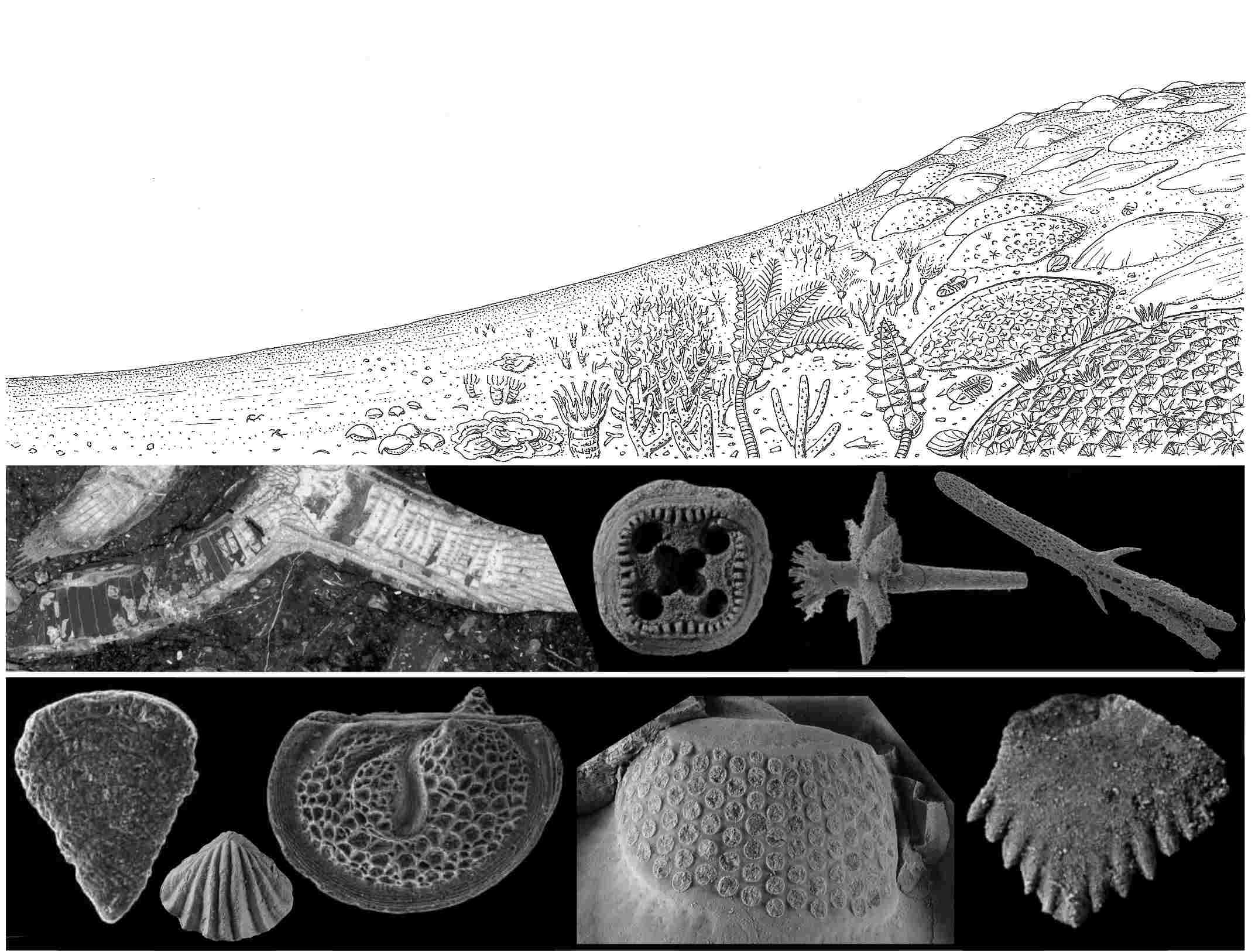
A pictorial
reconstruction of the Middle Devonian
(Givetian) seafloor at Miłoszów (compare Halamski et al., 2022,
fig. 27) with small patch reefs in the
shallower part and a brachiopod meadow in the
deeper part (drawing by Bogusław Waksmundzki).
The photographs show selected inhabitants of
the Miłoszów ecosystems. Top row: left to
right rugosan coral Thamnophyllum
(cross-section), stem element (columnal) of an
unidentified crinoid (see lily), spicule of an
octactinellid sponge, and an anal tooth of the
holothurian (see cucumber) Devonothyonites;
not to scale (compare Halamski et al.,
2022, figs 12, 13, 23, 24). Bottom row:
left to right foraminifer Semitextularia,
brachiopod Pentamerella, ostracod Kozlowskiella,
trilobite Hypsipariops (enlargement of
an eye), and a skeletal element (goniodont) of
an unidentified ophiocistoid (extinct class of
echinoderms); not to scale (compare Halamski et al.,
2022, figs 11, 19 20, 22, 23).
A special issue of the Annales Societatis
Geologorum Poloniae, guest edited by Adam T. Halamski and
entitled „Middle
Devonian biota and environments of the Łysogóry
Region (Poland)”, has been published. Six
papers in this special issue are authored by 27
scientists from four countries (including three
persons from IPal); generalities about this
project can be found in the preface.
We investigated the biota (all living organisms)
of the Skały Formation, a stratigraphic unit
corresponding to sediments formed in the Devonian period, more
exactly about 386–382 million years ago.
Lithological, geochemical, and palaeontological
data collected at Miłoszów ( Holy Cross Mts., Poland)
served for reconstructing a Middle
Devonian ecosystem. 200 species of
marine organisms are recorded, among which brachiopods with 68 species
are the most diversified, followed by echinoderms and bryozoans. For the first
time a detailed palaeoecological reconstruction of
one of the most famous localities in Poland, the
so-called brachiopod shale at Skały,
has been presented. We explored the succession of
communities, or, in other words, we showed which
brachiopod species had genuinely co-existed the sea located in the area of the
present-day Holy Cross Mountains, and which
species had followed one another.
We concluded that the exceptionally rich biota of
the Skały Formation corresponds to a period of
particularly favourable conditions for marine
organisms between the so-called Kačák Event about 386
million years ago and the Taghanic Event about 381 million
years ago.
|
2023.02.02. PUBLICATION — Calábková, G.,
Březina, J., Nosek, V. & D. Madzia. 2023. Synapsid
tracks with skin impressions illuminate the
terrestrial tetrapod diversity in the earliest
Permian of
equatorial Pangea. Scientific Reports 13:
1130. doi:10.1038/s41598-023-27939-z
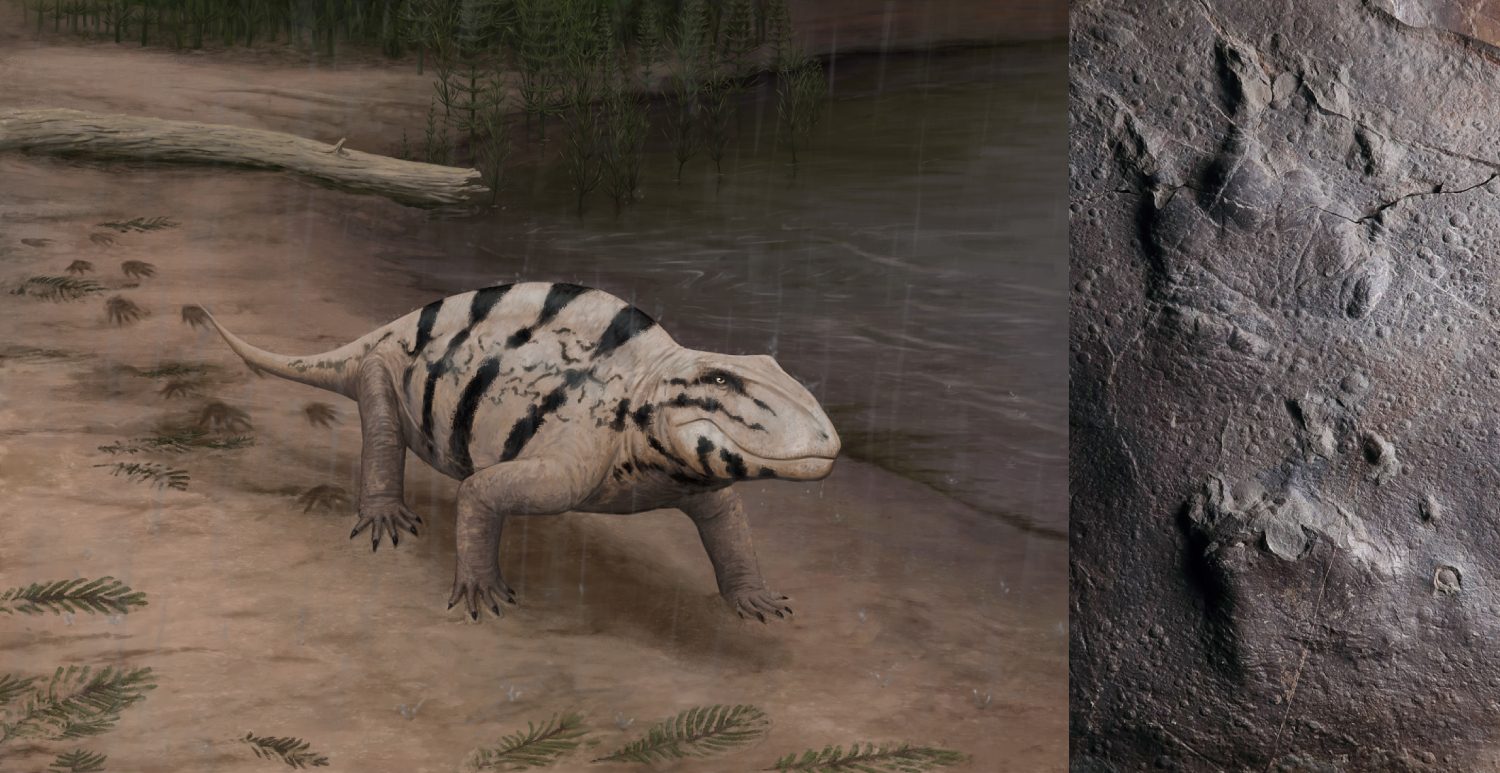
Reconstruction: Edyta Felcyn-Kowalska
Lower Permian deposits of the
Boskovice Basin in Moravia (Czech Republic)
have long been renowned for extraordinarily
abundant specimens of discosauriscid seymouriamorphs. The
only other tetrapods from the
strata are represented by rare temnospondyls. The new
study provides the first evidence of
early-diverging synapsids from the
Permian of the Czech Republic. The material is
composed of well-preserved isolated tracks,
manus-pes couples, and a slab with trackways
composed of approximately 20 tracks in at
least four different directions. The
best-preserved specimen further shows rare
skin impressions, which have not been observed
from the hands or feet of early-diverging
mammal-line amniotes before. The new
material adds to the scarce record of synapsids from the
Carboniferous/Permian transitional interval of
equatorial Pangea.
|
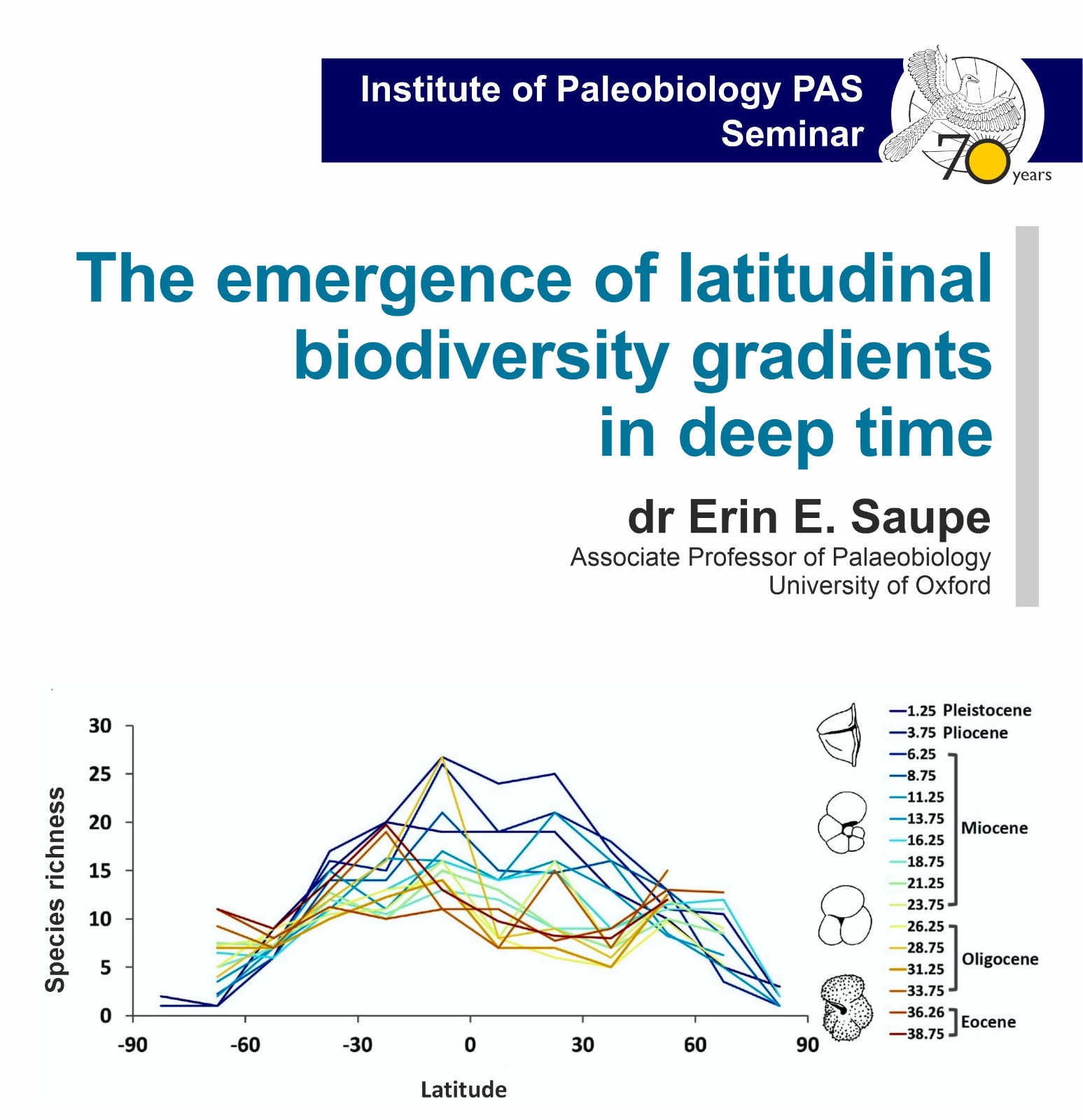 2023.02.01.
Seminar 2023.02.01.
Seminar
1st
February 2023 (Wednesday), 11:00 a.m., dr
Erin E. Saupe will give a miniseminar:
"The emergence of latitudinal biodiversity
gradients in deep time".
|
2023.01.19. PUBLICATION — Surmik, D., Szczygielski, T., Słowiak-Morkovina, J., Sander,
M.,
Rothschild, B., Duda, P., & Klein, N. (2023).
Bone abnormalities in the middle Anisian marine
sauropsids from Winterswijk. Journal of Morphology, 284,
e21550. doi:10.1002/jmor.21550
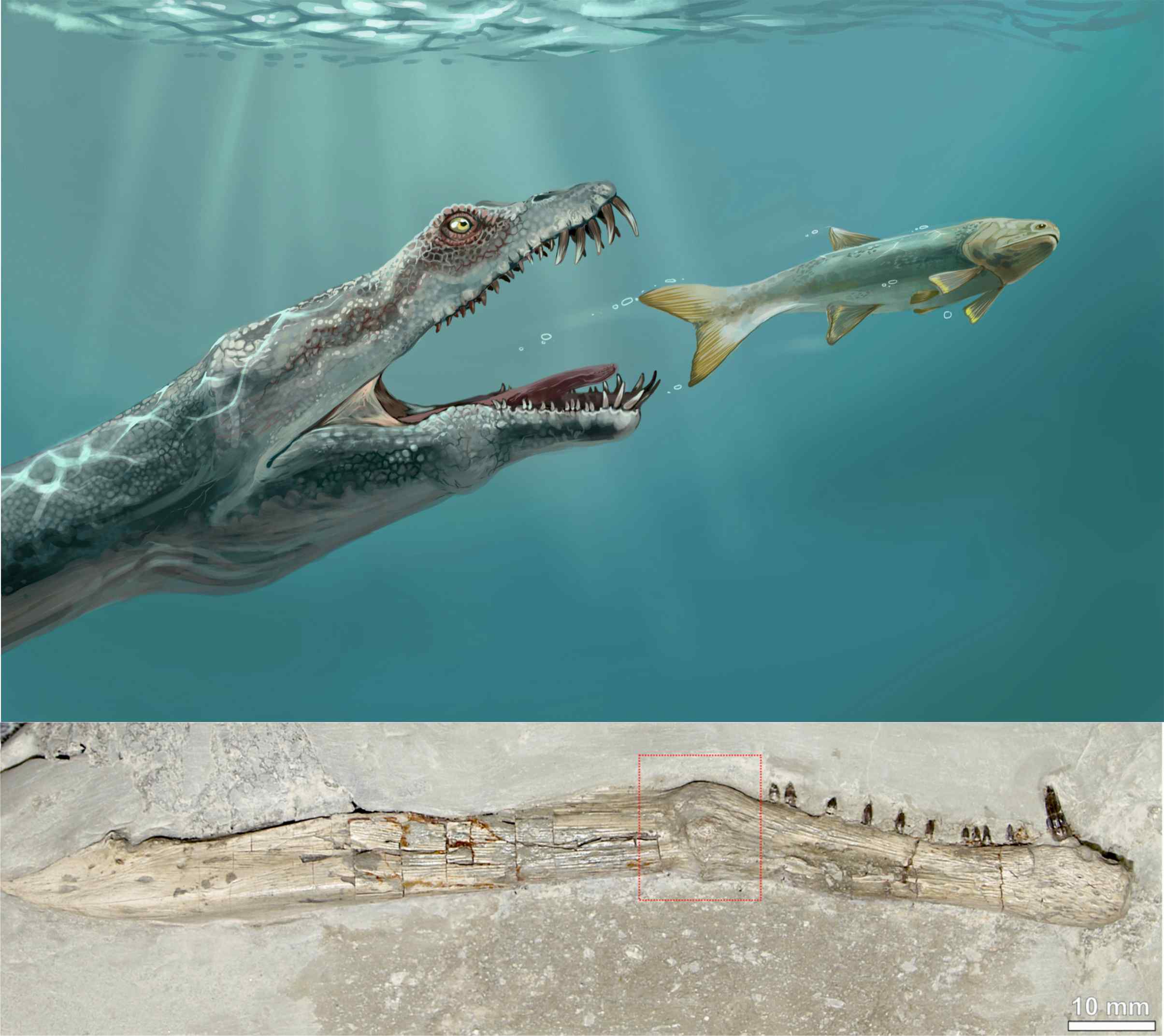
The
illustration shows the eosauropterygian cf. Notosaurus
marchicus with mandible which bears
signs of healed fracture. Despite the broken
jaw, the animal lived on, what is indicated by
the fact that the fracture healed. Below, a
photograph of the fossilized mandible, the
helaed fracture is marked.Illustrator: Jakub
Zalewski.
The Vossenveld
Formation cropping out near Winterswijk in the
Netherlands is well known because of its rich
Middle Triassic marine
reptile fauna assemblage. The aim of the study
was to detect and examine bones with unusual
shapes in order to identify the causes of
their deformation, i.e., taphonomic,
traumatic, or related to illness. The unusual,
kinked shape of a sauropterygian humerus
appears to result from taphonomic processes. Pathological changes
were identified on a sauropterygian rib
(osteofibrous dysplasia), large bone of
uncertain identity (unusual coossification),
and on the mandible of cf. Notosaurus
marchicus (healed fracture). Despite
hundreds of fossilized bones of marine
reptiles found in Winterswijk, only few of
them preserve pathologies, what may mean that
sick or wounded individuals were quickly
eliminated from the population.
|
2023.01.05. PUBLICATION — Olempska E., Błażejowski B., Waloszek D.,
Maas A. 2023. Phosphatic bromalites and microfossils
from the Furongian (Cambrian) of northern Poland
(Baltica) and palaeobiological implications. Palaeogeography,
Palaeoclimatology, Palaeoecology, 610,
111350. doi:10.1016/j.palaeo.2022.111350
The Upper
Cambrian Słowińska Formation yielded minute
three-dimensionally preserved, phosphatic microfossils. Based on
shape and structure, two distinct types are
identified. The first type comprises sinuously
folded, coiled, or spiral string-shaped
objects interpreted as coprolites produced by benthic worms. The
second type of fossils comprises ellipsoidal
to spherical forms with a non-ornamented but
wrinkled surface. They are interpreted as
collapsed and deformed eggs or embryos lacking
the egg shell. We interpret this type as the
first evidence of eggs in the so-called Orsten-type
preservation, most likely belonging to phosphatocopid
crustaceans. The findings are a significant
contribution to our understanding of the
faunal composition in the Late Cambrian Sea
and demonstrates the potential for further
research on the phosphatic microfossils from
northern Poland ( Baltica).
|
|
|





